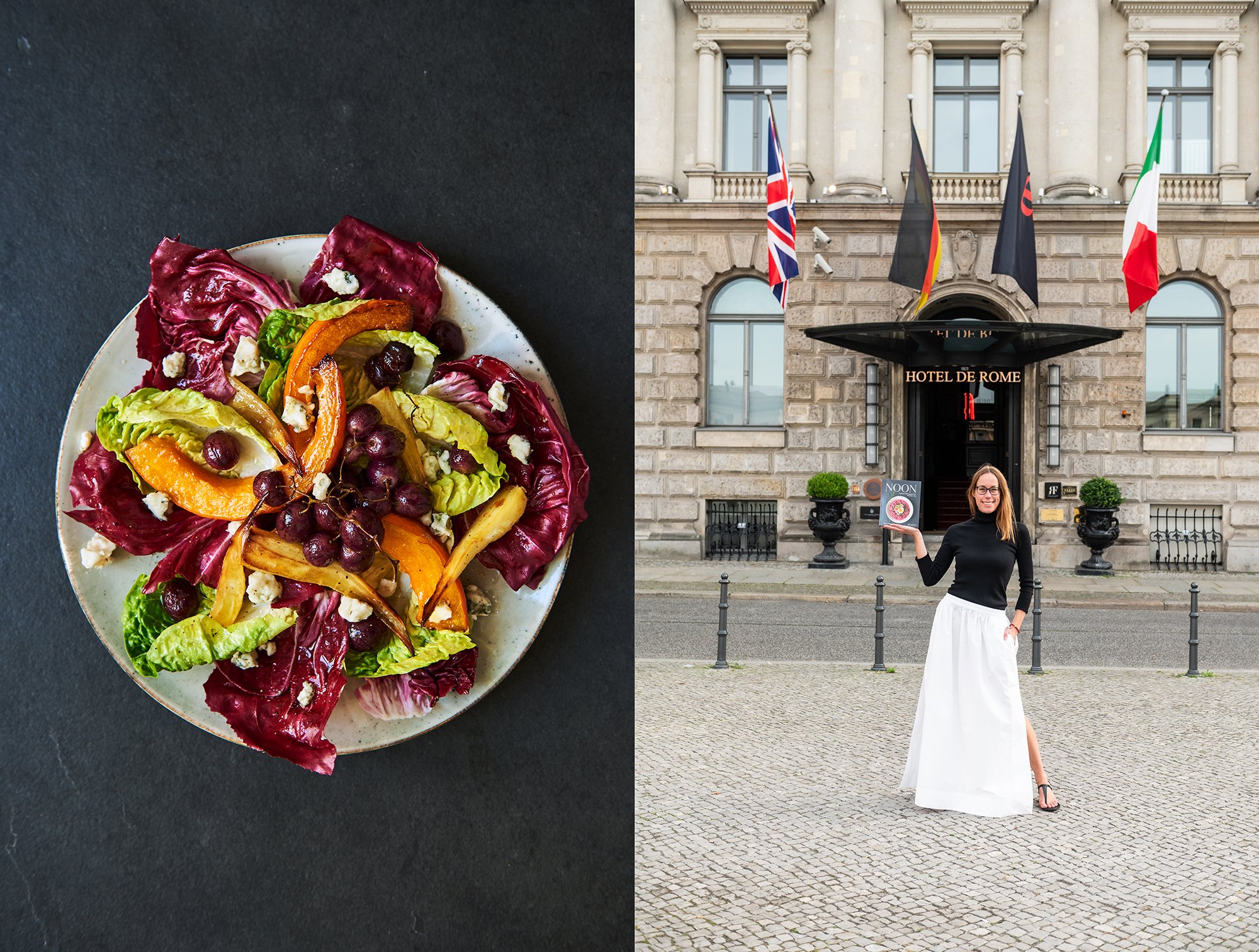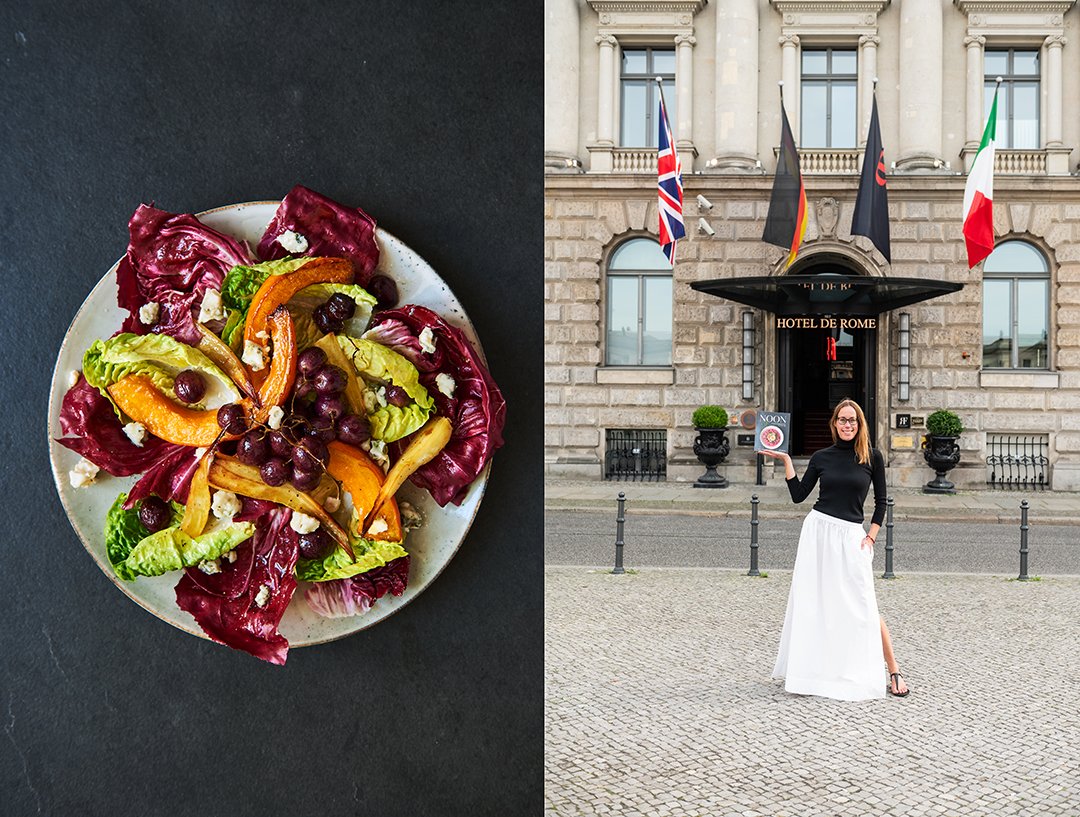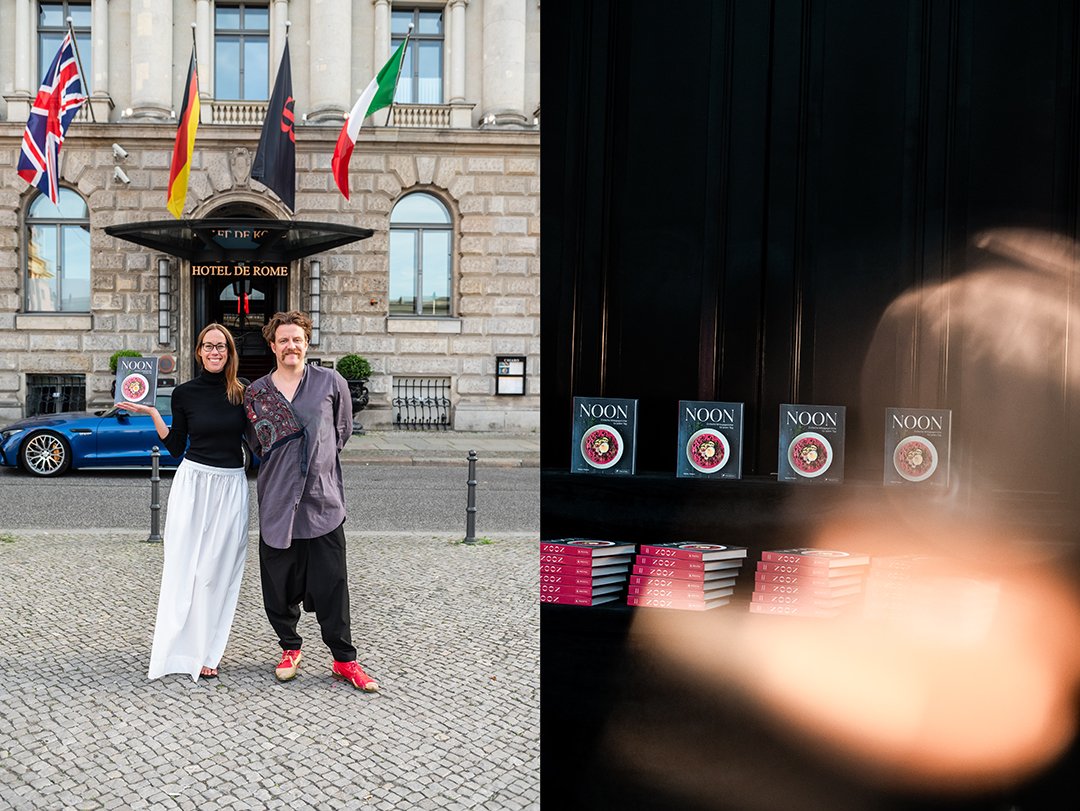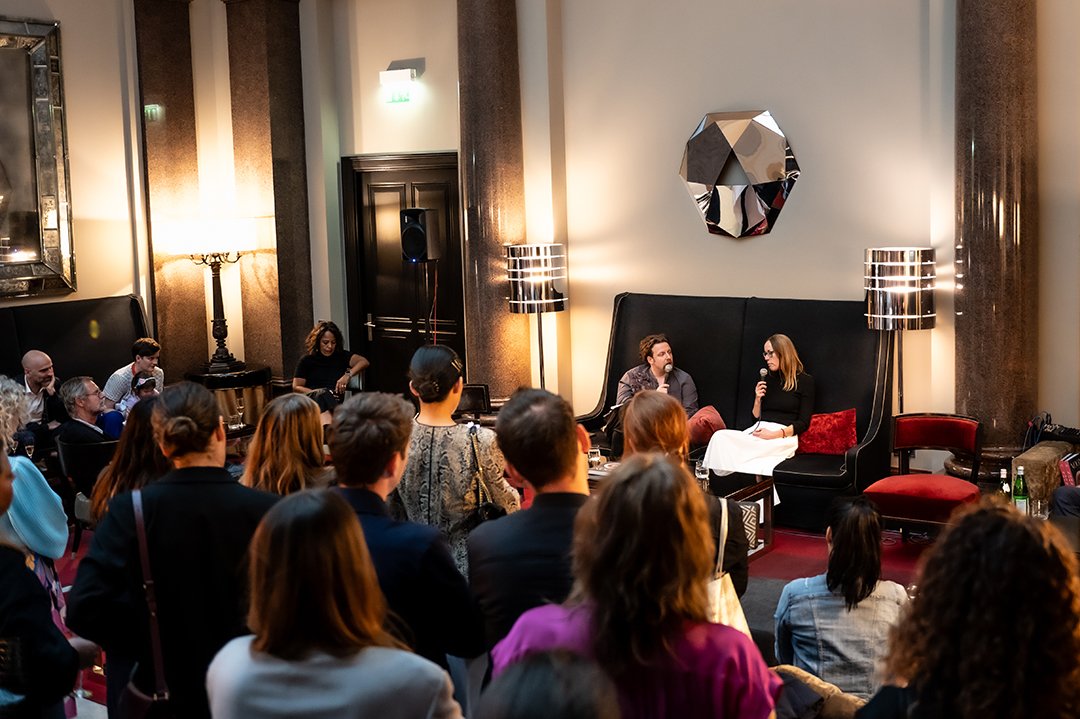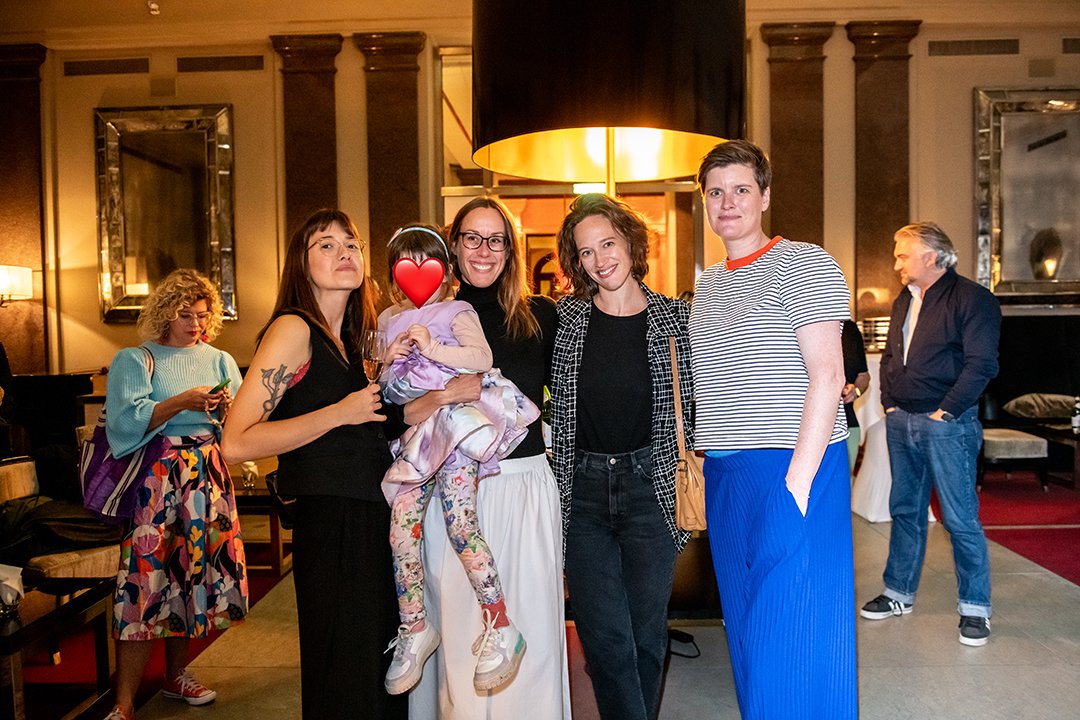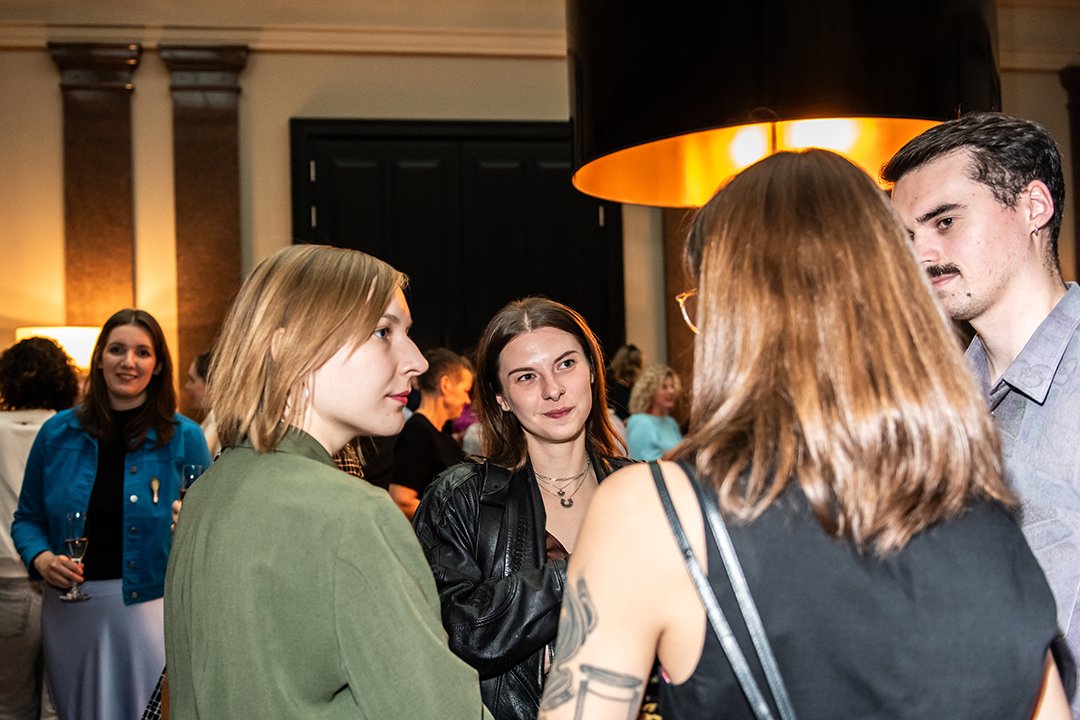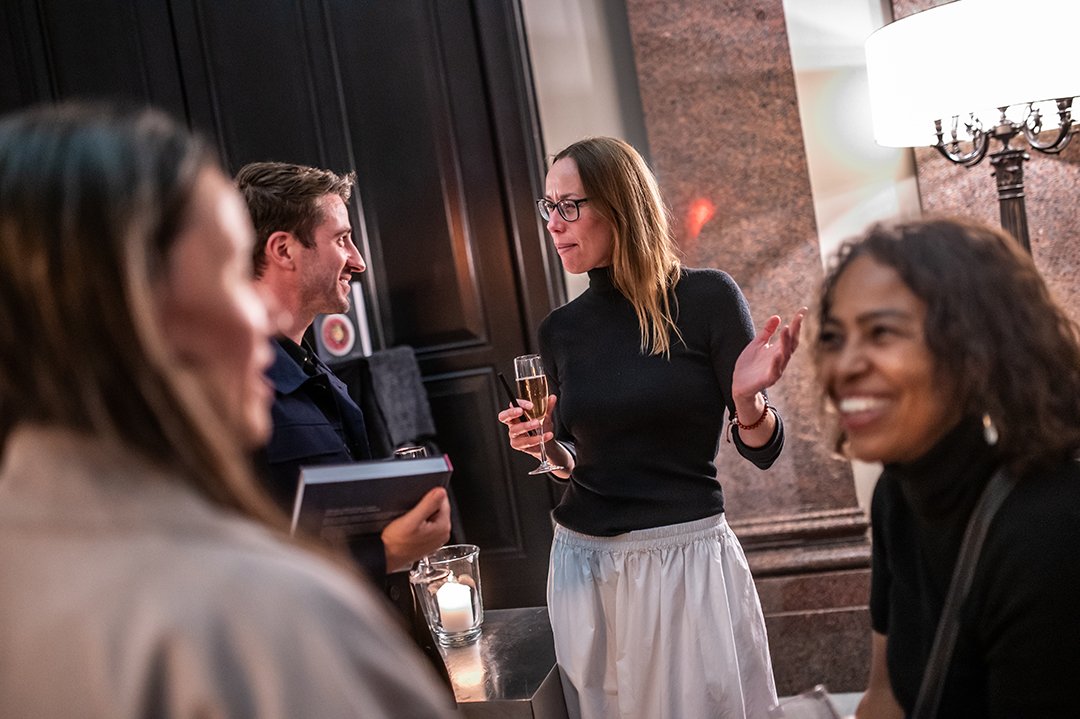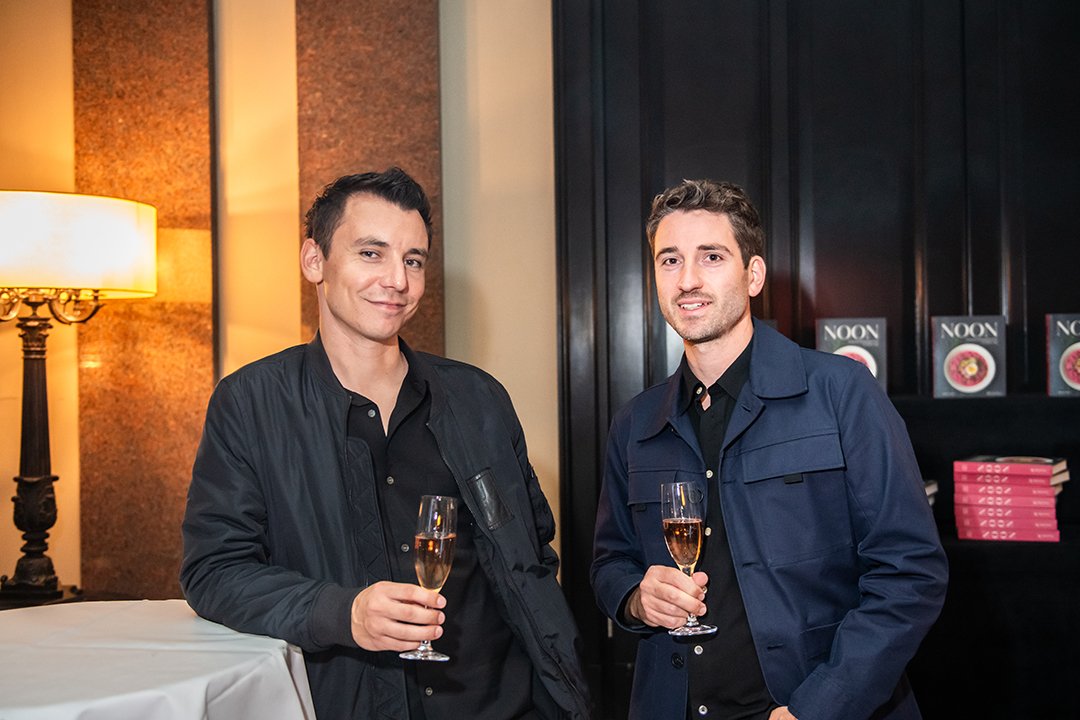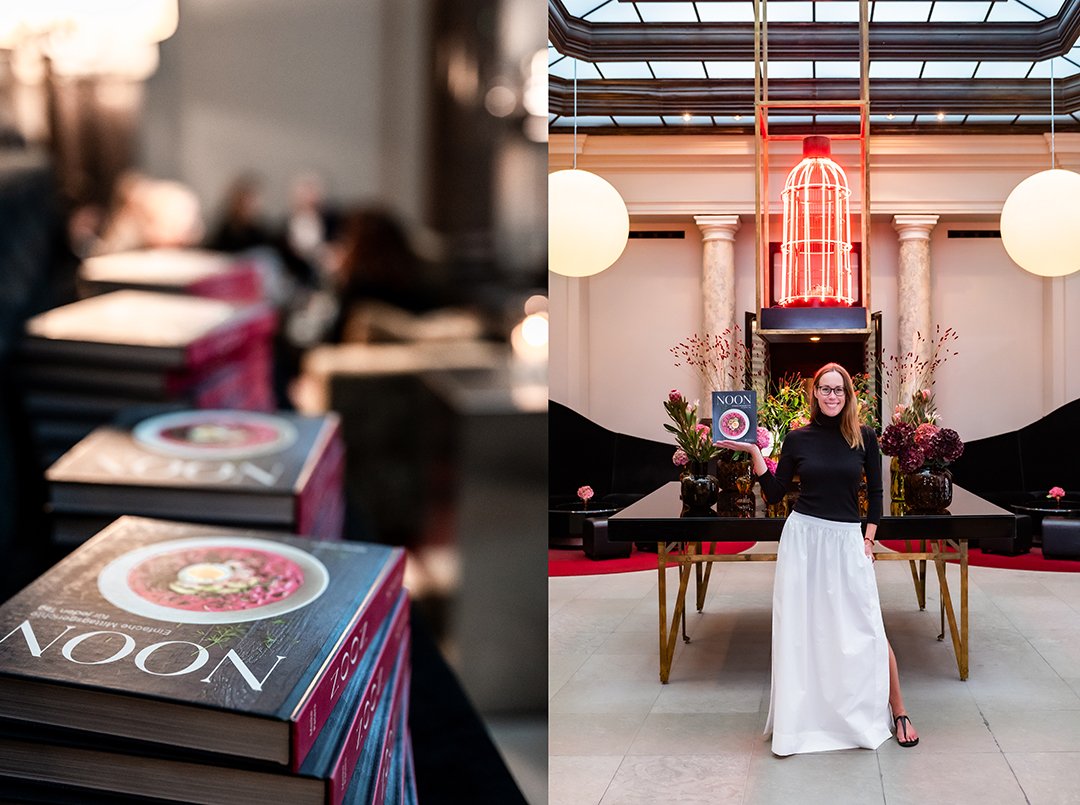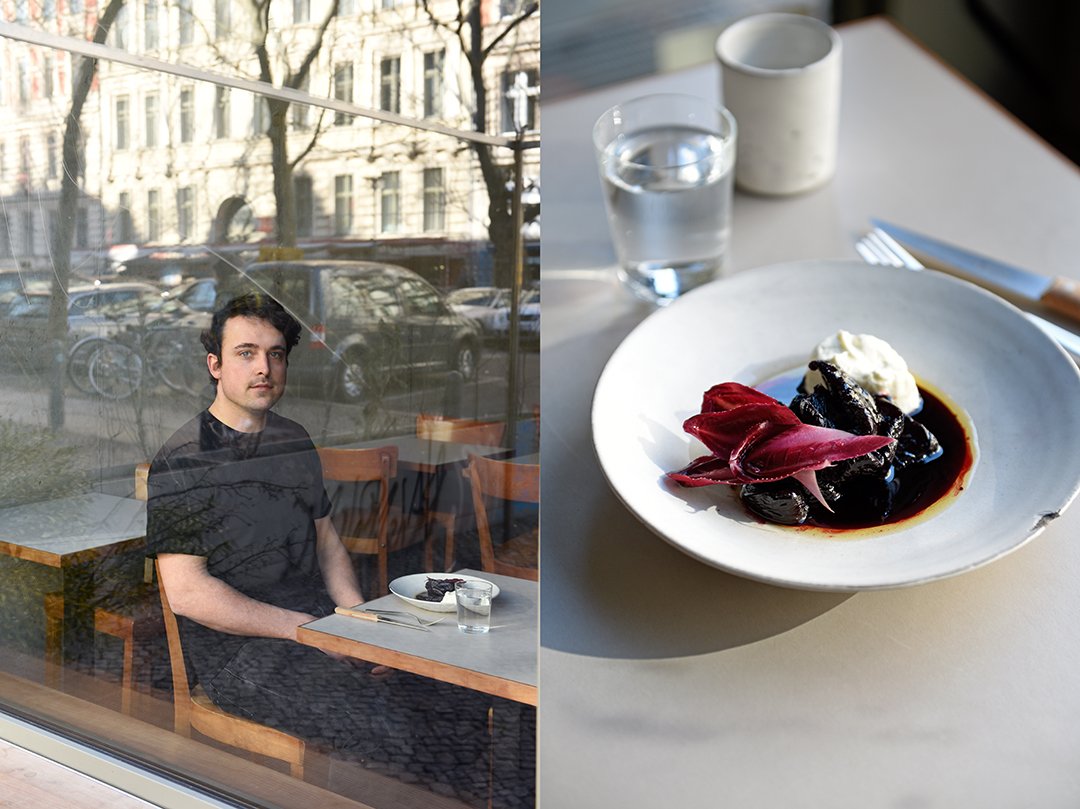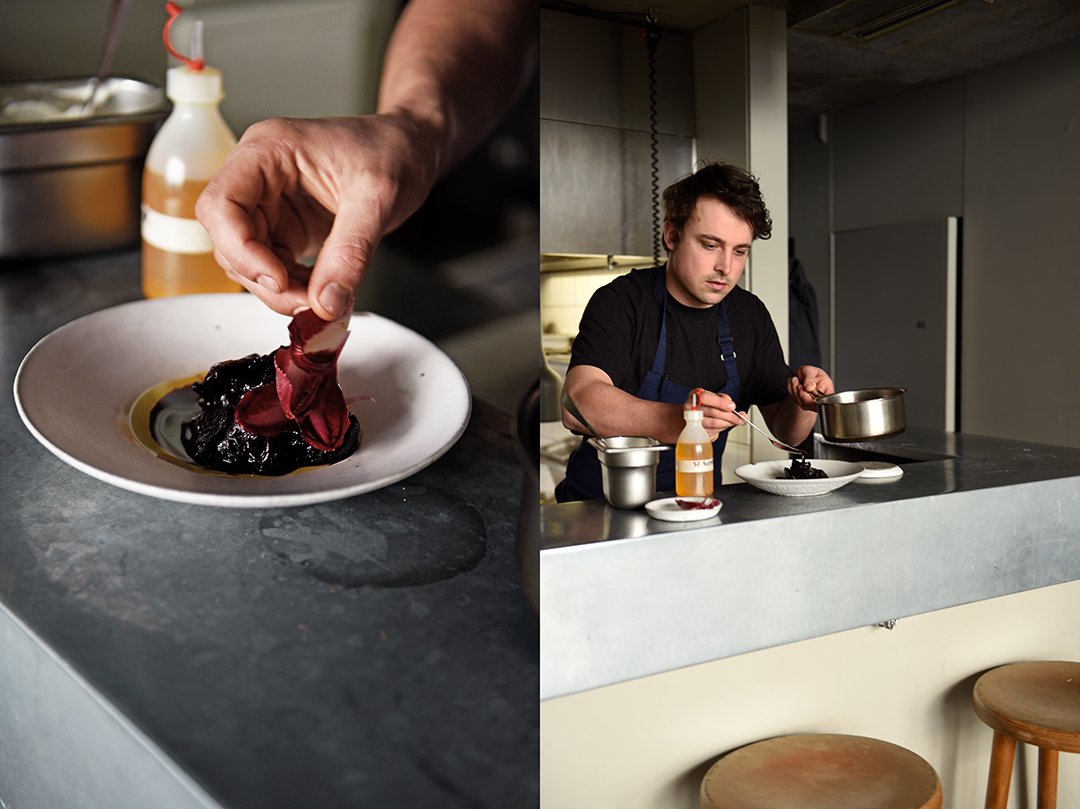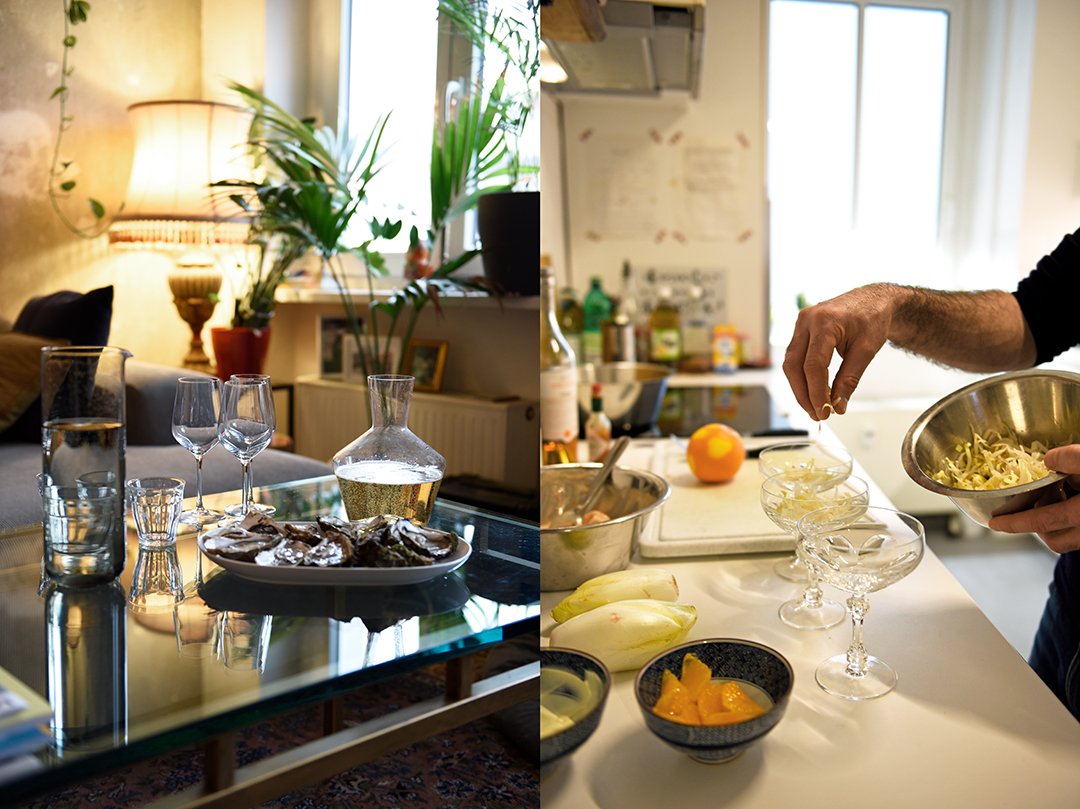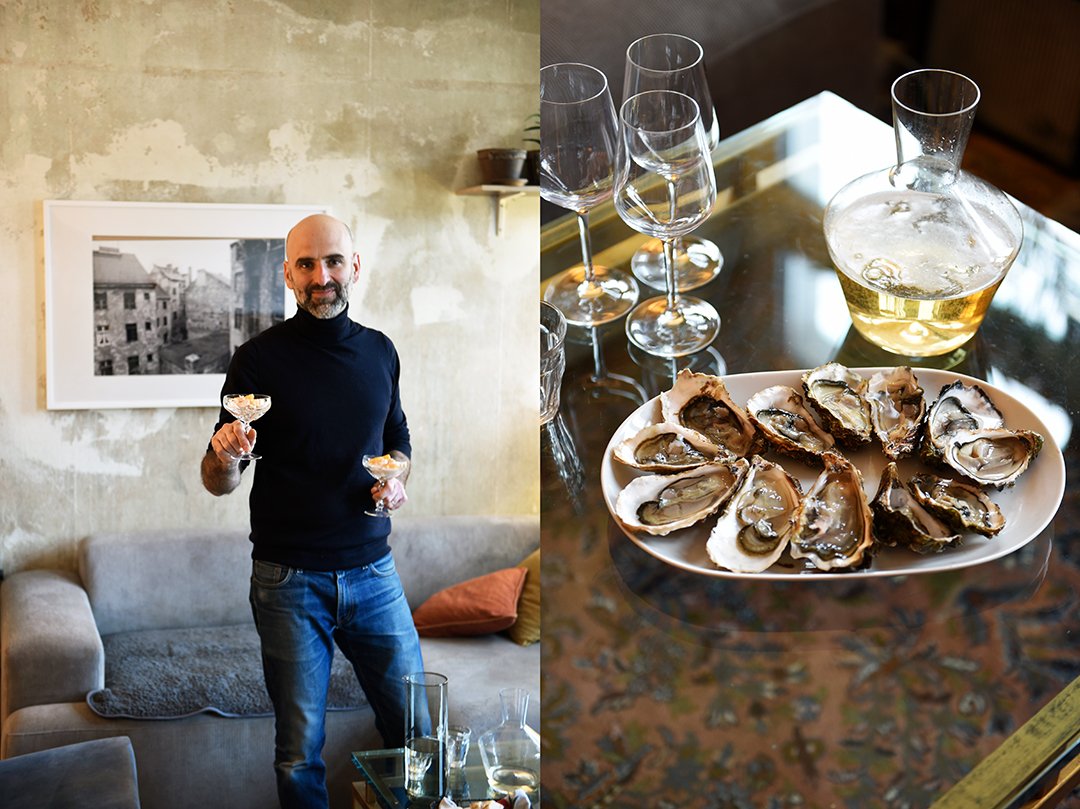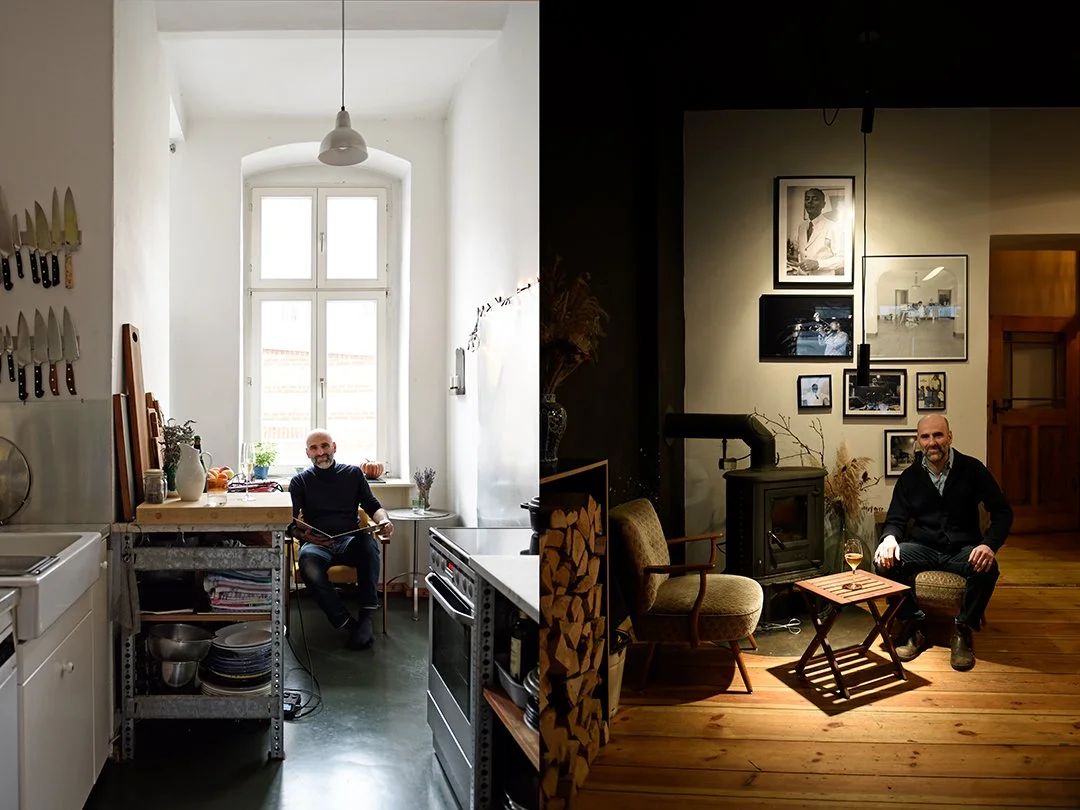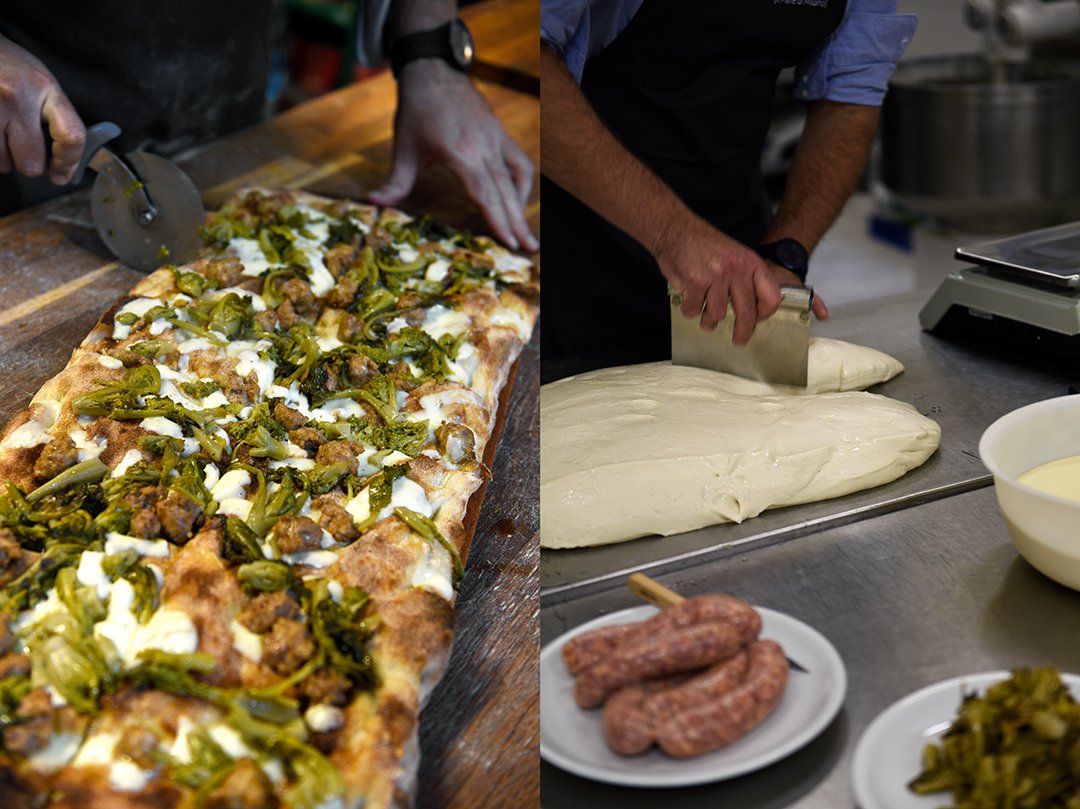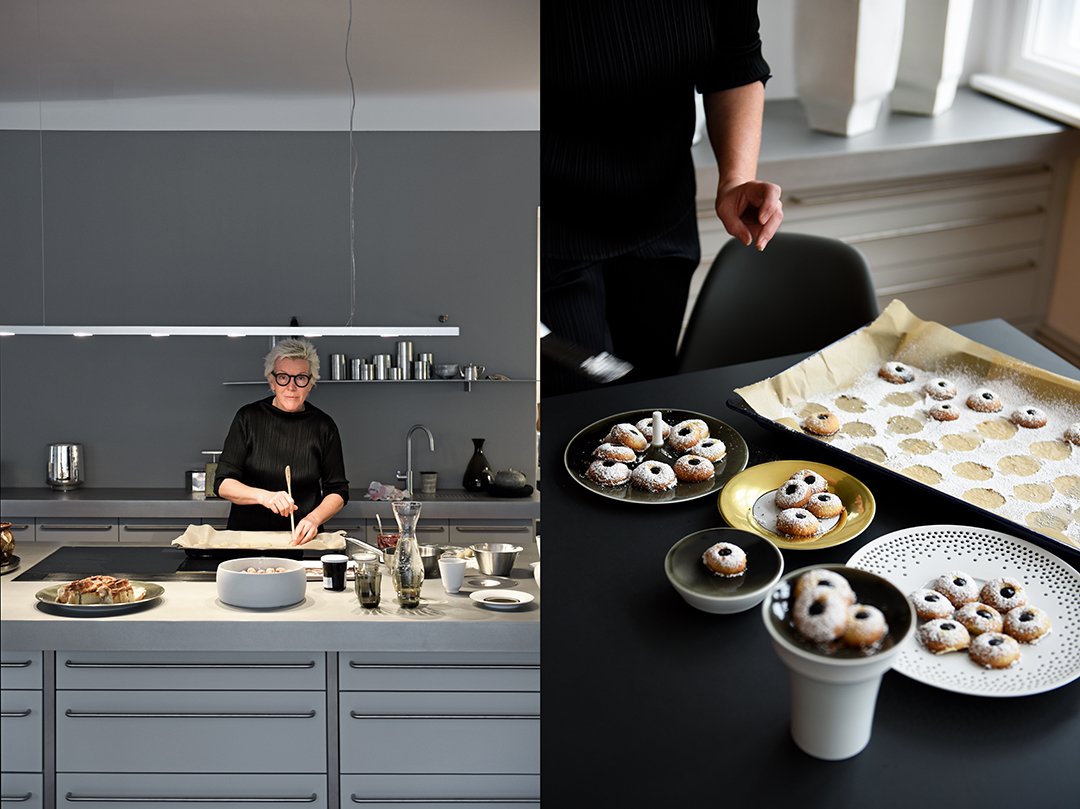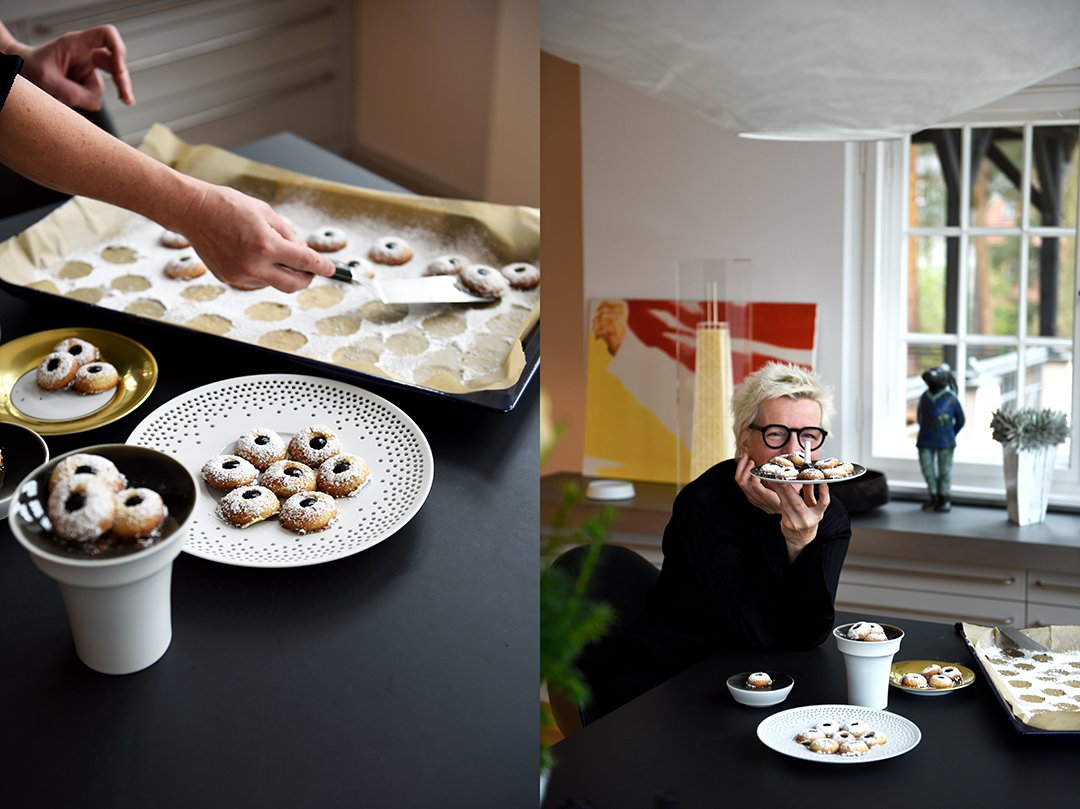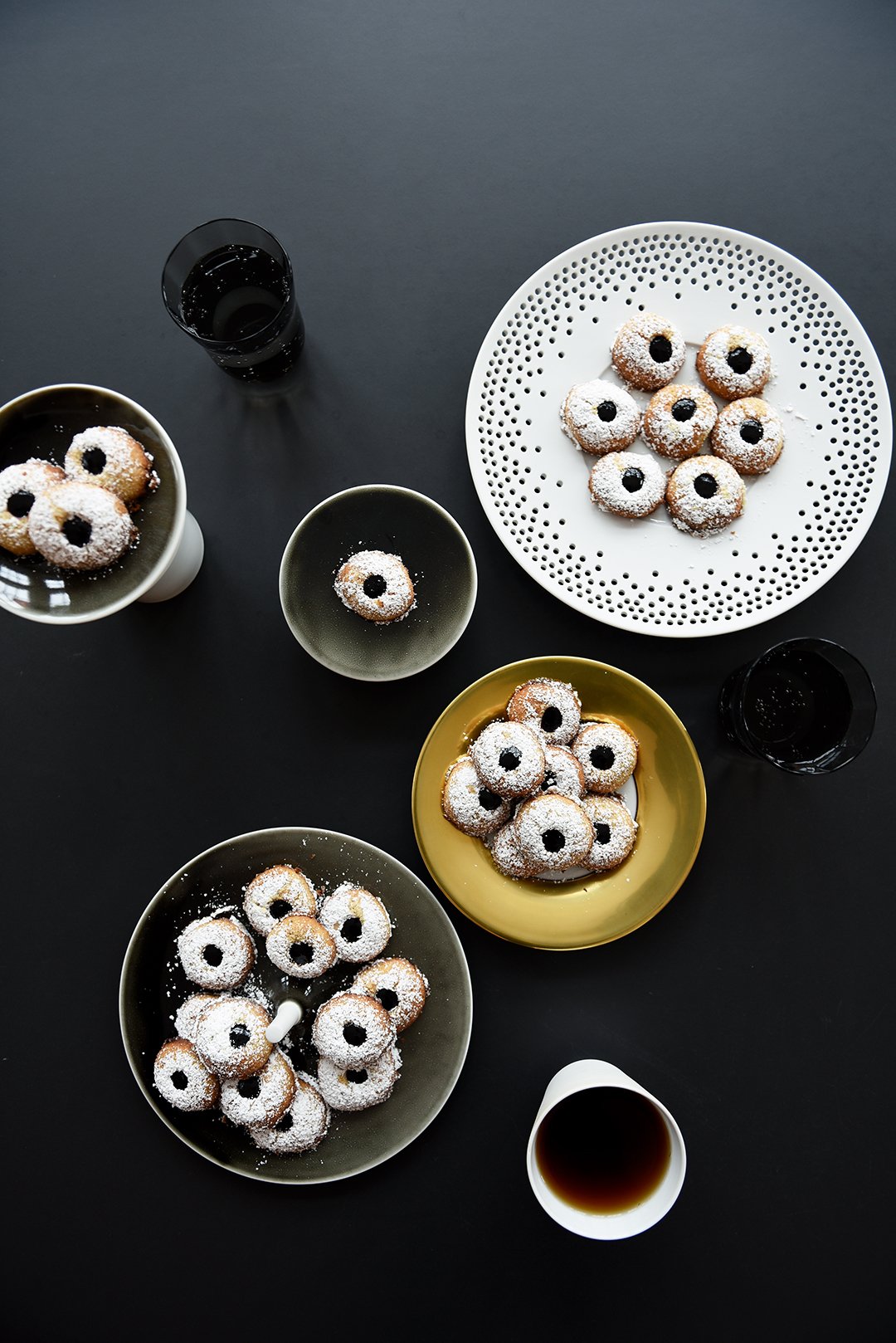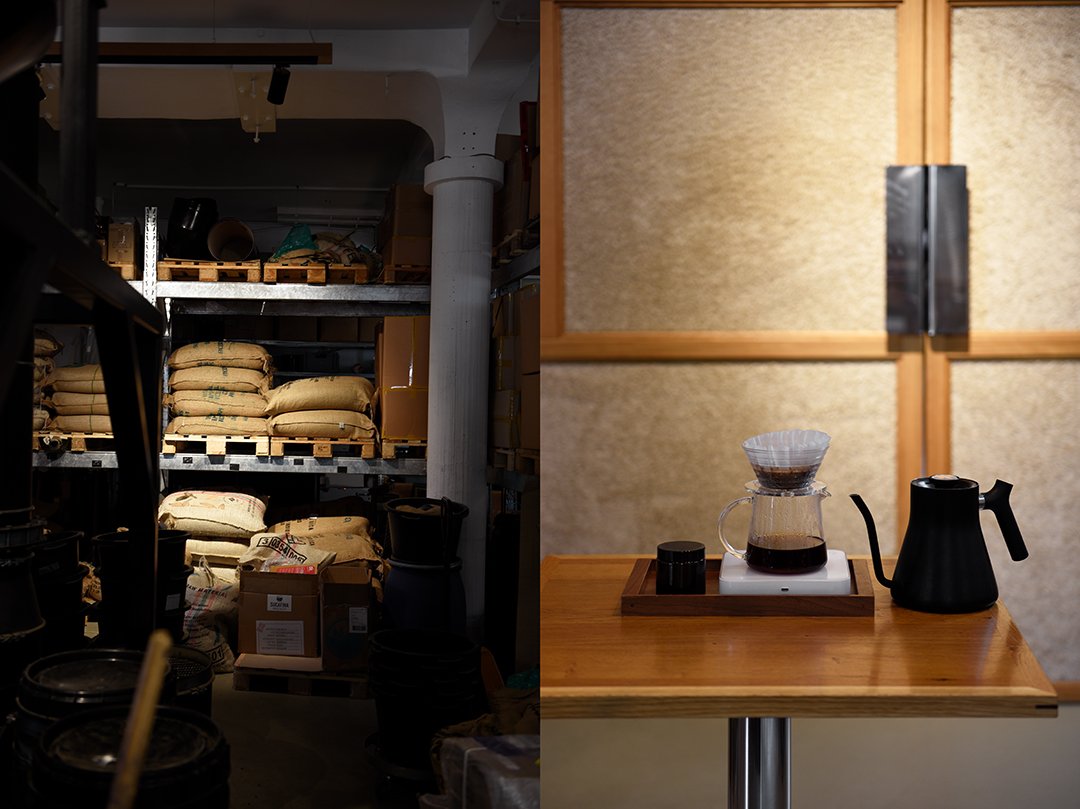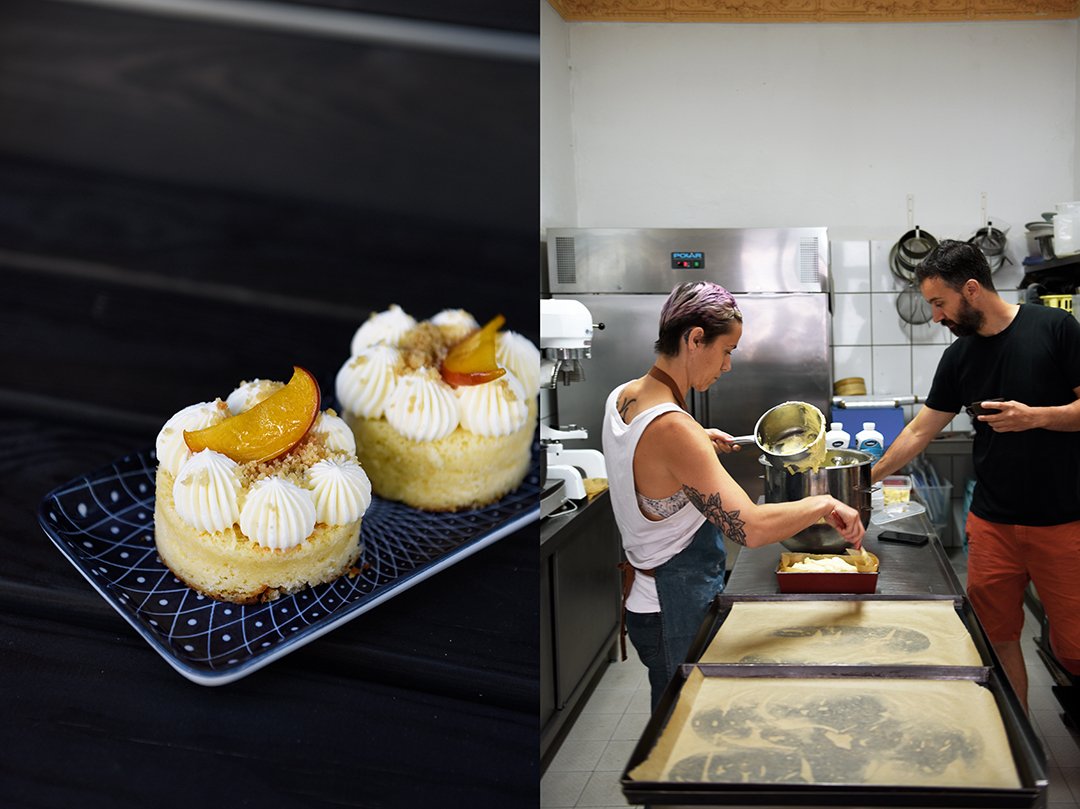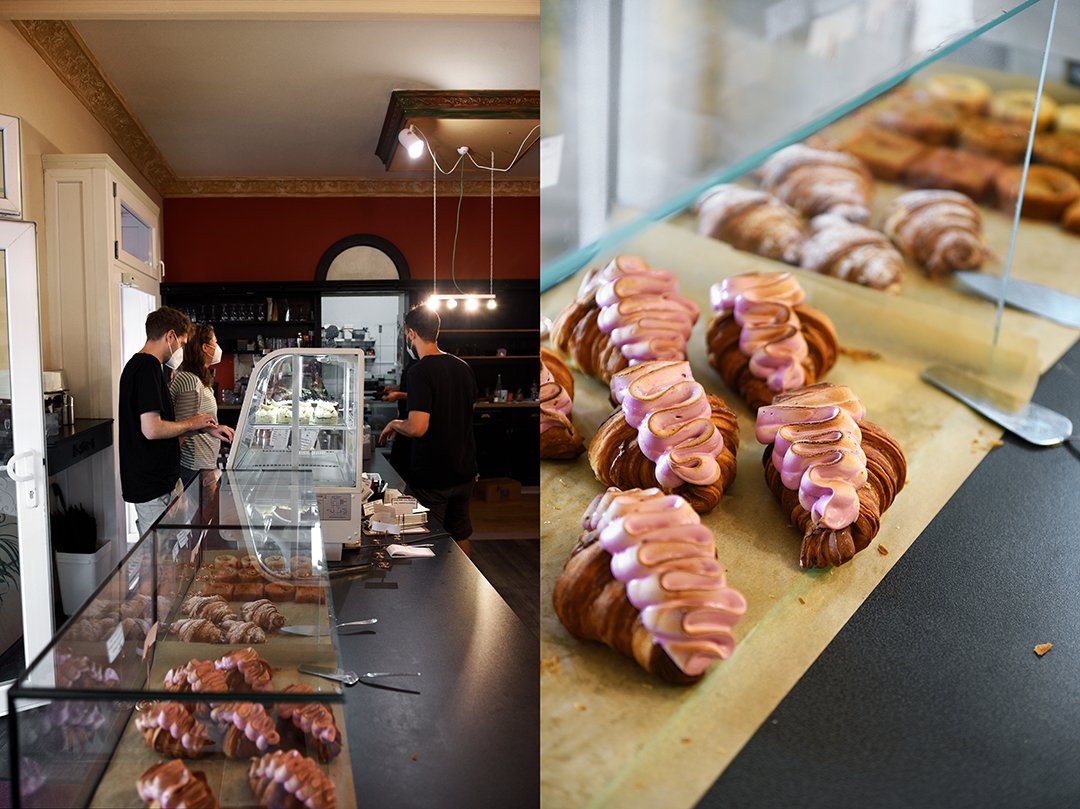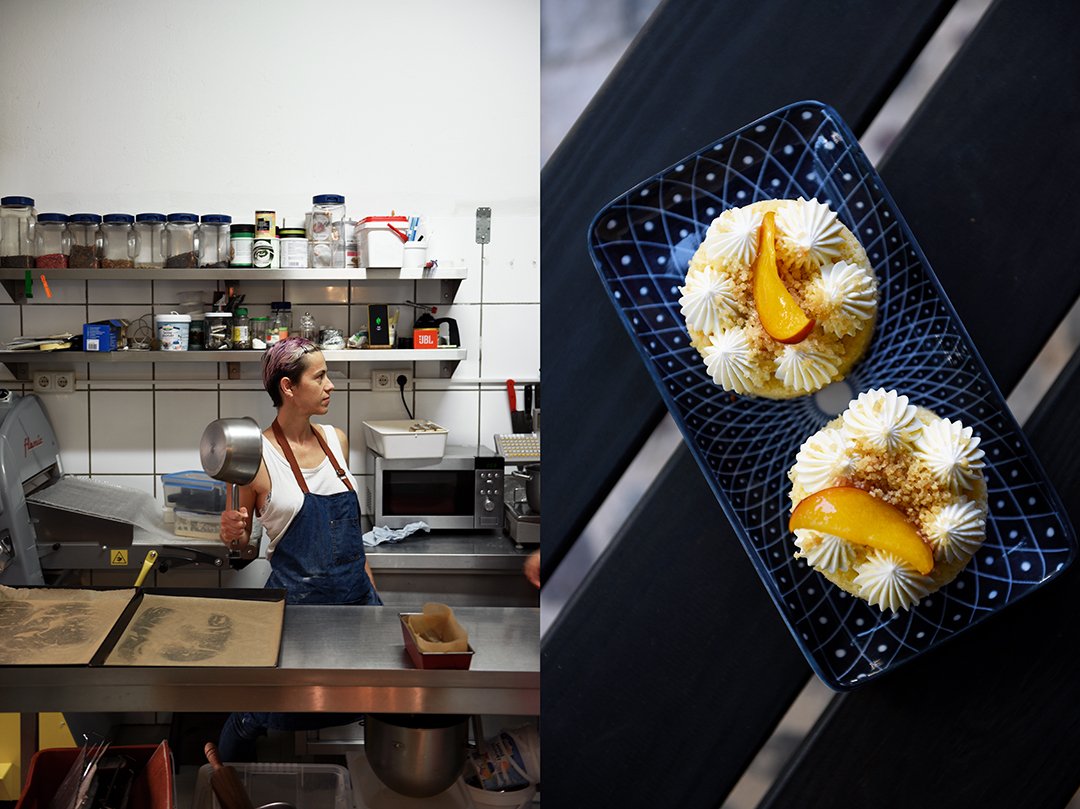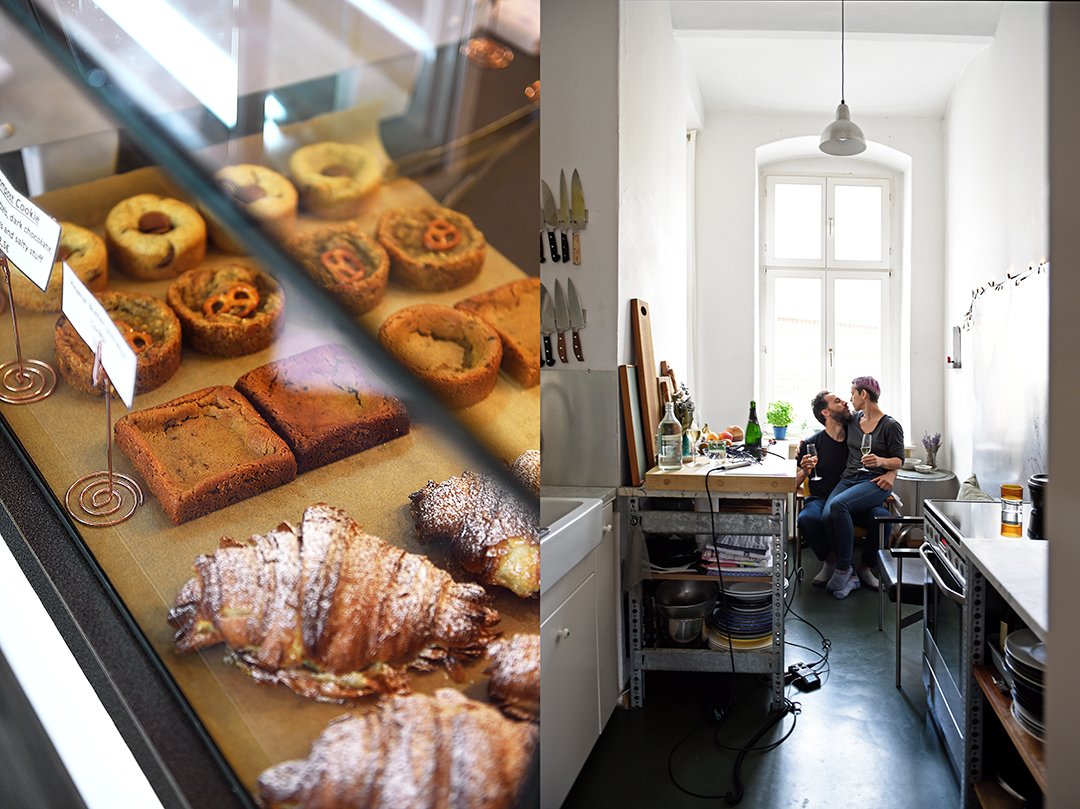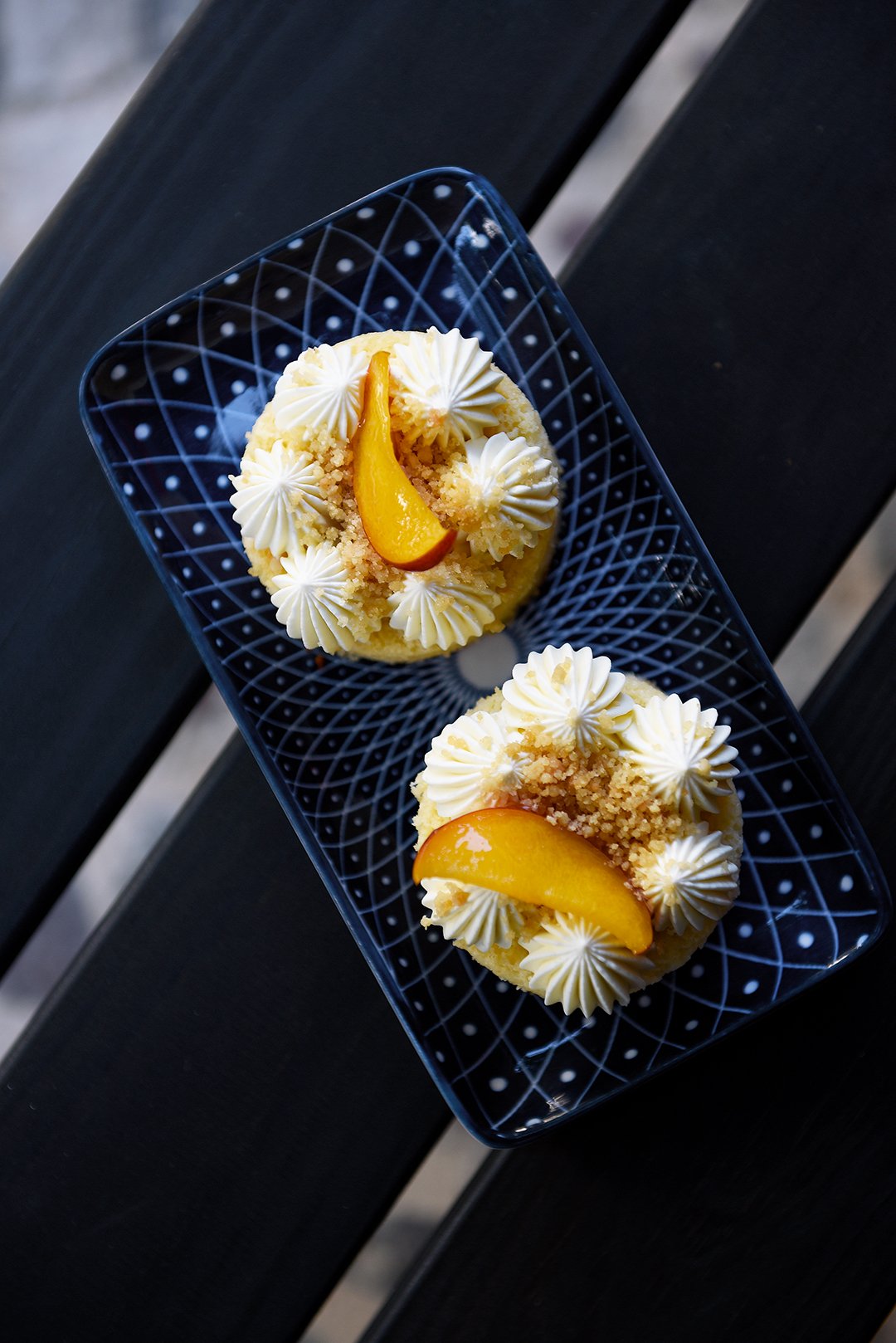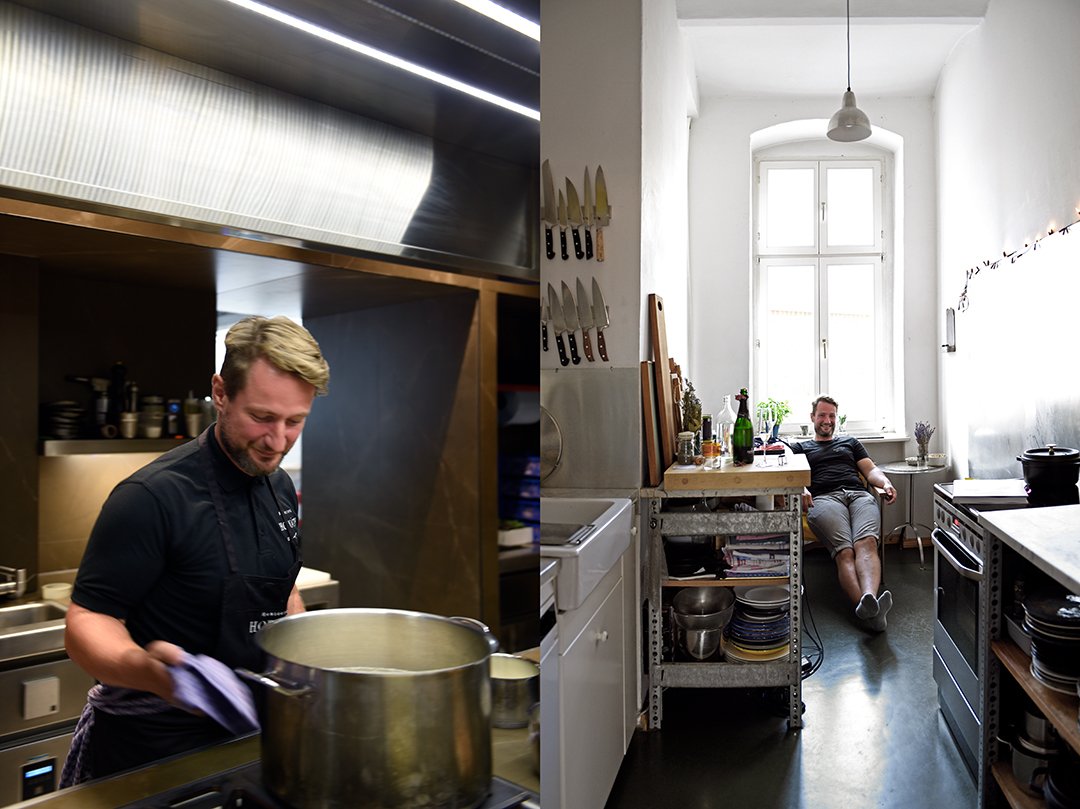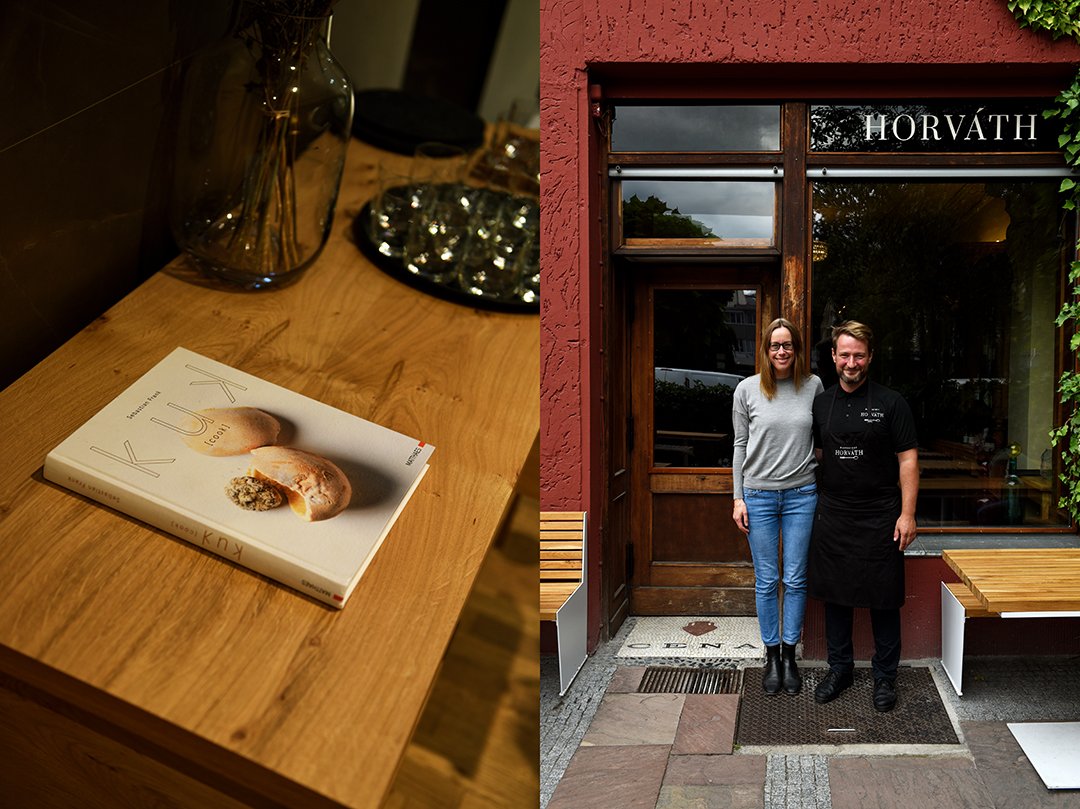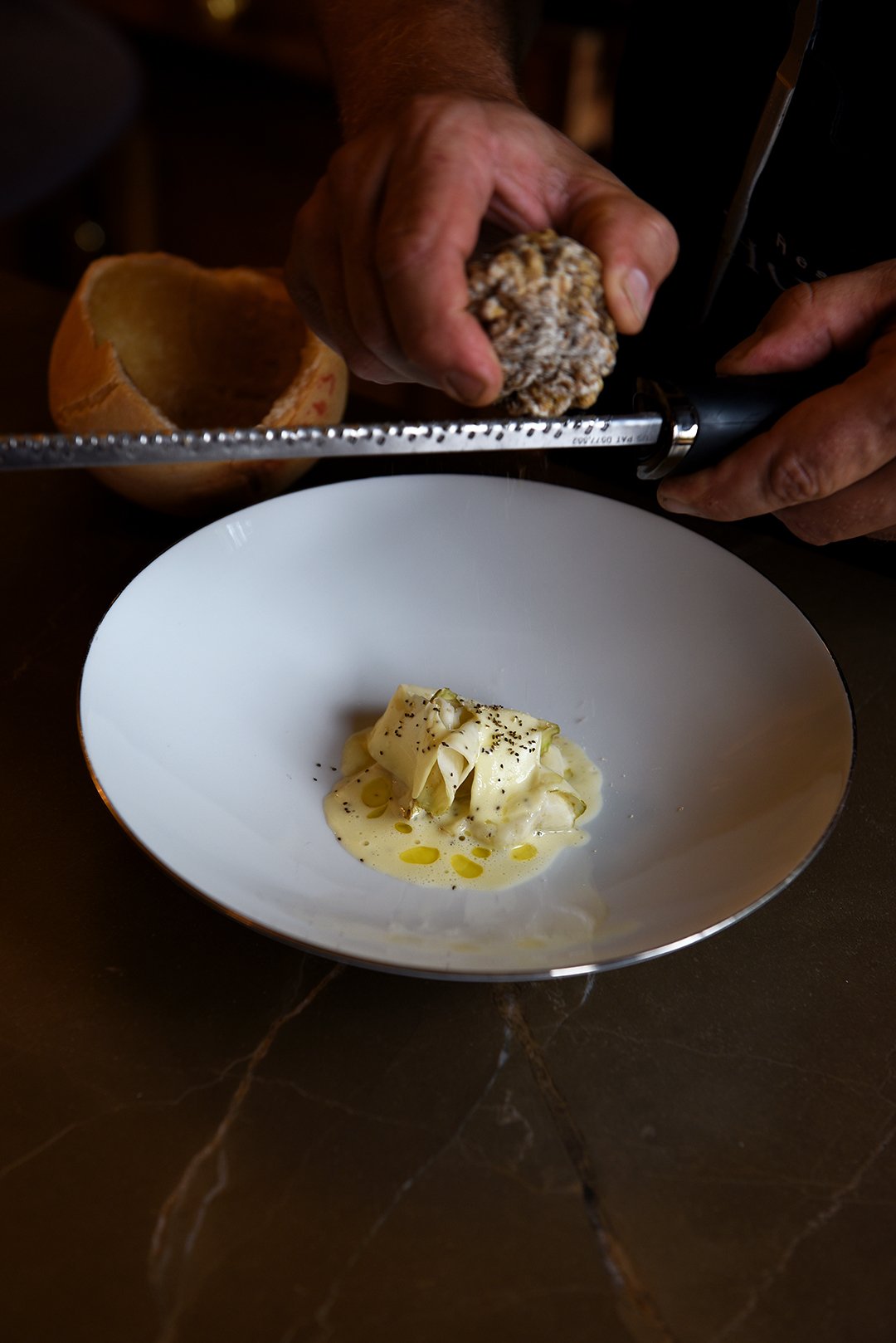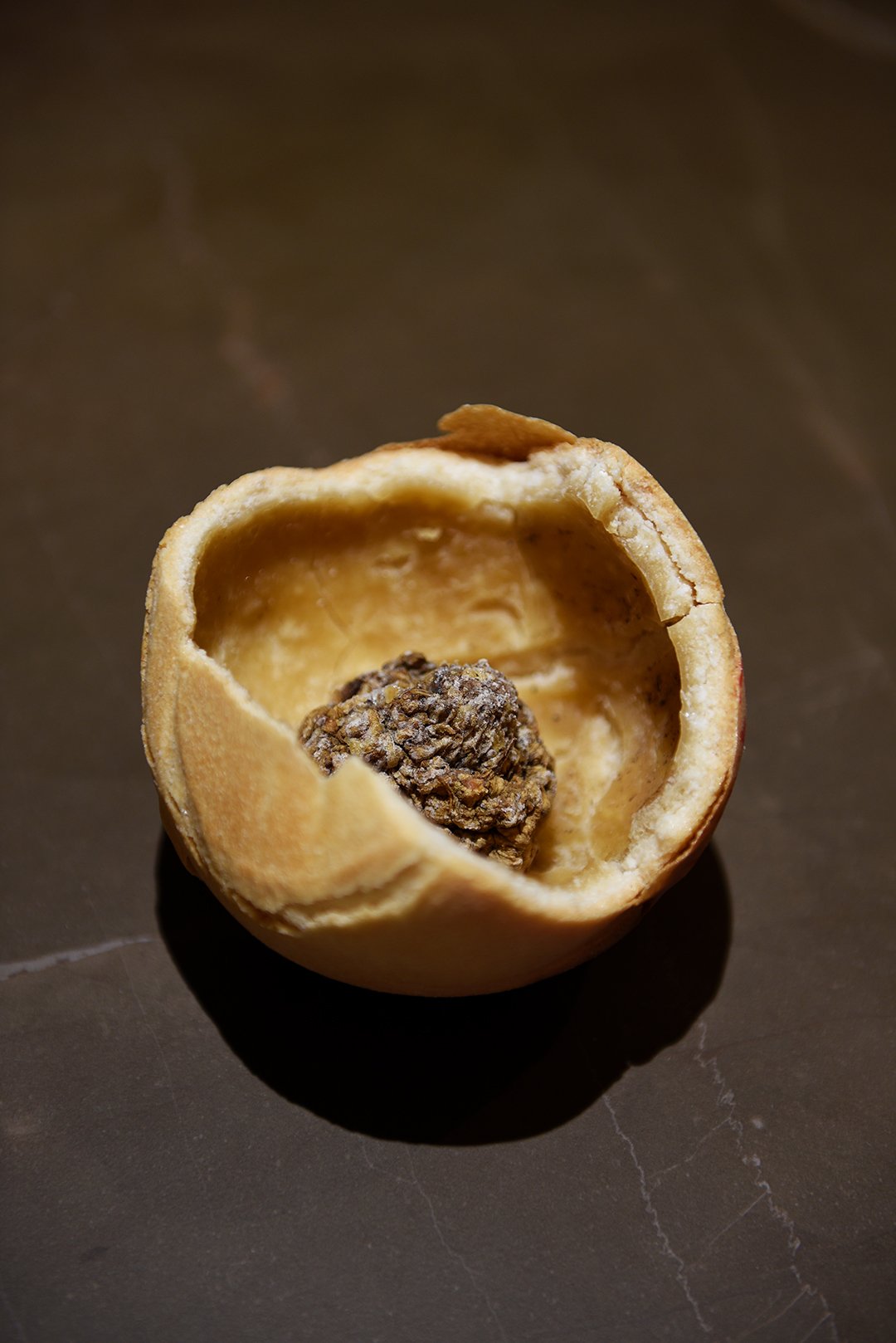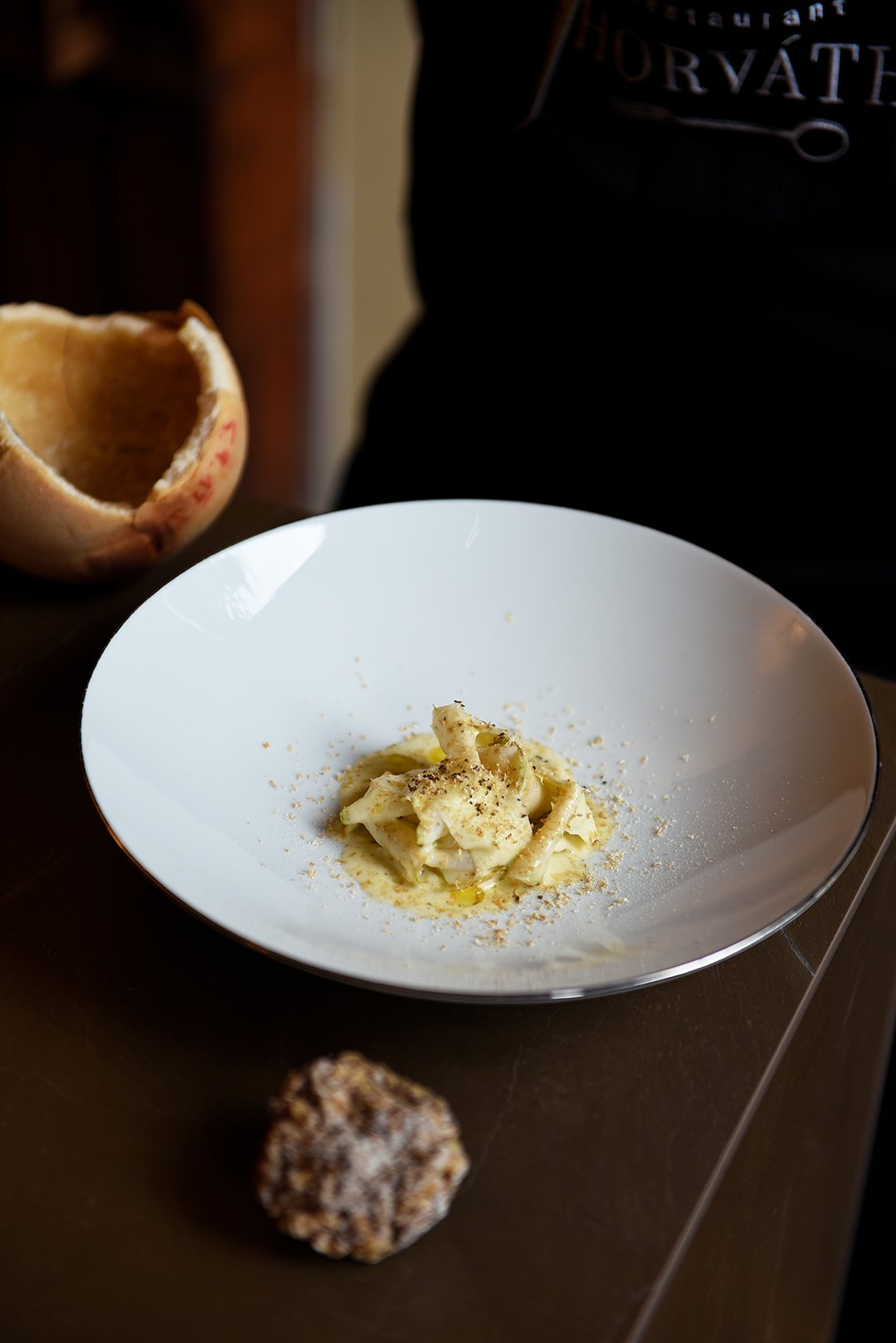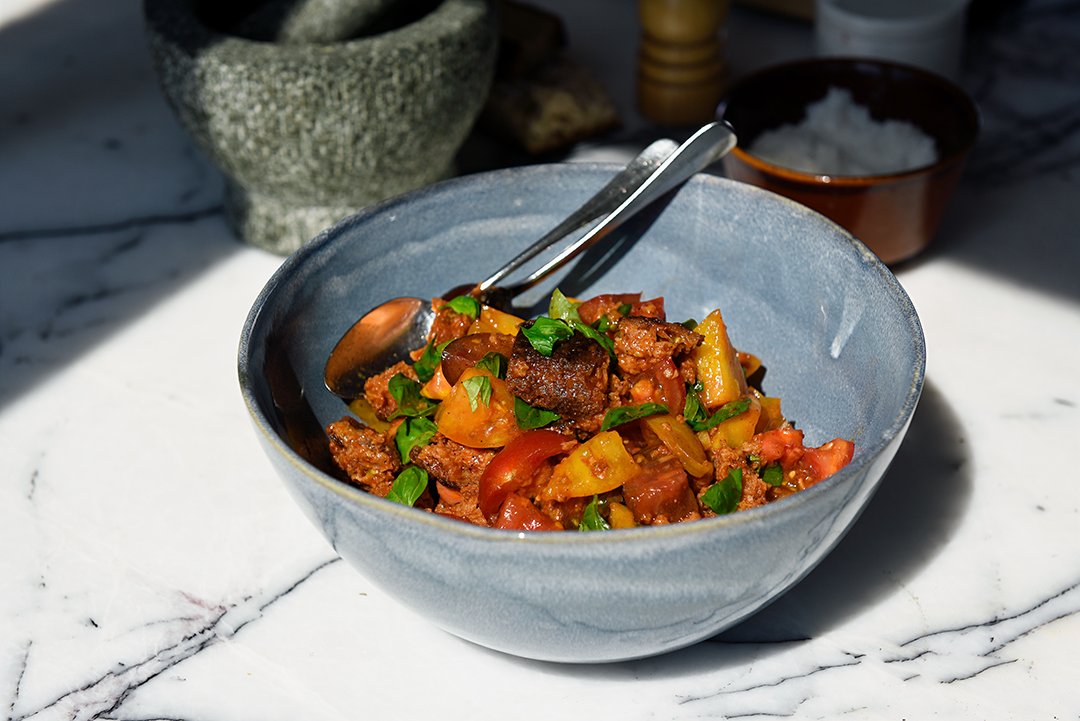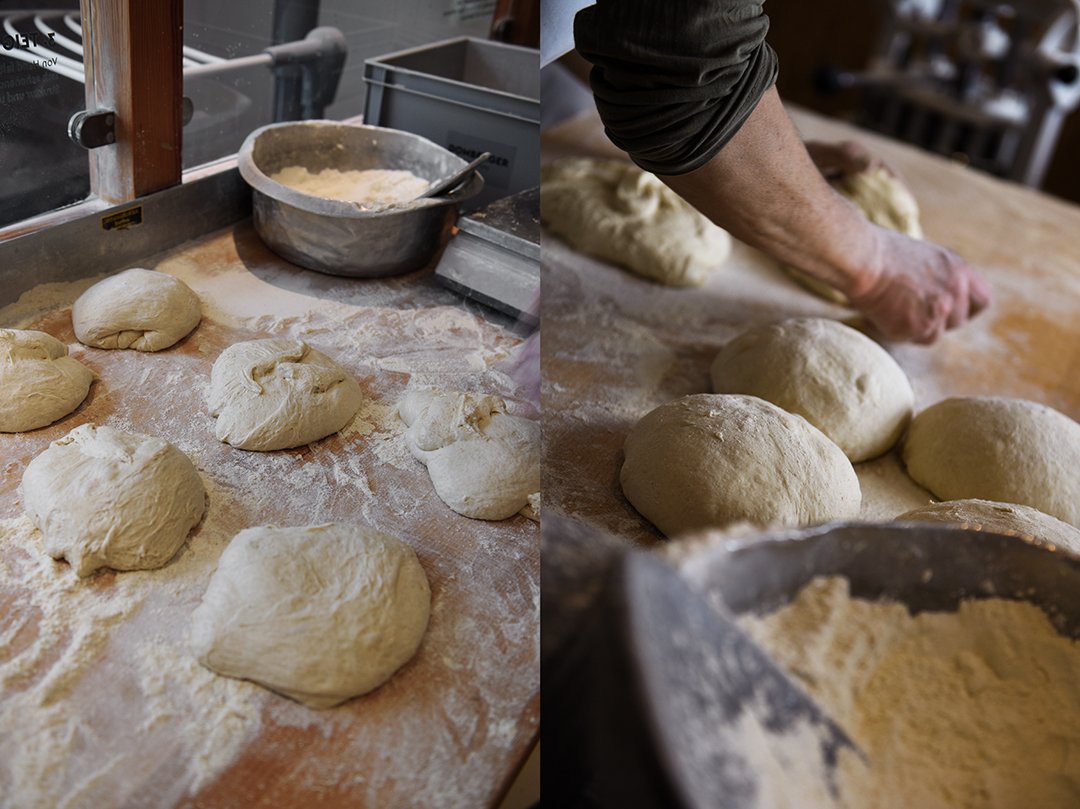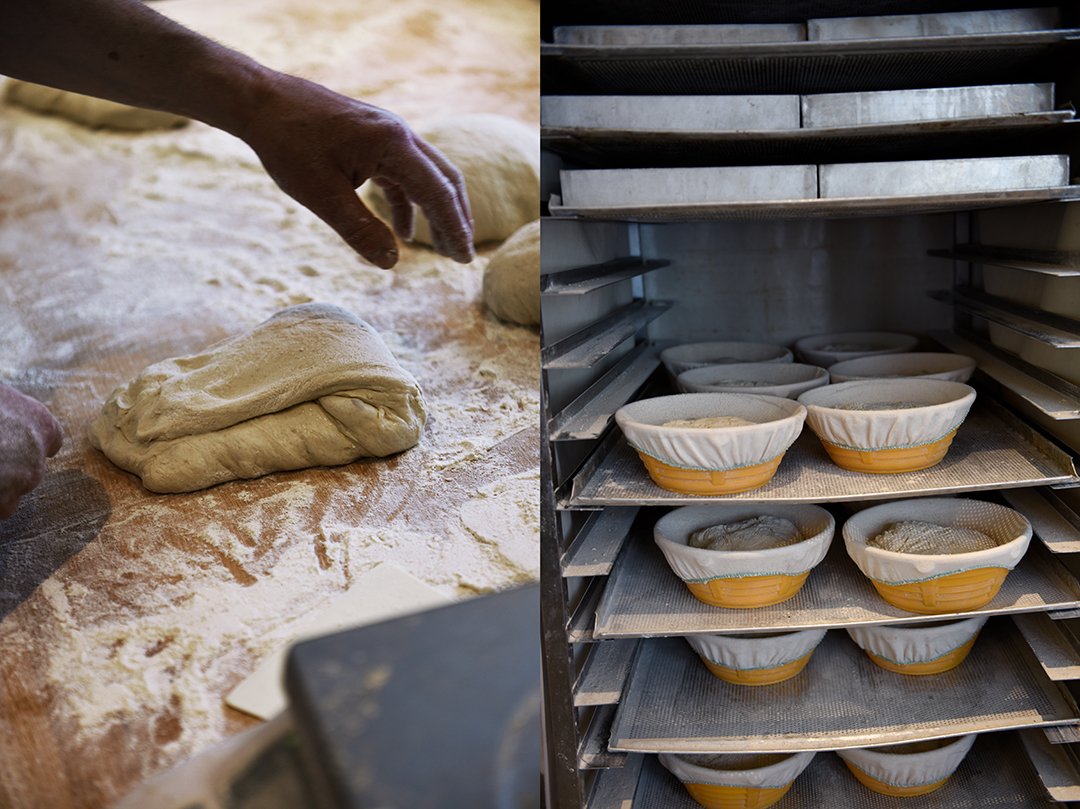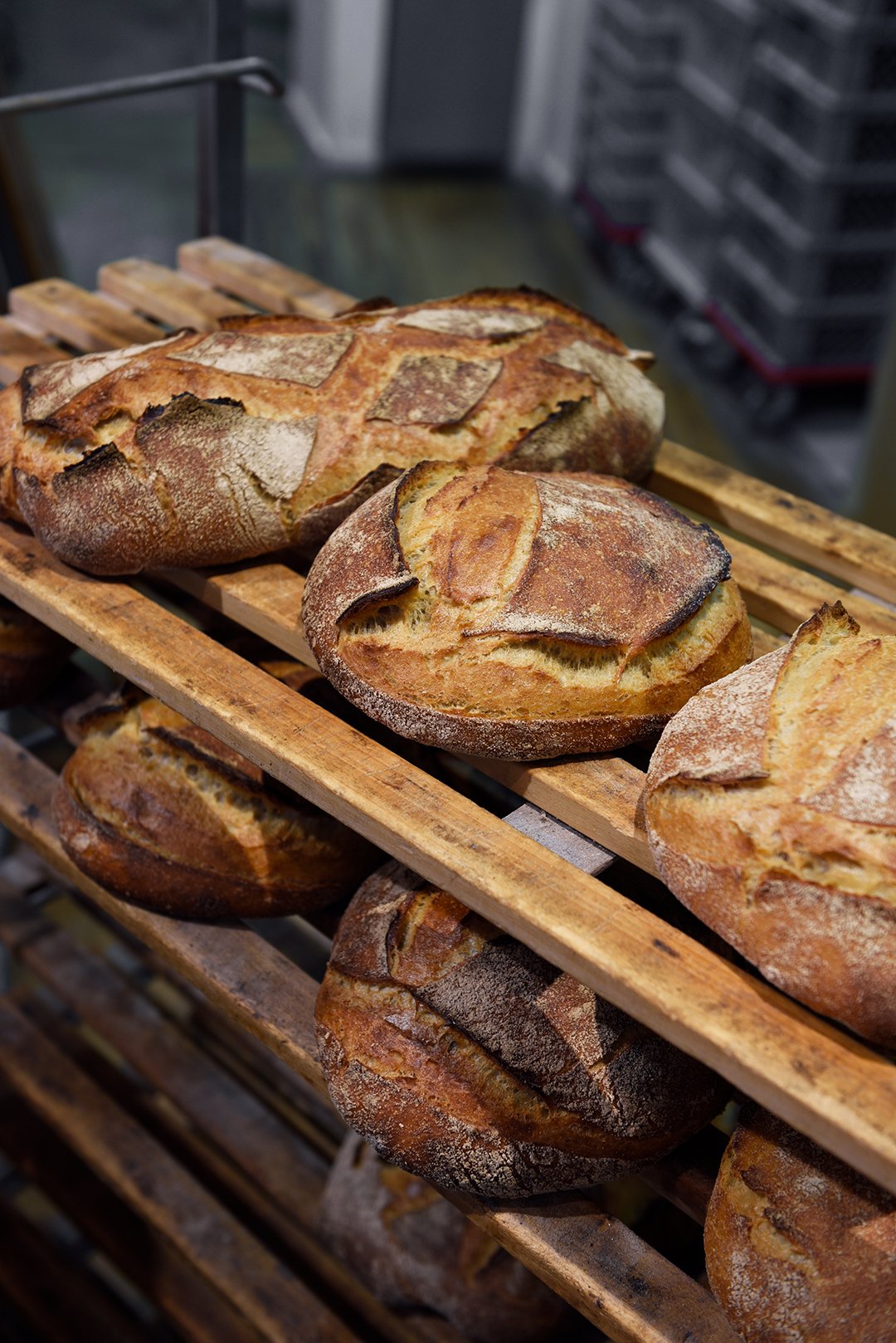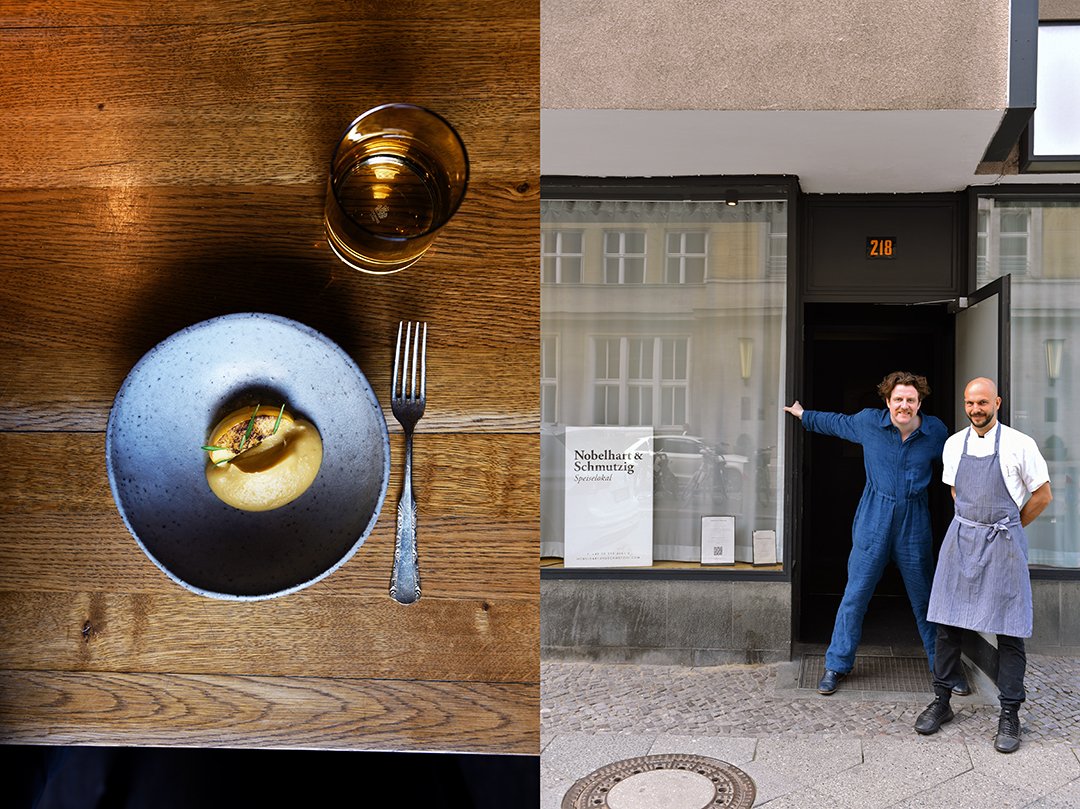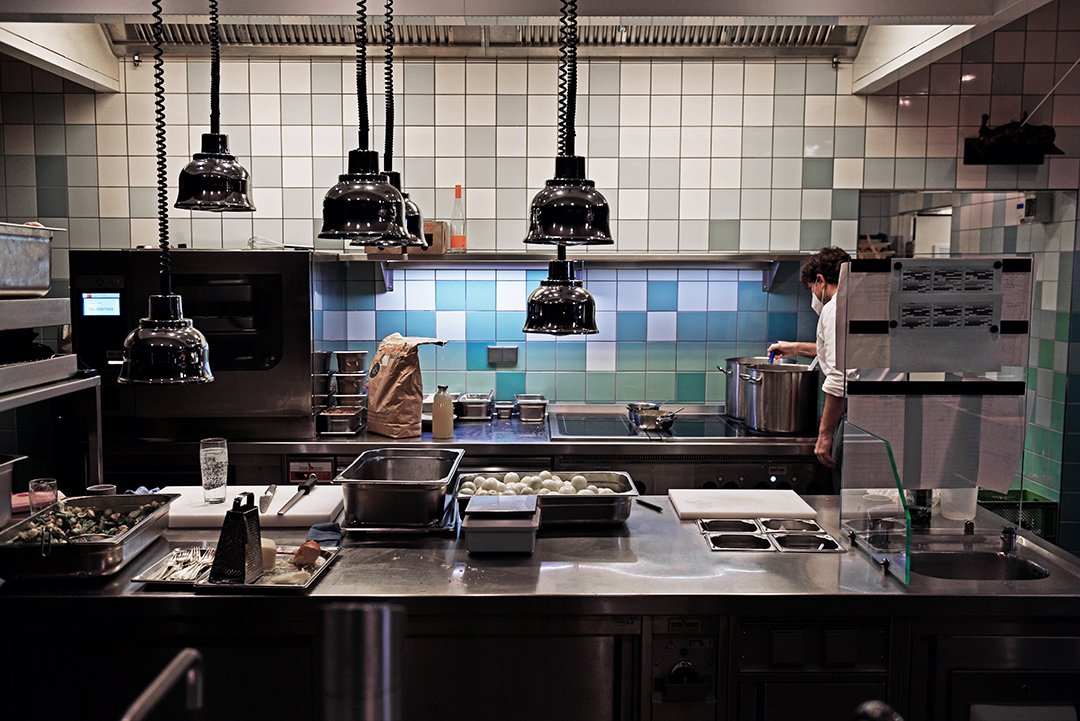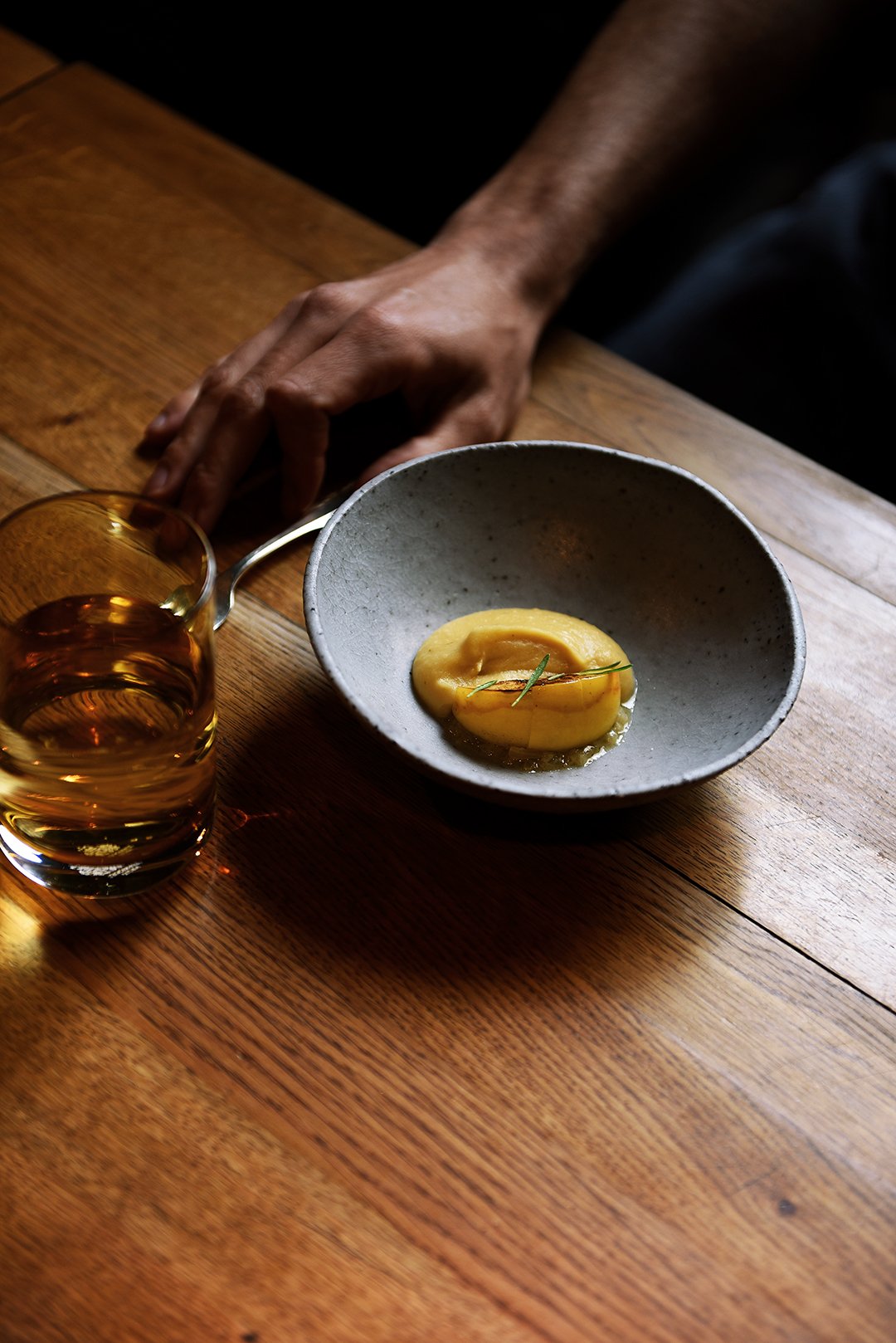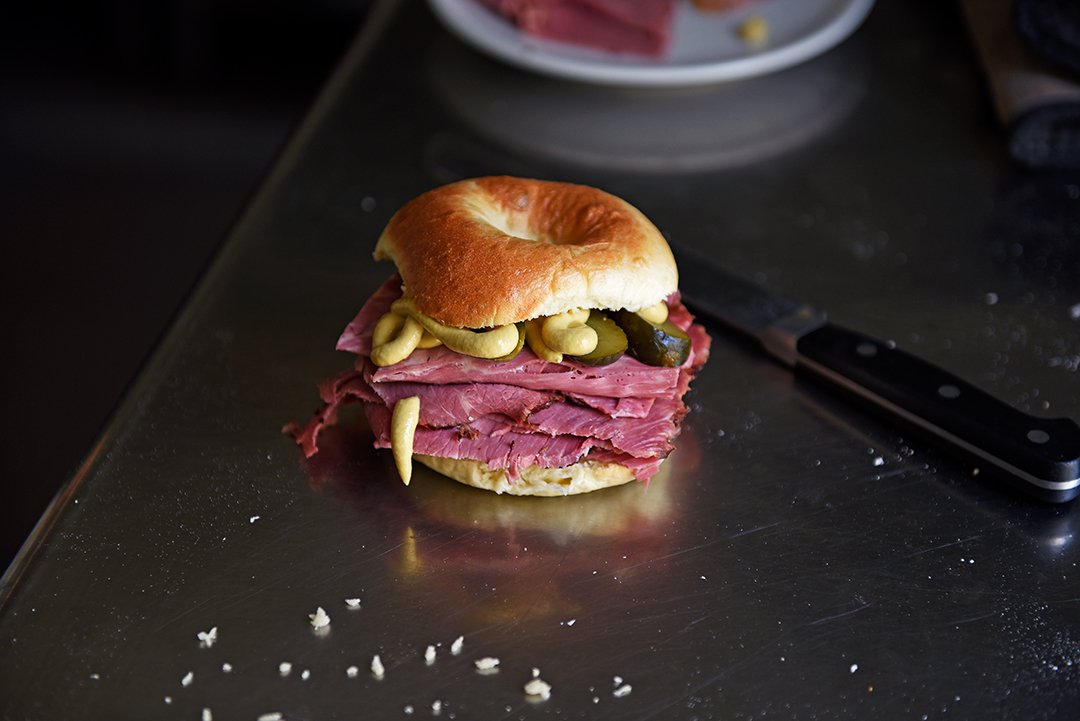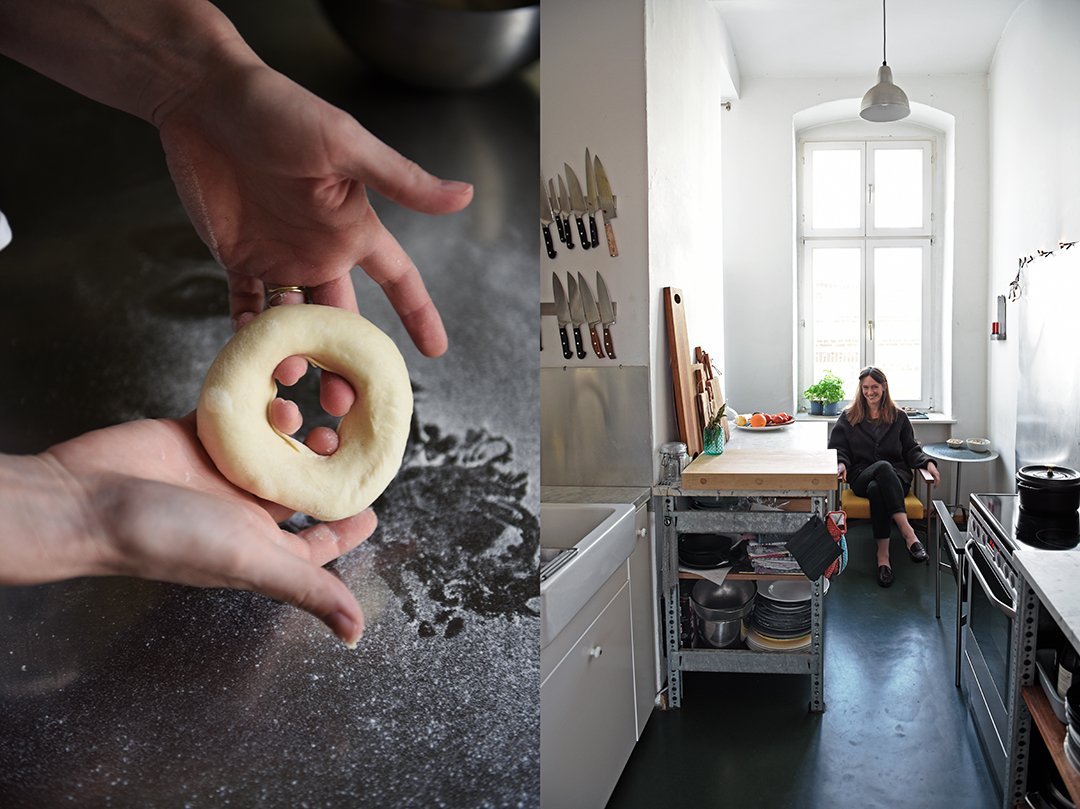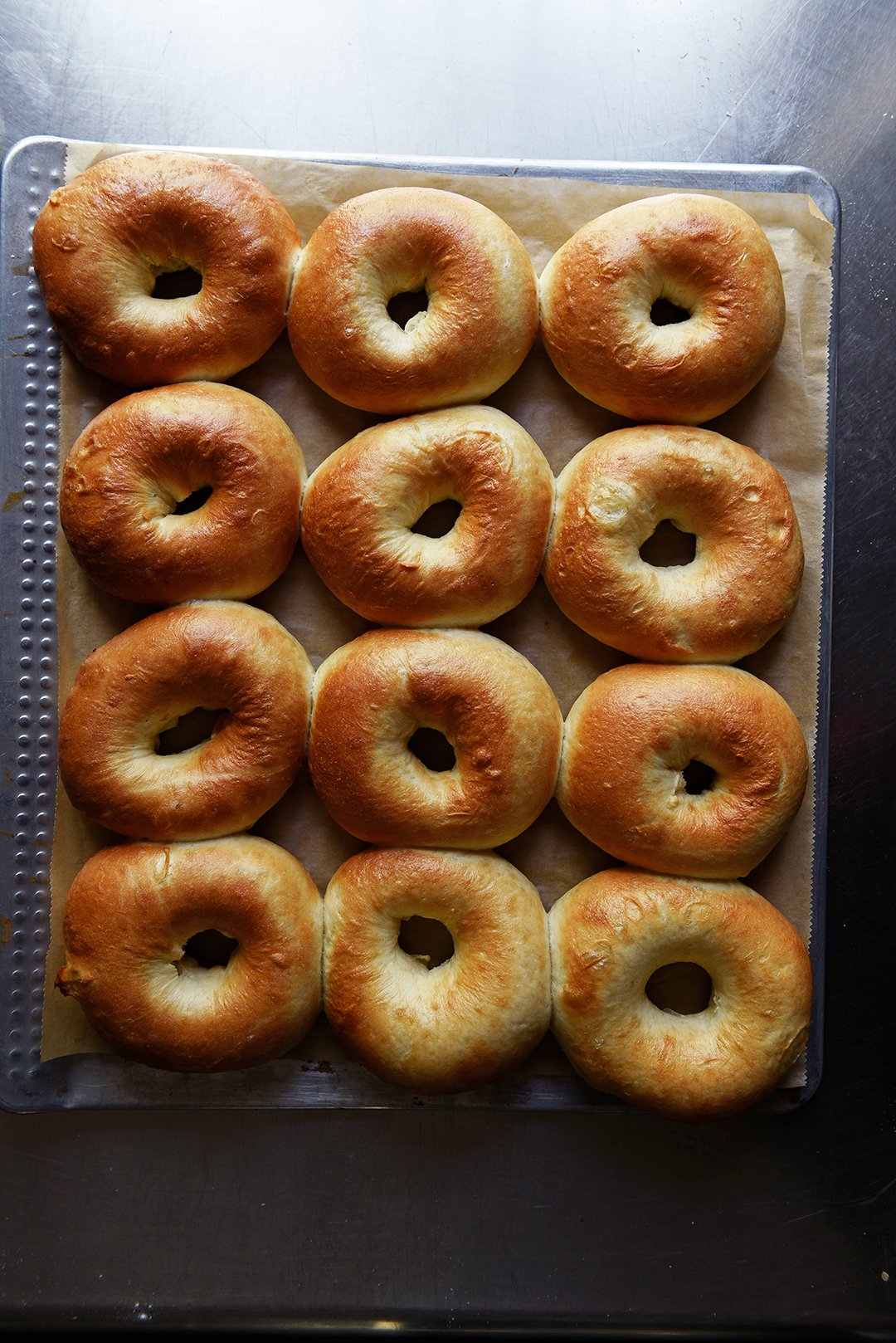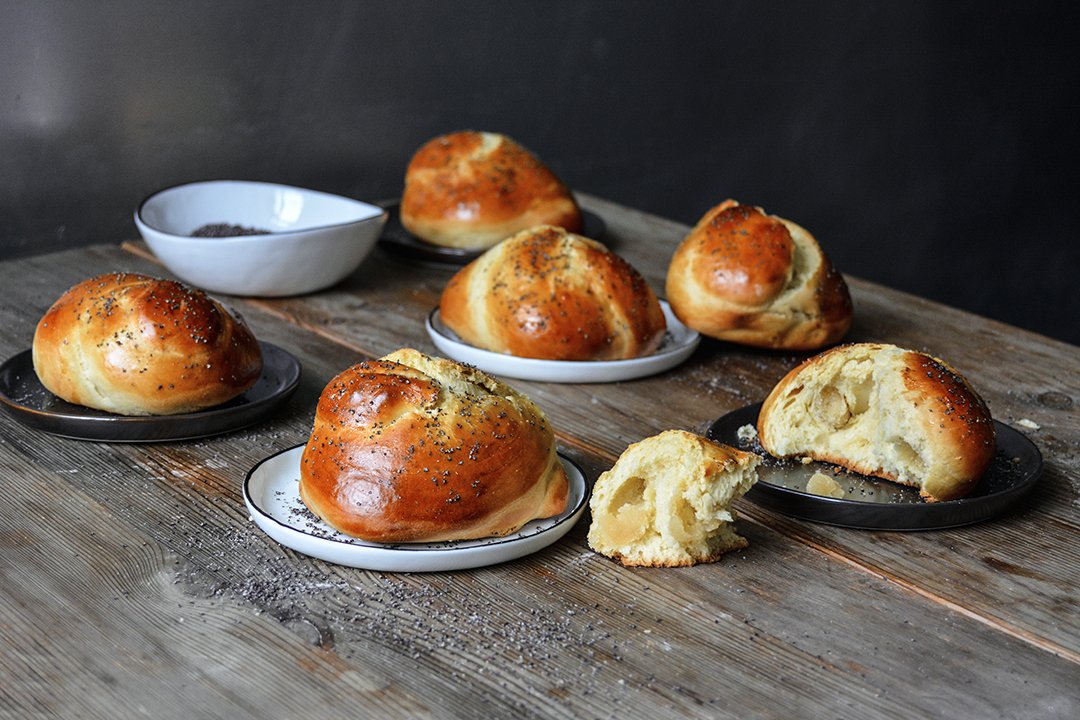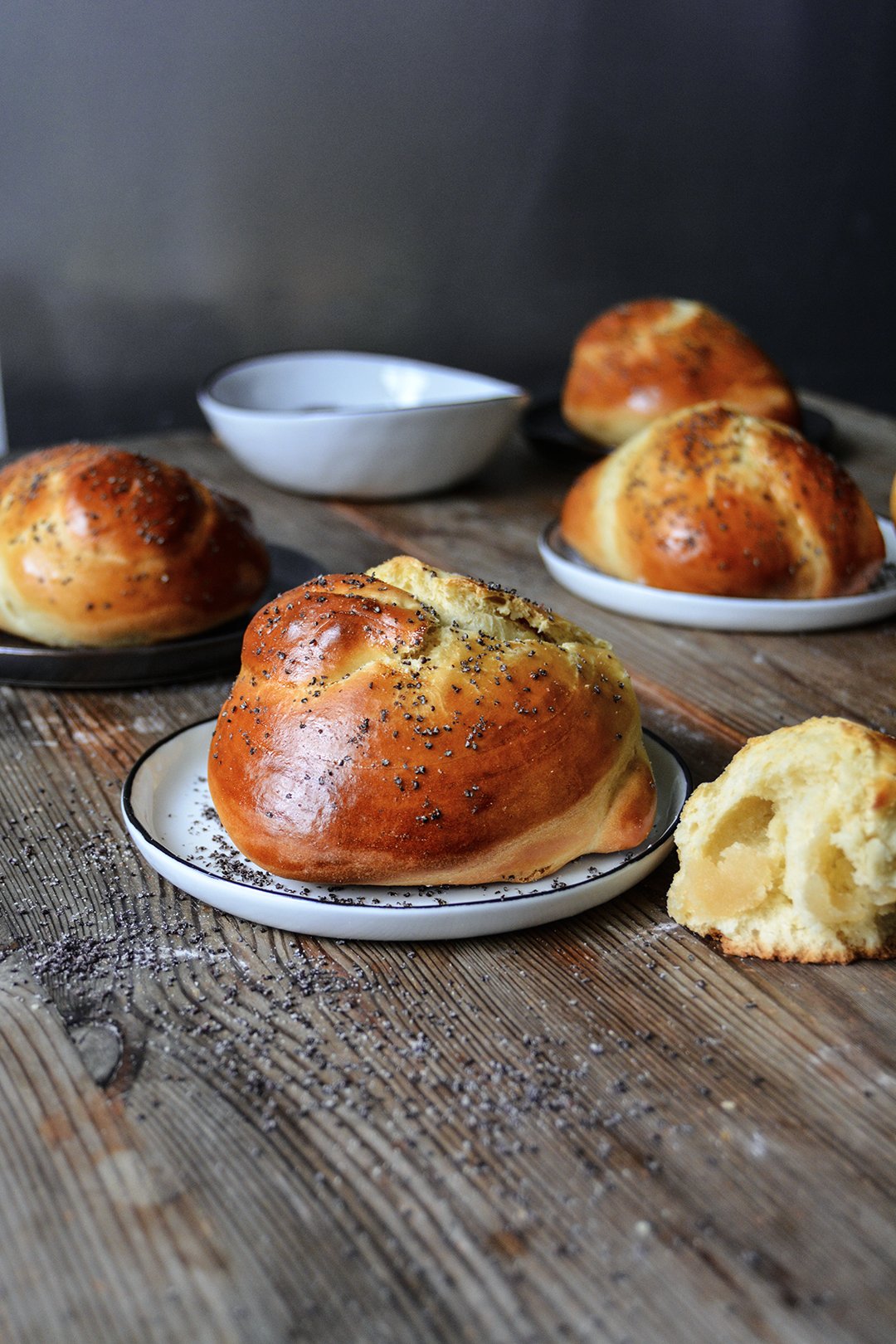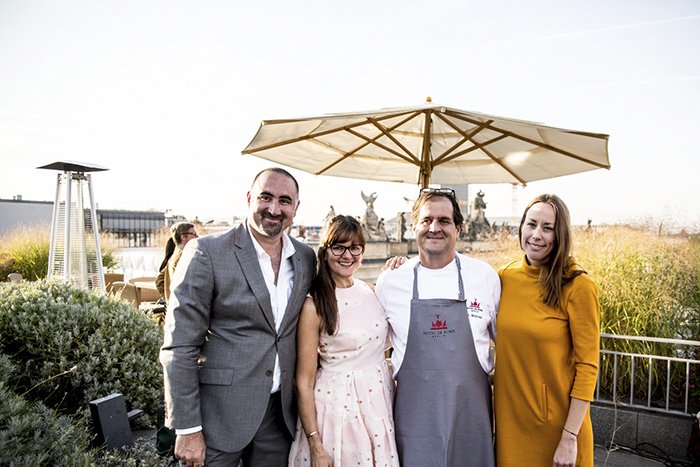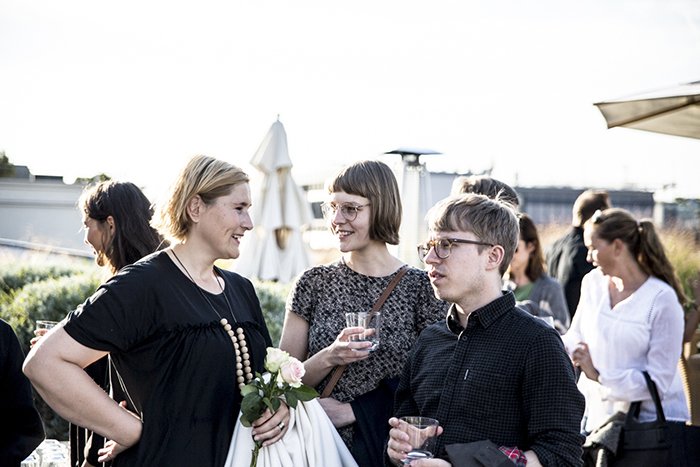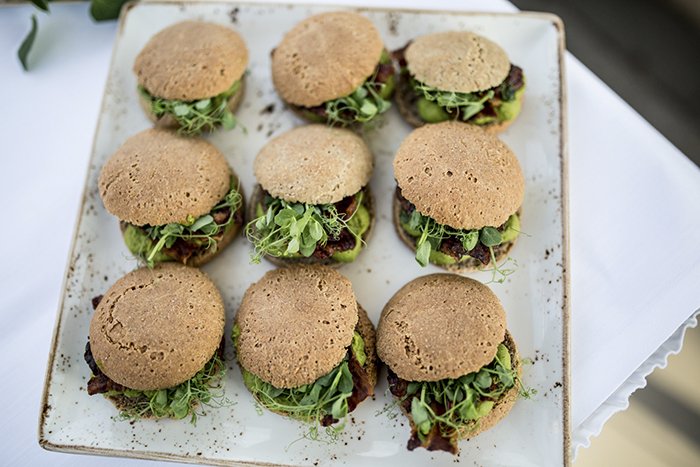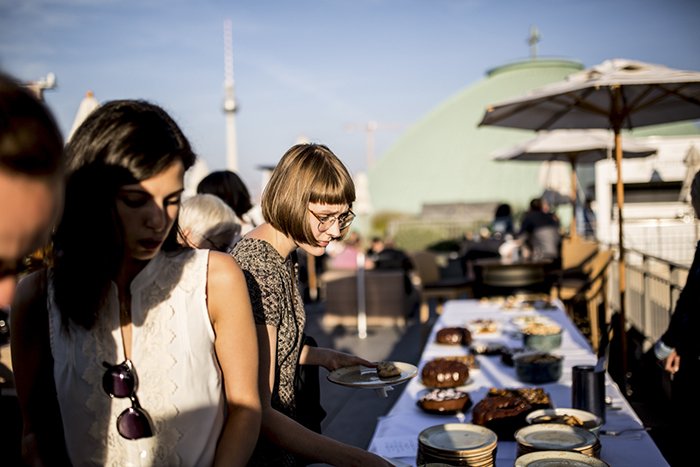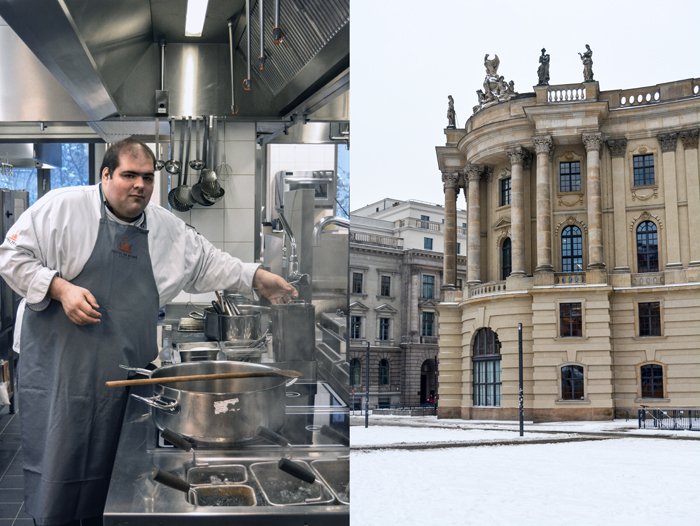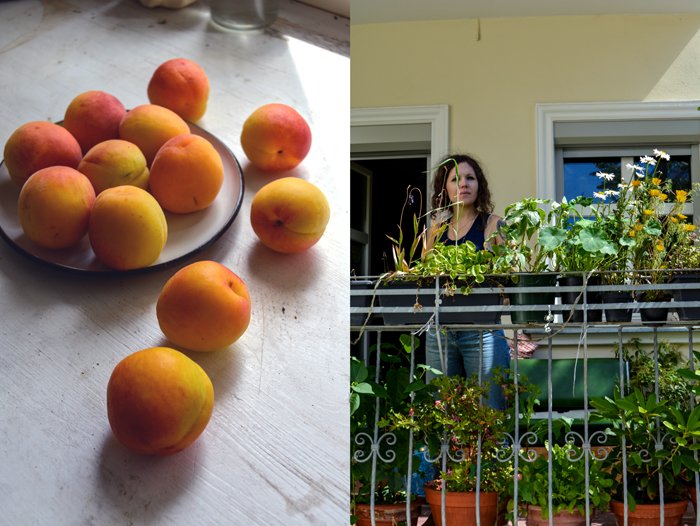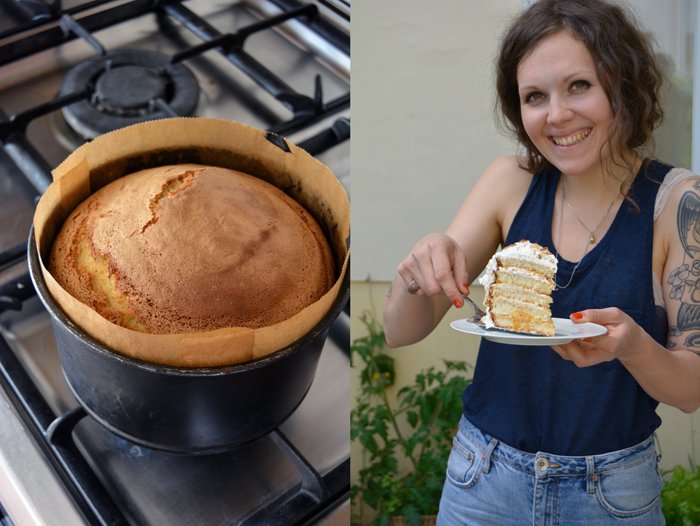BERLIN
Berlin was a party! We celebrated the German NOON at the stunning Hotel de Rome, with (lots of) champagne, with friends who came all the way from Lisbon, France, and Vienna, and with many good conversations. And we even sang at the end.
Celebrating a new book in my home city, Berlin, makes me feel both calm and very excited at the same time. I’m surrounded by my people, by my beloved city; and launching a book for the third time at Hotel de Rome, makes it feel even more like home.
So many kept offering me help, there was so much love and support that, although the launch was rather wild, it didn’t feel overwhelming for a second. Our event was set for two hours - we extended it slightly - but not even ten hours would have been enough to fit in all the conversations that I would have loved to have. About 80 guests (I lost track), the champagne kept pouring, the snacks from NOON were relished with sounds of pleasure (so much praise for the Hummus and Sauerkraut on Sourdough Bread from the book! Click here for the recipe), we didn’t even need any background music as the chatting and laughing filled the hotel’s Opera Court, a grand room in the former bank’s building (you can read more about the hotel’s history here).
Restaurateur Billy Wagner of Nobelhart & Schmutzig, no. 45 of the World’s 50 Best Restaurants, thankfully agreed to do the talk with me at our event. About two years ago, we had done a Meet in Your Kitchen feature and a podcast episode together. A few months ago, I bumped into him at an exhibition. After I had left, I was already on my bike on my way home, I thought “Billy, he’s the one for the Berlin NOON talk!.” So I quickly cycled back, asked him, still out of breath, if he’d be up for it and, luckily, he was.
When he asked me his questions in his calm Billy-way - some even unexpected, which I like - I stayed relaxed and inspired throughout the entire conversation. I think our exchange about food, noon, cookbooks, rituals, and recipes was as much fun for me as it was for our guests. Billy kept the string tight, without letting it tear - that’s a great gift to guide through a conversation.
To organize an event this big, you need partners, a team who you can trust and who trusts you too. The Hotel de Rome is not only one of Berlin’s most beautiful five-star hotels - and has the city’s most stunning roof terrace - it also has the best staff. Türkan Arikan, Director of Communications, has been a great supporter of my work since 2015 when we first met. It almost felt like love at first sight and even three books later, it hasn’t lost any of its magic.
I met Ingrid Meyer-Lohrmann, a natural networker with the biggest heart and passion for connecting people, around the same time as Türkan. Ingrid was the one who introduced me to Hotel de Rome eight years ago, and now, she brought Lallier Champagne into my life, whose delicious pink bubbles definitely lifted the crowd’s mood. Matthias Runge, the hotel’s Executive Chef, has been a fan of my recipes for years, we often chat about flavor combinations, so seeing him prepare the dishes for our event, made me feel very safe.
Today, I’m sharing one of the recipes from NOON that we also chose for the launch and that helps to slowly slip into the groove for autumn: Roasted Squash, Parsnip, and Grape Salad with Blue Cheese (recipe below).
The Berlin launch felt like a party - and I loved that. I’m quite happy that I don’t have to host a big event every week, however, when I think about it, the same rules that count for events also count for private gatherings. To be a good host, you need to feel good. You can only spread good vibes, when you feel them inside yourself. And to feel good, you need to surround yourself with the right people, you need to choose recipes that fit the occasion and to your schedule, and then it’s so much easier to stay relaxed and confident all night.
In the end, never forget, it’s your party. So accept imperfection and believe the ones around you when they offer you help. I’ve never accepted my imperfections more than I do now, I’ve never asked for help in such an honest way like I do now, I’ve never been so accepting with my own flaws. And I’ve never been so happy.
The next stops of my NOON book tour will be London on October 5th:
You can join me in conversation with Helen Goh, hosted by Hanna Geller at Building Feasts in a beautiful (secret) location (we will send you the address when you buy the ticket), with Lallier Champagne and snacks from NOON!
GET YOUR TICKET HERE and we’ll see you in London!
I want to thank everyone who made the Berlin launch of NOON possible - and so glamorous and glorious! Our guests, I loved seeing and hearing your laughters, seeing you dive deep into conversations, enjoying yourself and this night. There were just good vibes, thank you for that!
Thank you, you amazing people around me:
Türkan Arikan, General Manager Ulrich Schwer, Matthias Runge, and the entire team at Hotel de Rome, Billy Wagner, Ingrid Meyer-Lohrmann and everyone at IML Kommunikation, Champagne Lallier and Johannes Rohmer, Pia Werner and the best team at Prestel Verlag, Marcel Schwickerath, Tobias, Sira, Marta Greber for coming all the way from Lisbon (I’ll never forget that!), the four women / girl who inspired me to write NOON (Anne, her 4-year-old daughter, Gabi, and Laurel), all our guests - and Pat Appleton for singing for us before the lights went off!
Lots of love, Meike xxx
The photos taken at Hotel de Rome are by Marcel Schwickerath. The salad picture is by me.
Roasted Squash, Parsnip, and Grape Salad with Blue Cheese
from NOON: Einfache Mittagsgerichte für jeden Tag, Prestel Verlag (German)
NOON: Simple Recipes for Scrumptious Midday Meals & More, Chronicle Books (English)
Serves 2
FOR THE SALAD
12 ounces (340 g) seeded squash, preferably peeled butternut or Hokkaido with skin, cut into 1-inch (2.5 cm) wedges
6 ounces (170 g) seedless red grapes, on the vine
3 ounces (85 g) peeled parsnip, cut into wedges
¼ cup (60 ml) olive oil
Flaky sea salt
6 large radicchio leaves, torn into large pieces
8 small romaine lettuce leaves
1½ ounces (40 g) Roquefort or Stilton, crumbled (optional)
FOR THE DRESSING
3 tablespoons olive oil
2 tablespoons white balsamic vinegar
Fine sea salt
Finely ground pepper
Preheat the oven to 400°F (200°C).
For the salad, spread the squash, grapes, and parsnip on a large baking sheet, but keep them separate. Drizzle with the olive oil and gently toss to coat, again keeping the squash, grapes, and parsnip separate. Season with a little flaky sea salt and roast for 15 minutes, then gently flip the squash and parsnip over and continue roasting for 10 to 15 minutes or until the squash and parsnip are tender and the grapes start to soften. Remove from the oven and let everything cool on the baking sheet for 5 minutes.
For the dressing, whisk together the olive oil and vinegar in a small bowl and season to taste with fine sea salt and pepper.
Divide the radicchio and lettuce leaves between two large plates and layer the squash, parsnip, and grapes (on the vine or snipped) on top. Sprinkle with the Roquefort, drizzle with the dressing, and serve immediately.
To prepare the salad for transportation, let the squash, parsnip, and grapes (off the vine) cool completely, then pack in a container and spread the radicchio, lettuce leaves, and Roquefort on top. Keep the dressing separate in a jar and assemble just before lunch.
To 35 years of friendship, through thick and thin:
Meet In Your Kitchen | Berlin's Best Beet at Vadim's Otto
This post is part of my Meet in My Kitchen podcast: How did we get to where we are in life & what does food have to do with it
"That was probably the most intense time of my life. It was the restaurant I looked up to the most. I thought this is the best restaurant in the world." - Vadim Otto Ursus
Smoky pans and blazing fire at Noma's Pop Up in Tulum, screaming and rushing, the air filled with adrenalin like a ballon ready to burst, tweezers in your hand to arrange plates to fragile perfection - Vadim Otto Ursus wanted to experience all of this and he got it. Born in Berlin, raised in Berlin, and he even returned to his city although he had the chance to keep working at Noma and other illustrious restaurants.
Vadim's parents lived in a squat in Berlin Mitte, one of the many empty houses in the 90s that people just moved into, put a lock on the door, and called it their home. It was common, no one cared. You payed one D-Mark, symbolically. There was no heating or warm water but lots of freedom and all the possibilities in the world. Vadim's mother is an artist, his father is a media historian, the wall had just fallen, and they decided to move to Berlin. Galleries popped up all around their apartment, there were exhibitions at every street corner - and young Vadim was right in the middle of it.
"You did the same thing most of the time, just when everything worked smoothly, the chef, René Redzepi, would say OK, change positions! to keep the adrenalin level at 120% so that you wouldn’t rest but always be pushed to maximum pressure." - Vadim Otto Ursus
Before he even had a chance to get lost in Berlin's party world, which he loved and that was equally exciting at that time as the art world, his mother involved him in her art projects and his father introduced him to a little restaurant on Schönhauser Allee. A bunch of young chefs, pioneers in Berlin's - at that point - culinarily wild and not very refined East, sparked something in Vadim. After having been surrounded by the arts, boundless creativity and freedom, he was hungry for a life that was a bit more structured, where cause and effect were a bit more predictable; less interpretation, more facts. Cooking is a craft, you cut your ingredients, you choose a technique, you improve your skills, and at one point you can pretty much say what the result is going to be like. Vadim liked that idea.
For an art project, the mother-son duo went on a trip to Mexico together. For two months, Vadim cooked in a food truck at a market in Mexico City and his mother curated a flow of people from different backgrounds bringing ingredients to the truck, or just their stories, all of them coming together at the table for lunch. Working with local produce, working with fire, using techniques he had learned in Germany, the puzzle slowly started to come together.
"The plates, the dishes were delicious and looked almost perfect but I don’t understand how anything good should come out if it was created with so much hate, anger, and fear."- Vadim Otto Ursus
The freedom and harmony that had surrounded him all his life was something the young chef never took for granted. He was curious about the other side where chefs scream in steaming kitchens, where pots are flying, and single leaves are meticulously arranged with tweezers for hours. So he ended up at Quintonil, no. 27 in the World's 50 Best, and just at that time René Redzepi and his team visited Quintonil's kitchen right before their Noma Pop Up started in Tulum. Coincidence or destiny, Vadim joined their team and cooked at the world's most famous Pop Up. Vadim calls it one of the most intense experiences of his life, teaching him bold techniques and wild freedom in cooking he had never seen before, but also introducing him to a way of working that he didn't want to assimilate in his life.
Koks on the Faroe Islands, Maaemo in Oslo, Loco in Lisbon, Vadim got his fair amount of Michelin stars, flying pots, and tweezers - and he missed Berlin. In 2019, at the age of 25, he opened his own restaurant close to where he grew up, in Prenzlauer Berg: OTTO. The ingredients are local, the techniques are international, the atmosphere is very relaxed, and community - on both sides of the kitchen - is at the core of this restaurant. Various plates to share with each other fill the tables, honest fireworks, almost humble and not pretentious, convince your palate within split seconds that the best often lies very close to us.
"I knew it before I went there but Mexico made it so clear to me: eating together, plates often placed in the middle of the table, huge piles of tortillas, using your hands, it can get messy, it’s spicy, bold flavors, that’s so much fun!"- Vadim Otto Ursus
And what does Otto taste like? The smokey, earthy note of a whole grilled butterflied boneless brook trout from a local farmer served with garum - a fermented fish sauce made at the restaurant of the fish's leftover bones and fins. This dish combines strong flavors from two culinary worlds: earthy local German trout and a fish sauce packed with umami, originated in Asia but made from a very common German fish.
Beet, cooked twice in sloe berry juice and dried in between, with a unique texture close to prunes meets labneh and brown butter (this is also the recipe Vadim shared with me,see below). Grilled sourdough bread from a local bakery is served with koji butter, fermented buckwheat that lends the fat a very ripe, cheesy note and that you can also buy from them online. Grilled kale is tossed with a green salsa made of herbs that Vadim harvests in the countryside outside Berlin. So what do we learn? Traveling and experiencing the world outside of our box doesn't detach us from ourselves, from our roots, it refines who we are and makes the bond even closer.
The podcast episode with Vadim Otto Ursus is in German. You can listen to the Meet in My Kitchen podcast on all common podcast platforms; there are English and German episodes. You can find all the blog posts about these podcast episodes including my guests’ recipes here on the blog under Meet in Your Kitchen.
Listen to the podcast episode with Vadim on:
Spotify / Apple / Deezer / Google / Amazon / Podimo
On Instagram you can follow the podcast @meetinmykitchenpodcast!
Beet, Sloe Berry, Labneh and Brown Butter
by Vadim Otto Ursus
Mind that you have to start preparing the beet and labneh a day in advance. The beet is cooked then it sits overnight, is dried in the oven for 7-8 hours the next day, and then briefly warmed up in the juice again.
Serves 4 to 6
1kg / 2 1/4 pounds medium beet (with skin)
Fine sea salt
1l / 4 1/4 cups sloe berry juice - alternatively, you can use700ml / 3 cups plum juice mixed with 200ml / 3/4 cup plus 2 tablespoons water, 100ml / 1/3 cup plus 1 tablespoon cider vinegar
500g / 17 1/2 ounces full-fat yoghurt (cow milk or sheep milk)
100g / 1/3 cup plus 1 1/2 tablespoons unsalted butter
A few leaves of Belgian endive, radicchio, or sorrel, torn into bite size pieces, for serving
Day 1
Add the beet to a large pot and cover with water then add 3 tablespoons of salt and bring to a boil. Cook for about 50 minutes or until tender. Transfer the beet to a colander placed in the sink and, while you keep the water running, use your hands to rub the skin off the beets. Cut each beet into 6 wedges and transfer to a large bowl then mix the sloe berry juice with 2 tablespoons of salt and pour over the beet. Cover the bowl with a lid and let it sit overnight at room temperature.
To make the labneh, line a colander with a cotton kitchen towel or muslin cloth then place it over a large, deep plate. Mix the yoghurt with 1 tablespoon of salt and transfer to the lined colander; let it sit overnight at room temperature.
Day 2
In the morning, preheat the oven to 70°C / 155°F. Line 1-2 baking sheets with baking paper.
Transfer the strained yoghurt to a bowl and keep it in the fridge, discard the liquid. Remove it from the fridge and keep it at room temperature about 30 minutes before serving.
Reserving the juice, transfer the beet to a colander to drain for a few minutes then spread them on the prepared baking sheet(s). Leaving the oven door slightly ajar by using the stick of a wooden spoon, dry the beet in the oven for 7-8 hours, or until they resemble soft (and not too dry) prunes. Season the reserved sloe juice with a little salt and set aside.
Just before serving, slowly cook the butter in a large pan over medium heat until it is golden brown and smells nutty (it shouldn't burn!); set aside and keep warm.
Transfer the dried beet to a large pot, add enough of the reserved sloe juice so that the beet is almost covered then bring to a boil and immediately remove the pot from the heat.
Arrange some of the beet and a little of the sloe juice that it's been warmed up in, in the middle of a deep plate. Drizzle with a couple spoons of the brown butter and place a generous dollop of the labneh next to the beet. Arrange a few pieces of Belgian endive (or other leaves) on top and serve immediately.
Meet in Your Kitchen | Kristiane's Kaiserschmarrn, Pars and Pralinés
This post is part of my Meet in My Kitchen podcast: How did we get to where we are in life & what does food have to do with it
"I thought I wasn’t allowed to do something that was different from what I had learned. I felt trapped in the traditional framework of the patisserie. I was very nervous to dive into a new scene where I felt I didn’t belong to." - Kristiane Kegelmann
Whenever we create something we use our senses. No matter if it's about the arts or crafts, we see, we feel, we smell, and when it comes to food, we also use our taste. Kristiane Kegelmann loves working with the whole sensory spectrum, in her art and in the food she creates - and especially when they both merge.
During her early years as a pastry chef in Vienna, at the traditional Demel confectionery founded in 1786, Kristiane often pushed the boundaries of her craft. Although the budgets for customized cakes, torten, and gateaux were often almost bottomless, the freedom, the expectation of how a sweet creation should look like was limited. In size larger than herself, the costs sometimes reaching the price of a small car, yet her creativity was forced to stay within a certain range, the rigid range of the classic patisserie, of its craft and creations, defined over hundreds of years.
There was no tolerance when her aesthetic feeling, and her curiosity, left the frilly cream toppings and sugary ruffles and roses behind. Kristiane likes cubistic shapes reminding of the concrete architecture of the 60s and 70s, of brutalism, Le Corbusier and Gottfried Böhm, or the angular shapes of Daniel Libeskind's buildings. Her approach is far from sweet, cute, and superficially pleasing. Her aesthetic is definitely challenging for the stubborn pastry traditionalist.
It was only through the arts that she felt able to free herself, to go beyond her own expectations in her craft. Working with an Austrian sculptor, experimenting with architectural forms and structures, combining edible and non-organic material both in her art and in her pastries and chocolates, and in the end leaving Vienna to move to Berlin, were the necessary steps to become the artist and pâtissière she wanted to be.
"Chocolate allowed me to fill a shape with a surprise. I felt, seeing that this is what I’m good at, I’m allowed to turn it into art." - Kristiane Kegelmann
Growing up in Munich in a family where food in general, but each ingredient in particular, was given a lot of attention, a huge effort was made to strive for quality and track the origin of the products that ended up in her mother's kitchen. Kristiane knew about buckwheat - and wasn't particularly fond of it - when the other kids were still munching on soft wheat bread sandwiches with flappy cheese. Her sense for flavors, for quality, started to become more and more refined even before she became aware of it.
Arriving Berlin in 2015, all of a sudden Kristiane had all the freedom, and the space, to create art and food according to her own ideas. Some of her works are edible, like her chocolates and pralinés, some aren't, which turned into a new conflict: where are the two disciplines interwoven, where shouldn't they, where does one start and the other one end? It's an ongoing process and the price you pay for creative freedom.
"In our traditional food, we used to be much closer to the original produce than we are today. It’s a process of simplification, of industrialization." - Kristiane Kegelmann
At least at her pars pralinés shop, you can eat everything the pastry chef puts in front of you - and that is spectacular. Kristiane puts the same attention into her sweet creations' fillings as she puts into their shapes and (natural) coloring. Once you bite into the delicate chocolate shell, you might be surprised by a fragile crunchy dill flower, or pear combined with sesame - which is a fantastic combination. Hops and lavender also go very well together, and a classic hazelnut praliné impresses with the intense, pure taste of hazelnuts that come from Kristiane's home region, from Bavaria.
We would have loved to share a praliné recipe with you but unfortunately, the preparation is too complex, so instead we went for a very comforting Austrian breakfast/ brunch/ teatime/ dessert classic: kaiserschmarrn - a torn pancake - with hazelnuts and apple purée.
The podcast episode with Kristiane Kegelmann is in German. You can listen to the Meet in My Kitchen podcast on all common podcast platforms; there are English and German episodes. You can find all the blog posts about these podcast episodes including my guests’ recipes here on the blog under Meet in Your Kitchen.
Listen to the podcast episode with Kristiane on:
Spotify / Apple / Deezer / Google / Amazon / Podimo
On Instagram you can follow the podcast @meetinmykitchenpodcast!
Kaiserschmarrn with Hazelnuts and Apple Purée
by Kristiane Kegelmann / pars
Kristiane uses her own pure hazelnut spread (Nussmus) for serving, which you can buy online from her shop, but you can of course replace it with any other quality hazelnut spread (although hers is particularly delicious!).
She refines the apple purée with cherry blossom sugar (fresh cherry flowers mixed with sugar and stored in a jar, it's divine!) but you can also use regular sugar.
Serves 4
For the cherry blossom sugar (optional)
1kg / 5 cups granulated sugar
1 handful fresh cherry blossoms
Combine the sugar and cherry blossoms, rubbing the sugar and blossoms with your hands to intensify the flavor, and store in a large jar.
For the apple purée
50g / 1/4 cup cherry blossom sugar (or granulated sugar)
120ml / 1/2 cup apple juice
4 medium, sour, firm apples, cored and cut into small pieces (don't peel the apples)
In a large pan, caramelize the sugar over medium heat then add the apple juice and stir until the caramel dissolves. Add the apples and cook until soft then sweeten with sugar to taste. Using a blender or a blender stick, purée the apples until smooth. If you prefer the apple purée a bit thicker, transfer it to the pan and cook, stirring constantly, until it reaches the desired texture.
For the kaiserschmarrn
1 ounce / 25g whole hazelnuts with skin
4 large eggs
A pinch of salt
30g / 2 generous tablespoons granulated sugar
350ml / 1 1/2 cups whole milk
160g / 1 1/4 cups all-purpose flour
Unsalted butter, to cook the kaiserschmarrn
About 4 tablespoons hazelnut spread, whipped until soft, for serving
1-2 tablespoons confectioners' sugar, sifted, for serving
In a medium pan, roast the hazelnuts, stirring constantly, over medium heat for about 2 minutes or until fragrant; let them cool for a few minutes. Using your hands, rub the skin off the hazelnuts then chop them roughly and set aside.
In the large bowl of a stand mixer, fitted with the whisk attachment, whisk the egg whites and salt for a few minutes until stiff then transfer to a large bowl and whisk the egg yolks and sugar for a few minutes until light yellow and creamy. Using a wooden spoon, gently fold 1/3 of the milk into the egg yolk mixture, followed by 1/3 of the flour. Repeat with the remaining milk and flour, folding until combined, then gently fold the egg white into the batter just until combined.
In a large pan, heat a generous tablespoon of butter over medium-high heat, add half the batter, reduce the heat to medium, and cook for a few minutes or until the bottom of the pancake is golden. Cut the pancake into 4 pieces, add a little more butter to the pan, then flip each piece and cook until the bottom is golden. Using 2 forks or spatulas, tear the pancake into chunky pieces. Sprinkle with a little sugar, add a bit more butter if necessary, and cook the torn pancake, stirring, for a few more minutes or until golden brown then transfer to a large platter, cover, and cook the remaining batter in the same way.
Divide the kaiserschmarrn between 4 plates, sprinkle with the hazelnuts, drizzle with the hazelnut spread, and dust with confectioners' sugar. Add a dollop of the apple purée and serve immediately. Enjoy!
Meet In Your Kitchen | Rhinoçéros Bar, Jazz and Béné's Shrimp Cocktail
This post is part of my Meet in My Kitchen podcast: How did we get to where we are in life & what does food have to do with it
"Music is love, food is fun." - Bénédict Berna
From French rap music via Berlin's club scene right into jazz: Bénédict Berna's musical journey reflects the chapters in his life. Each musical genre is woven into his work projects, musical fragments becoming the tune of his life.
As a music producer in France, it was the beat and the political message of rap pulling him into the studio. This, and the fact that there was no place to go to as a teenager, made him organize concerts and parties at the age of 16. He admits that it wasn't an altruistic move, he wanted to play in bands but the other kids wouldn't let him. So at his parties and concerts, Béné would add himself on the lineup - and place himself at the drum machine - and the other kids had to give in.
He was hooked, he loved the energy bursting out of these events. Creating a place, a period of time, that makes other people simply happy became his passion and profession.
"Berlin was like a huge kindergarten. There was space, air to breathe, you didn’t have to fight for your place."- Bénédict Berna
Born in Valence and growing up in Donzère, a small and not too exciting town in the Rhone valley between Lyon, Montpellier, and Marseille, Béné got used to moving around, networking, and organizing concerts wherever the crowd was hungry for it. His appetite also grew yet he felt the creative limitations of the smaller towns and cities. Paris wasn't an option for him. He says it's too snob and rigid, all places have been taken and occupied a long time ago. But Berlin was the exact opposite to that.
In 2003 things were still rather wild in Germany's capital, especially in the party world. So when Béné arrived it didn't take too long for him to find his way straight into the clubs, soon taking care of the set lists, bands, and DJs of Club Maria and Club Chez Jacki. The clubs and bars were the pumping heart of a city that didn't know any limits or regulations. It was total freedom - and innocence - at least for a little while.
"I don’t want to become an icon, I don’t want to be an institution. I want people to have a good time."- Bénédict Berna
Berlin changed and grew up, at least a little bit, but change isn't necessarily a bad thing. Béné left the clubs behind and became the manager of a wine bar, Brut on Torstraße. It was one of the earlier places where finally wine, cheese, and bread all tasted fantastic. Something that shouldn't surprise but back then it did because the general quality level in the city was just so bad. At Brut, you were never really sure who was a guest and who worked there. It was one big family.
All those years and experiences shaped the formula for Béné's own bar that he opened in 2017 together with his wife, Martina. So it's not a surprise that Rhinoçéros is a bar that does everything right. French wine and cheese, crunchy baguette, Japanese whiskey, the atmosphere warm and intimate, it feels a bit like home, just more special.
All this would already be enough to win my heart but Béné's love for jazz, vinyl, and vintage hi-fi sound systems - and for organizing events - made him turn towards a Japanese phenomenon: the Tokyo Jazz Kissa. It's basically a bar (or coffee shop) where people listen to vinyls while drinking tea - or whiskey, or wine. So at Rhinoçéros, they have special nights, curated listening sessions, where no one talks but sits still in front of 1976 wooden Bowers & Wilkins speakers, kind of like at a concert, to peacefully listen to the whole length of legendary jazz recordings. Béné says that he himself is surprised at times by the intimacy that these nights create. But that's the power of great music, food, and wine - and great hosts.
When I asked Béné which recipe he'd like to share with us, he suggested a Shrimp Cocktail. First I was surprised then I indulged in nostalgia. So thanks to this dinner party classic, we'll have a proper 80s revival in the kitchen (Béné says it's actually from the 60s). Béné's version is super quick to prepare, perfectly balanced, and, thanks to tangerines giving it a hint of acidity, it's even refreshing. And it goes extremely well with oysters and champagne for lunch, that's what we did - just don't expect you'll get anything done after this so save it for the weekend.
The podcast episode with Bénédict Berna is in German. You can listen to the Meet in My Kitchen podcast on all common podcast platforms; there are English and German episodes. You can find all the blog posts about these podcast episodes including my guests’ recipes here on the blog under Meet in Your Kitchen.
Listen to the podcast episode with Béné on:
Spotify / Apple / Deezer / Google / Amazon / Podimo
On Instagram you can follow the podcast @meetinmykitchenpodcast!
Shrimp Cocktail
by Bénédict Berna
Serves 4
5 tablespoons mayonnaise
2 tablespoons ketchup
2 teaspoons cognac
4-5 drops Tabasco
Freshly grated orange zest, to taste
450g / 1 pound medium shrimps or prawns, cooked and peeled, cold
2 large Belgian endives, very thinly sliced crosswise
2 tangerines, peeled (skin and white pith removed) and cut into segments
In a large bowl, whisk together the mayonnaise, ketchup, cognac, Tabasco, and a pinch (or more) of orange zest. Add the shrimps and toss to combine.
Divide the Belgian endive, shrimps, and tangerines among 4 bowls (or wide champagne glasses) and serve immediately.
Update: this recipe will also be in my NOON cookbook!
Meet In Your Kitchen | Alfredo Sironi's Pizza with Cima di Rapa and Salsiccia
This post is part of my Meet in My Kitchen podcast: How did we get to where we are in life & what does food have to do with it
"Food means a lot, not everything, but a lot. I enjoy cooking more than eating." - Alfredo Sironi
There are two things Alfredo Sironi does all the time: chatting and eating while constantly moving around. When I sat with him outside his Sironi La Pizza restaurant in Berlin's Goltz Kiez, an endless flow of children, neighbors, staff, and guests stopped by to talk to the baker, always having his full attention. When we were at his Sironi il Pane di Milano bakery, at Kreuzberg's Markthalle Neun, he grabbed the pepper grinder from one of the stalls next to him, exchanging it for a piece of pizza and a quick chat with the chef. He nibbles bites of warm salsiccia from a tray while passing by and allows himself a couple minutes to indulge in the pizza bianca that we just baked together, but he won't sit still. Only quick moments of pleasure, before the man moves on to the next venture.
Alfredo says he's a better cook than eater. He blames his childhood. When you basically grow up right in a family restaurant you're always on the run, always looking out for problems that need to be solved and people who need to be taken care of. You have a quick nibble in between chats but you barely sit down to eat. It runs through his family, he says.
"Everything we describe as tradition is fake. There weren’t potatoes in Germany, there weren’t tomatoes in Italy. Noodles, pasta come from China. It’s a cultural process, every day rewritten over and over again." - Alfredo Sironi
Growing up on a farm in Lombardy - between Milan and Como, close to northern Italy's buzzing industrial center yet at the same time, you're surrounded by lush green fields, paddocks, and horses - his life was about his parent's restaurant, his family and friends, and the restaurant's regular guests. Women always played an important role in his world. Although his father started the business, and he's also the most passionate cook in the family, it was Alfredo's mother who kept the motor running smoothly. Due to the region's economic success, the women in northern Italy already ran thriving businesses in the 50s. The cliché of the mother, cooking and staying at home in the kitchen, wasn't Alfredo's reality.
The Sironi family comes from Piedmont, Lombardy, Veneto, and Emilia-Romagna so the family's home cooking mirrors the best of what the four regions bring to the table. Bread and pasta is a staple, always homemade and part of every day's lunch and dinner. Everyone knows how to make it, it's in their blood. And exactly this would become one of Alfredo's greatest assets.
"You can’t prepare yourself for your failure but you have to be prepared for your success. When you start a business, you only focus on avoiding that it crashes. You hope that customers will come, that you can pay your bills, and that it will all work out. But in reality, everything can be totally different, that you are successful. And then the bakery was too small, I hadn’t considered this option in the beginning." - Alfredo Sironi
Until Alfredo moved to Berlin at the age of thirty, he never questioned his cosmos circling around the food and the people that were simply there all his life. It could have been so easy for him to just stay there, to take over the family business at one point, to live this beautiful life in this beautiful place with all the people he loves - but he was hungry for something else. So when Alfredo came up north to move to Germany's capital, he used his memories of the people and the food in Italy, the memories of his daily life, to found his own bakery. Although he studied history in Milan and already saw himself following an academic career, things changed.
In 2010, Berlin's food scene was buzzing and hungry for the new. Carbs are Alfredo's passion. Every day, bread was freshly baked and pasta freshly rolled at his family's restaurant and he helped out whenever a hand was needed. For him, good bread isn't science, it's knowledge and experience. He knew Berlin didn't have anything like the Milan-style bread he grew up with and felt the city would love it yet he was also aware of the risks.
In the end, there was nothing to worry about. It only took a few months for the Berliners to fall in love with the baker and his goods. Right from the start, you could always find Signor Sironi on the annual Berlin's Best Bread lists. His sourdough loaves are praised, his sheet-pan pizza is the reason for ongoing pilgrimages of the carb loving crowds to his bakery in Kreuzberg and to his new pizzeria where the pizza is round. Alfredo Sironi knows his dough, maybe it's as simple as that.
Alfredo shared the recipe for his Pizza Bianca with Cima di Rapa and Salsiccia with me. It's a recipe that I love so much that when I first ate it a few years ago, I came up with my own take on it for the blog. It proves that reducing the toppings for pizza often leads to the best results.
The podcast episode with Alfredo Sironi is in German. You can listen to the Meet in My Kitchen podcast on all common podcast platforms; there are English and German episodes. You can find all the blog posts about these podcast episodes including my guests’ recipes here on the blog under Meet in Your Kitchen.
Listen to the podcast episode with Alfredo on:
Spotify / Apple / Deezer / Google / Amazon / Podimo
On Instagram you can follow the podcast @meetinmykitchenpodcast!
Pizza Bianca with Cima di Rapa and Salsiccia
by Alfredo Sironi
Makes 2 to 3 pizza sheets (using 30 x 40cm / 12 x 16“ baking sheets; if you make 3 sheets the pizza base will be thinner and crunchier, 2 sheets will lead to a thicker, softer base)
For the dough
700ml / 3 cups water, lukewarm, plus more as needed
10g / 1/3 ounce fresh yeast, crumbled
1kg / 7 2/3 cups high gluten wheat flour (German flour type 1050)
20g / 1 tablespoon barley malt syrup (or rice syrup, or molasses)
20g / 4 teaspoons fine sea salt
For the topping
4 - 6 salsiccie (or any other coarse sausage), skin removed, sausage torn into bite size pieces
800g - 1.2kg / 1 3/4 pounds - 2 2/3 pounds cime di rapa, blanched or sautéed (you can also use drained jarred cime di rapa or replace it with broccoli)
500 - 750g / 1 - 1 2/3 pounds drained mozzarella, cut into french fries-shapes
Olive oil
Freshly ground black pepper
In the large bowl of a stand mixer, fitted with the hook attachment, whisk together the water and yeast and let it sit for a minute. Add the flour, syrup, and salt and knead well for about 5 minutes or until smooth; add more water if the dough is too firm. Cover the bowl and let the dough sit for 10 minutes (the ideal ambient temperature is 26-30°C / 80-86°F; you can use the oven or place the bowl on a heater).
After 10 minutes, leaving the dough in the bowl, grab the dough from underneath and fold it on top of itself then turn the bowl by 90° and repeat folding and turning the bowl for 4-5 times. Let the dough sit for 15 minutes then repeat the same procedure once again. Cover the bowl with plastic wrap, or put it in a rubbish bag and close it; you can also use a container with a tight fitting lid. Keep the dough in the fridge for 18-24 hours.
After 18-24 hours, divide the dough in 2 or 3 portions, roll out each portion so that it’s roughly the size of your baking sheet then oil 2-3 baking sheets and arrange the prepared dough on top and cover with kitchen towels. In a warm place, let the dough rise until it roughly doubles in size; depending on the ambient temperature, this will take 30-60 minutes.
Preheat the oven to the highest temperature setting (at least 250°C / 480°F).
Divide the salsiccia, cime di rapa, and mozzarella among the prepared baking sheets and bake for about 10-13 minutes or until golden brown and crunchy. Drizzle with a little olive oil, sprinkle with some pepper, and enjoy immediately!
Meet In Your Your Kitchen | Husarenkrapferl - Stefanie Hering's Christmas Family Cookies
This post is part of my Meet in My Kitchen podcast: How did we get to where we are in life & what does food have to do with it
"Innovation - but always based on tradition. Never neglect tradition." - Stefanie Hering
There's something very calm and focussed about this woman. Stefanie Hering is the opposite of agitated. Things feel possible, manageable, even in times of disruption she doesn't forget that the potential to create joy and beauty always lies in her hands, literally.
Stefanie is the founder of Hering Berlin, a traditional Berlin based ceramic manufacturer who changed the way we experience porcelain tableware. Lenny Kravitz, Nicole Kidman, Oprah Winfrey, and the chefs of more than 250 Michelin starred restaurants fall for her bold and uncompromising design. Tom Aikens, Heinz Winkler, Thomas Keller, Daniel Boulud, they all trust the designer's vision to present their culinary creations, allowing her to create a frame for their food that's anything but shy yet doesn't distract from the chefs' work.
"We were at the fair in Chicago and there were Charlie Trotter and Thomas Keller talking, saying It’s bloody expensive but damn good." - Stefanie Hering
The first plate from Hering's manufactory that I held in my hands many years ago gave me a sense of a designer who had traveled into the future and came back with an approach to design that dared to question the prevalent, established ideas of porcelain. It was a plate of the Cielo collection, the rim perforated with a pattern of small holes that are drilled into the unglazed biscuit (or bisque) porcelain by hand.
It takes 80 steps to make this plate. So, 80 times, this plate can break or crack, but also, 80 times, the craftsperson gets the chance to approach perfection in a plate that seems so fragile, so delicate, but that is so robust. When I anxiously asked Stefanie how to clean it, she answered "Just put it in the dishwasher." She's pragmatic and never forgets that good design should work but also create and accumulate fun and satisfaction in your kitchen.
Hering's success came sudden, almost too sudden. When Bergdorf Goodman ordered their products for their NYC department store, when MoMA put a picture of one of Stefanie's objects on their annual catalogue, she became famous and noticed that she would soon reach the limits of her manufactory's oven capacities. The time had come to expand and grow, which she managed to do several times in her career, which also included setbacks. But somehow Stefanie always manages to connect with that deep trust in herself and her work that she was already aware of when she was young.
Stefanie is her hardest critic, she wants to excite and surprise her customers with her creations, she wants to impress them with her high standards of hand-crafting, but most importantly, when she started her career, she said to herself "I'll stopp doing this job as soon as it bores me and I don't enjoy it anymore. That's 30 years ago and it never bored me a single day."
"Food is love. It’s an elixir. It’s something I could never live without." - Stefanie Hering
It's tempting to romanticize a career like Stefanie's. Working with a craft that is so rewarding in the process of creating and also in the final products that become a part of many people's everyday life all over the world, yet Stefanie doesn't hide the tough times and painful decisions. The more successful a company becomes, the higher the risk, the more people are affected by your decisions. You do need to stay calm within yourself to deal with the pressure, the uncertainties, the fact that the final responsibility will always be on your plate.
Stefanie shared one of her Christmas family cookie recipes with me, the Husarenkrapferl that she's been baking for her children for years, can now fill your pretty cookie jars. These are Austrian-style thumbprint cookies, however, Stefanie doesn't use her thumb but the stick of a wooden spoon and she fills the cookies twice, before and after baking them.
The podcast episode with Stefanie Hering is in German. You can listen to the Meet in My Kitchen podcast on all common podcast platforms; there are English and German episodes. You can find all the blog posts about these podcast episodes including my guests’ recipes here on the blog under Meet in Your Kitchen.
Listen to the podcast episode with Stefanie on:
Spotify / Apple / Deezer / Google / Amazon / Podimo
On Instagram you can follow the podcast @meetinmykitchenpodcast!
Husarenkrapferl
by Stefanie Hering
Mind that the dough needs to cool in the fridge for at least 1 hour.
Makes about 40 cookies
140g / 1 cup plus 1 tablespoon all-purpose flour
70g / 1/2 cup plus 1 tablespoon ground hazelnuts (or almonds)
70g / 1/3 cup granulated sugar
1/4 teaspoon ground cinnamon
A pinch of salt
140g / 1/2 cup plus 1 tablespoon unsalted butter, at room temperature, cut into small pieces
2 large egg yolks
150g / 5 ounces black currant jelly (or any other red jam or jelly)
Confectioners' sugar, for dusting the cookies
In a large bowl, combine the flour, ground hazelnuts, sugar, cinnamon, and salt. Add the butter and egg yolks and, using a knife, chop the butter and egg yolks to combine them with the flour mixture until crumbly. Quickly crumble the dough with your fingers and squeeze and form it into a ball and then into a thick log. Wrap the dough in plastic wrap and put it in the fridge for at least 1 hour.
Preheat the oven to 175°C / 350°F and line 2 baking sheets with parchment paper.
In a saucepan, briefly warm up the jelly over medium heat, whisking constantly, until liquid; this will make it easier to fill the cookies.
Cut slices of dough off the log and, using your hands, roll each piece into a ball, around the size of a small walnut. Spread the balls of dough on the prepared baking sheets, leaving enough space between them as they will expand during baking. Using the stick of a wooden spoon, make a small hole in the middle of each cookie.
Using a teaspoon or an icing bag with a small tip, fill the cookies with the jelly then bake for 15-18 minutes or until the cookies are golden and tender; mind that they don't get dark. Let the cookies cool on the baking sheet for a few minutes then transfer to a large plate or cooling rack. Dust them with confectioners' sugar and fill up the holes with a little more jelly. Let them cool completely then enjoy them or gently layer them in a cookie box or jar.
Meet In Your Kitchen | Kiduk Reus' Bonanza - The Perfect Coffee
This post is part of my Meet in My Kitchen podcast: How did we get to where we are in life & what does food have to do with it
"There was no movement there. We were the movement." - Kiduk Reus
When a friend took me to Bonanza Coffee on Berlin's buzzing Oderberger Strasse back in 2006, I felt disturbed and suspicious about the whole thing. This had nothing to do with my beloved old-fashioned Italian-style espresso places where I'd usually have a cup of the dark, thick, bitter drink, a bite of flaky sfogliatella, while Italian opera was soothing my mind, playing in the background. It took me years to understand this new kind of coffee, to taste, to smell, and appreciate the whole complex flavor and aroma profile; to accept that an old tradition was taken in the hands of a bunch of young people to experiment and to create something different with the good old coffee bean that's been a part of our culinary heritage since at least the 15th century.
Young Kiduk Reus, one of the founders of Bonanza, was one of those kids - curious, brave, and fearless, and ready for a new chapter in his life. After studying design at the Willem de Kooning Academy in Rotterdam and at the Rietveld Academy of Arts in Amsterdam, after successfully working in the advertising industry, he felt that Berlin was calling his name in 2004. He packed his bags, the vague idea of starting a speciality coffee shop at the back of his mind. That was the beginning of a time that would later become known as the worldwide Third Wave Coffee Movement.
"I did it all myself. I fixed it. It wasn’t like the machines were actually working. I had figured out how to get them running and put modern equipment into it so it ran even better. And honestly, that even also took off. That actually saved our business in the end because what happened one day, it became a trend this thing with the cast-iron machines. And then I had a whole side business on that in the evening, which financed the whole Bonanza thing. I must have helped over 250 roasteries worldwide getting their equipment. It was huge." - Kiduk Reus
Born in Seoul, South Korea, adopted at the age of 4 by an American mother and a Dutch father, Kiduk grew up in the Netherlands in a town famous for cheese, in Gouda. Food played an important role. He remembers being a picky child knowing exactly what he wanted to eat and what he didn't. His palate was already refined, a skill that would come in handy later in his life. In the following years, Kiduk learned what would become a mantra in his life: I need this, it needs to be better, I improve it. And then, miraculously (or not), other people pick up on it.
Understanding that he has to be the motor to bring movement to his ideas, he always had the soul of an entrepreneur. Not waiting for others to come up with something great or to improve something existing, he jumped in first to create what he needed to move on and fulfill his mission. So when he started the first Bonanza coffee shop together with his partner he knew he wanted to roast his own beans as soon as possible to simply reach and keep the quality that he had in mind.
Coincidentally, Kiduk noticed that some old cast-iron equipment - stored in an old airplane hangar by a friend of his and that he had access to - was the best possible equipment for roasting coffee beans. So he jumped on the occasion and spontaneously started a business that would in the end finance Bonanza for a long time. He bought the old parts and machines, added new parts to make them work even better, and became the Berlin man to supply roasting machines to all the big names in the speciality coffee roasting business worldwide. Blue Bottle, Seven Seeds, and about another 250 coffee roasters went to Kiduk Reus' workshop and got their vintage equipment, customized by Kiduk himself and his growing team of mechanics.
Kiduk says he listens to his mind more than to his feeling. His intuition is definitely absolutely reliable. Many of his decisions seem random at first but then turn into something great. The street where his first shop is on, on Oderberger Strasse, was called Street of Death by house owners and estate agents as none of the businesses lasted long. This street changed a couple years after Kiduk arrived. Leading to Mauerpark - a park that would become famous and turn into a weekly festival scene attracting 30,000 people on a Sunday, all passing by Kiduk's coffee shop - this street would become one of the most buzzing spots in the city. In hindsight, he couldn't have chosen a better location.
"I get also pushback from my staff because they are again more like It should be like wine, it should be the terroir, it should be the way we’re roasting it, you should be tasting the processing and the varietal! And I’m like But this is so boring, we’ve been doing that all the time, can we not do this!But no, that is not a serious drink! and then I look at the cashier and I’m like Aha, you didn’t sell any of it! No, we recommend them away from that drink, and I’m like Ok." - Kiduk Reus
When you pay so much attention to each single bean, when you know the farmers, when you set the quality bar so high, you want your customers to taste the whole range of flavors packed into that little bean by nature. Bad beans strongly roasted taste bitter, which covers up bad taste, but you don't want that to happen with good beans.
And now coffee geeks like Scott Tedder from Leeds (pictured below during a coffee tasting to prep for a coffee competition), Bonanza's head roaster and green bean buyer for years, come in to define the perfect roasting process that each bean will go through so that I can actually enjoy the complete complex flavor profile. This means that I have to - or rather want to - question my rigid ideas of how an espresso should taste. I want to give people like Scott a chance to show me something I haven't experienced before and to allow my taste to develop. And I must admit, it did change. The coffee beans that I buy now aren't as dark, aren't roasted as strong anymore. I'm slowly discovering the profiles of good coffee beans.
Kiduk and I might always be a little more experimental and willing to compromise than Scott when it comes to creating new drinks including espresso or hand-brewed coffee, but that's fine. A baker will always tell you to eat the warm bread just with butter, a farmer will recommend to enjoy the soil-studded carrot on its own, the wine maker wants you to stand in between the vines to feel the terroir when you take the first sip. It's an appreciation for nature and its miraculous creations, for the pure flavor. Maybe there's also a little pride involved - which isn't a bad thing - that they all manage to make nature's produce shine without distracting from the inner qualities.
Kiduk showed me how to hand-brew the perfect coffee with affordable equipment (you can find the recipe below). You can work with the most basic equipment you have in your kitchen but it's definitely worth investing a) in a digital gram scale and b) in good coffee beans from a coffee roaster who understands what you're looking for in taste and who will also grind the beans for you. However, go for small quantities as ground beans will lose their aroma quicker. You will slowly discover flavors in a hand-brewed coffee that you never tasted before and that's quite an experience. It turns making and drinking coffee into a ritual, like making a cup of special tea.
The podcast episode with Kiduk Reus of Bonanza Coffee is in English. You can listen to the Meet in My Kitchen podcast on all common podcast platforms; there are English and German episodes. You can find all the blog posts about these podcast episodes including my guests’ recipes here on the blog under Meet in Your Kitchen.
Listen to the podcast episode with Kiduk on:
Spotify / Apple / Deezer / Google / Amazon / Podimo
On Instagram you can follow the podcast @meetinmykitchenpodcast!
The Perfect Hand-Brewed Coffee
by Kiduk Reus / Bonanza
Makes 2 small cups, or 1 large cup
Equipment
1 coffee paper filter (such as Melita, Hario or Kalita)
Coffee dripper / filter (such as Melita, Hario or Kalita)
Glass hand drip coffee pot (or any other heat resistant glass pot)
Digital gram scale (Kiduk uses an Acaia scale)
Kettle with spout (or pour the boiling water into a tea pot with a spout)
Ingredients
220g water (at 95°C / 203°F)
16g coffee, medium grind (most speciality coffee shops will grind your coffee beans if you don't have a coffee grinder at home; the baristi at Bonanza will happily grind the beans for you if you happen to be in Berlin)
Type of coffee* used by Kiduk (which is also Scott Tedder's competition coffee)
Country: Costa Rica
Producer: William Mora
Varietal: Geisha
Processing method: natural / anaerobic (anaerobic coffee is fermented / processed in an environment that lacks oxygen)
* Ask your local speciality coffee shop for recommendations for coffee beans suitable for hand-brewing.
Place the paper filter in the coffee dripper, put the dripper on top of the heat resistant glass pot then place the pot on top of the scale.
Fill roughly 240ml / 1 cup of water into your kettle and bring to a boil. Let the water cool in the kettle for a minute until the temperature drops down to roughly 95°C / 203°F.
Add the ground coffee to the paper filter. Tare the scale so that it's on zero then wet the coffee with a little of the hot water. Wait a few seconds then pour 110g of water on top of the coffee in the paper filter, pouring circular, and wait a minute. Pour the other 110g of water on top, this time straight in the middle. Don't pour the water in at once, let it drip through the coffee gradually and evenly and make sure that the ground coffee doesn't swim in water. The brewing time (or water to coffee contact time) should be around 2:20 minutes.
Pour the coffee into 2 cups and enjoy immediately.
Meet In Your Kitchen | Cookies & Co's Ricotta Lemon Cake with Yuzu Cream
This post is part of my Meet in My Kitchen podcast: How did we get to where we are in life & what does food have to do with it
“Food is existence. It’s therapy. In our case, food is a way of expression. It’s a reflection of our personalities and our believes. Food in general is pure pleasure.” – Mira and Ori
She loves baking, he loves coffee. She grew up in the Soviet Union before it became Russia, he grew up under the hot sun of Israel. She calls herself a lazy perfectionist - she's anything but lazy - and dances around with her two little kids while preparing filigree cakes for the bakery, tired but happy. He tells you about the most painful moment in his life and how it became one of the most beautiful moments of his life. Mira Koretsky and Ori Kidron of Cookies & Co are two opposite poles, two planets orbiting and dancing around each other. There's so much energy, so much trust. They are one of the most positive couples I've ever met and together they are riding life's turbulent waves as they come.
Cookies & Co is one of Berlin's highly praised cafés / bakeries. The two owners never compromise to please everybody. Instead, they attentively take care that their place keeps its unique soul. A lot comes from Mira's style of baking, which - despite its perfect look and taste - never loses its charm. She's a professional baker with the soul of a flexibel home baker. Unpredictable influences cause that not every pastry looks the same. Taste and texture vary slightly according to the seasons or changing weather conditions, which means that every cookie, every cake, and croissant is unique. This is not a baking factory, it's the opposite. All pastries are made by Mira and her assisting pastry chef, Lior - who is at least as passionate about baking as he is about Beyoncé. The two bakers share the same quality standards and values and also curiosity to dive into unexplored baking adventures.
"Once you move your body, you’re moving forward. That’s the circle of life. As long as there is movement something is happening." - Mira
Maybe it's because Mira grew up in a political system that didn't allow culinary abundance but had a strong baking tradition, her recipes simply work and impress even if she left out the firework. However, let her start her firework and you will see the most colorful sweet feast. Fascinated by Japan's modern baking culture, she tops her perfectly moist Ricotta Lemon Pound Cake with a flowery-sour Yuzu Cream (recipe below). Her Black Forest Cake is refined with miso and the bakery's popular Compost Cookies stay true to their name: take a thick and chewy cookie and add chunky pretzels, chocolate, and potato chips to it. It sounds funky but it's so good!
One of the masterpieces from the Cookies & Co bakery, it's like the movie star that everybody wants to take a picture of, is their glorious, beautifully laminated Croissant with Yuzu Filling and flamboyant purple Italian Meringue. It's a diva, you're almost too shy to cut it. It's dramatic, it's loud but it keeps its promise: it looks like something that will excite you and it definitely does. And then the husband comes in, serving you a cappuccino or espresso that is just right. Ori is the barista in the family, obsessed with good coffee, and also taking care of the guests while his wife is getting creative in the kitchen. Sometimes Ori has to slow Mira down otherwise the guests would never see their beloved Cookies & Co classics on the menu again. If she could, Mira would change the menu every day. Luckily, he stops her so that we can enjoy her creations more than once.
"And you’re thinking to yourself, how do I deal with this now, how do I go on, how do I make the most out of this, how do I optimize myself 'cause this requires so much more out of me, out of us as people, as parents, actually being there for someone who needs you so desperately. And you don’t even know in what sense, what is going to be required of you. Then all of a sudden came a song by Sade. It’s called Long Hard Road and the chorus says There’s a long hard road ahead but a voice inside me said it's gonna be alright. It was just exactly what I needed at that point. And I just started crying right there in the street and as emotional as all of this was, I remember telling myself this is one of the most beautiful moments I have ever had in my life." - Ori
There are many bakeries offering perfect pastries all over the world but the ones we stick to, we keep going back to, are the ones that touch us, the ones that have a soul. Mira and Ori do almost everything on their own, keeping the quality level they once defined for themselves without compromises. Even if their energy is running low, they keep the motor running constantly. They are young parents, their youngest daughter was born with trisomy 21. The situation challenged them but they decided to face it with the same stubborn energy and positivity that they, individually and as a couple, activate every day to deal with all facets of life. They are honest, they know the gifts they got. They don't look for the easiest way but they always find a beautiful way to enjoy life as it is: an endless circle of ups and downs. And in Mira's and Ori's case it's a dance.
Mira shared the recipe for her Ricotta Lemon Pound Cake with Yuzu Cream with me. You can either bake the cake in a loaf tin and serve it with dollops of the fruity cream or go for the pâtissier-style serving and bake the cake in a deep baking dish, cut out circles, and pipe the cream delicately on top. Just like they do at the Cookies & Co bakery.
The podcast episode with Mira and Ori is in English. You can listen to the Meet in My Kitchen podcast on all common podcast platforms; there are English and German episodes. You can find all the blog posts about these podcast episodes including my guests’ recipes here on the blog under Meet in Your Kitchen.
Listen to the podcast episode with Mira and Ori on:
Spotify / Apple / Deezer / Google / Amazon / Podimo
On Instagram you can follow the podcast @meetinmykitchenpodcast!
Ricotta Lemon Pound Cake with Yuzu Cream
by Mira Koretsky / Cookies & Co
It's best to prepare the yuzu cream the night before you serve the cake.
For the yuzu cream
2g / 2/3 teaspoon powdered gelatin
1 tablespoon cold water
80g / 3 ounces white chocolate
120ml / 1/2 cup heavy cream (divided into 2 x 60ml / 1/4 cup)
70ml / 1/4 cup plus 1 teaspoon yuzu juice
For the pound cake
You can either bake the cake in a 26 x 12cm / 10 x 5" loaf tin or for the pâtissier-style serving, cutting the cake into circles or squares, use a baking dish of roughly double the size.
170g / 3/4 cup unsalted butter, at room temperature
350g / 1 3/4 cups granulated sugar (or 300g / 1 1/2 cups sugar if you prefer it less sweet)
3 large eggs, at room temperature
360g / 13 ounces ricotta, at room temperature
1 tablespoon freshly squeezed lemon juice
200g / 1 2/3 cups all-purpose flour
2 teaspoons baking powder
1 teaspoon salt
For the yuzu cream, stir the gelatin into the water in a small bowl and let sit for 5 minutes. In a small saucepan, melt the white chocolate in 60ml / 1/4 cup of heavy cream over medium heat, whisking constantly; remove the pan from the heat. Add the cream mixture to a blender (or leave it in the saucepan and use a whisk), add the remaining 60ml / 1/4 cup of heavy cream, the yuzu juice, and the gelatin-water mixture and blend, or whisk, until smooth; cover and let sit overnight.
The next day, preheat the oven to 160°C / 325°F. Butter and line a 26 x 12cm / 10 x 5" loaf tin with parchment paper, or a baking dish of roughly double the size.
In the bowl of a stand mixer, fitted with the paddle attachment, beat the butter and sugar until light and fluffy. Add the eggs, one at a time, incorporating each egg before adding the next one, and continue beating for a few minutes until creamy and light yellow. Mix in the ricotta and lemon juice then add the flour, baking powder, and salt and mix until smooth and shiny. Transfer the dough to the prepared loaf tin or baking dish and bake for around 40-50 minutes, checking after 30 minutes, or until the cake is golden; if you insert a skewer in the middle of the cake it should come out clean. Let the cake cool completely.
For serving, whisk the yuzu cream to fluff it up. You can either cut the cake into slices and serve the yuzu cream separately or cut the cake baked in a baking dish into circles (using a round cookie cutter) or squares and, using a piping bag, pipe the yuzu cream on top.
Enjoy!
Meet In Your Kitchen | Sebastian Frank's Horváth - Austrian Roots in Berlin
This post is part of my Meet in My Kitchen podcast: How did we get to where we are in life & what does food have to do with it
"When there’s a feeling coming up like Can this dish compete with the one before, did I go a step further? then I try to push it away. It does come up, there’s nothing I can do to avoid it, especially when I remove a dish from the menu that was the bomb. That’s just the way it is, the quality in developing new dishes can’t always be the same. If I were a machine and I could only create dishes that are the bomb, I’d do it, but I can’t." - Sebastian Frank
Two worlds fruitfully combined in the midst of Kreuzberg: Austria and Berlin. His home country, Austria, feeds the chef Sebastian Frank with the knowledge, passion, and inspiration he needs to create unique dishes of rare honesty. He built up one of the capital's most praised restaurants, he has been rewarded with 2 Michelin Stars but when you talk to him, he makes it sound so easy. And somehow it is. Some people have a genius mind and still manage to keep their feet on the ground.
Together with his partner, Jeannine Kessler, Sebastian moved to her home city, Berlin, 10 years ago and thanks to fortunate circumstances they both took over the Horváth restaurant and turned into the gem it is today.
"Women are just better chefs and I’m convinced that every man who is a good chef has a strong feminine side."- Sebastian Frank
For a long time, the Austrian chef thought he missed out on international experiences, that he couldn't compete with other chefs who did work abroad, particularly the chefs who worked in French kitchens celebrating haute cuisine. Little did he know that exactly this would become his greatest asset.
Although Sebastian started to learn in kitchens at a young age, at 14, it was only in his late teens and twenties that he learned about all those praised culinary luxury products, about a way of cooking that could possibly be rewarded with Michelin Stars and Gault Millau rankings. He was hooked but he still needed time to find himself in the vast culinary universe and all its possibilities. Yet when he stopped looking outside but opened up towards what he already had inside himself, he found the answer he was looking for. He says that he only discovered the confidence to trust himself and work with what he had found inside himself when he was 30, when he started working at Horváth.
Growing up in eastern Austria, close to the border to Hungary, only experiencing the local cuisine until he reached his twenties, smelling, tasting, and working with just local produce and products of exceptional quality, left a mark deeper than he expected at that time. Sebastian noticed that when it comes to the cuisine and the products that he up grew with, no one can fool him.
Being limited opened up his mind - and the flood gates - to a more profound knowledge and understanding of the food that he had had on his plate all his life. He experienced a much deeper level of tastes and textures by working with just a small range of vegetables. He wasn't distracted anymore. He could study a celery root, carrots, beets, potatoes until he totally understood their flavor profile. He could dive into the regional recipes until he totally understood what makes or breaks them. And at that point, he could start playing. Sebastian also had another great advantage, he already had the emotional connection that you need for true inspiration. And this emotional connection took him right back to his childhood, to his own roots and memories.
Today, Sebastian Frank plays with an imperturbable down-to-earth confidence that is impressive. He only needs to visit his culinary archive in his head to find an endless source of old knowledge and new ideas to feed his kitchen repertoire. It's not arrogance, he is open to other opinions and criticism, but he himself knows best when something is right - and then he makes his decision within seconds.
Usually I'm a rather chatty person when I go to restaurants but when I indulged into a 9-course dinner at Horváth, accompanied by non-alcoholic drinks based on vegetables, fruit, and broth that were just as refined as the compositions on the plates, even I had to keep my mouth shut and just enjoy the full range of tones that Sebastian plays with; sometimes they are harmonic or a harsh contrast, familiar or a surprise, quiet or loud, sometimes they build up slowly but then explode so vibrantly that it makes you smile.
The recipe Sebastian shared with me is called Celery, Young and Aged. One part of this recipe is a celery root that has aged in salt dough for a year and that's being grated over the dish. It looks like white truffle, is packed with umami, tastes like concentrated salted celery, and looks absolutely stunning. The crusty salt dough shell, when it's cracked open, looks a bit like Parmesan rind. You automatically feel a lot of respect for this product that needed so much time to age and that people have been taking care of for a whole year. You can't really detach this feeling from this dish. However, if you don't feel like waiting a year to try out Sebastian's recipe you can either make the alternative celery salt (which I bagged him to come up with) or order an aged celery from the Horváth shop (which I highly recommend).
The podcast episode with Sebastian Frank is in German. You can listen to the Meet in My Kitchen podcast on all common podcast platforms; there are English and German episodes. You can find all the blog posts about these podcast episodes including my guests’ recipes here on the blog under Meet in Your Kitchen.
Listen to the podcast episode with Sebastian on:
Spotify / Apple / Deezer / Google / Amazon / Podimo
On Instagram you can follow the podcast @meetinmykitchenpodcast!
Celery, Aged and Young
by Sebastian Frank / Horváth
(from his book KuK - cook, published by Matthaes Verlag, 2019, in German, you can order the book here)
The aged celery in this recipe ripens in salt dough for 1 year*. Alternatively, you can order an aged celery from the Horváth online shop or use celery salt instead - you can find both recipes for the aged celery and celery salt below! You can buy the celery seeds used in this recipe in spice shops or online.
Serves 2
* For the aged celery in salt dough
You'll only need some of the aged celery for this recipe. Please weigh the ingredients for accuracy and don't use cups.
250g / 9 ounces instant flour (doppelgriffiges Mehl)
165g / 6 ounces fine salt
160ml / 2/3 cup water, at room temperature
1 whole knob celery, roughly as large as a fist, with skin but without the green
In a medium bowl, combine the flour, salt, and water until smooth. Form into a ball, cover with a kitchen towel, and let rest, at room temperature, over night.
Preheat the oven to 220°C / 425°F.
Rinse the celery, pat dry, and cover evenly with the salt dough then transfer the celery to a baking sheet and bake for 20 minutes. Reduce the heat to 180°C / 350°F and bake for another 40 minutes. Transfer to a cooling rack and let cool completely (don't remove the salt dough crust!).
Store the celery in the salt dough crust in a place with a constant temperature of about 15-20°C / 60-70°F. In the first 2 months, flip the celery every second day so that the moist bottom side is at the top. In the following 6 months, turn the celery once a week. In the last 4 months, you don't need to turn the celery at all.
For the celery salt
2 tablespoon celery seeds
5 tablespoons Maldon sea salt flakes (or another flaky sea salt)
In a medium, heavy pan, toast the celery seeds for a few seconds; they shouldn't get dark. Transfer to a mortar and crush lightly with a pestle, add the salt, and mix to combine. Store the celery salt in an airtight container.
For the chicken soup
You'll only need 200ml / about 3/4 cup of the soup; you can use the remaining soup for other recipes.
500g / 18 ounces chicken carcass
300g / 11 ounces chicken skin
1 medium onion, peeled and cut in half
1 garlic bulb, with skin, cut in half
100g / 4 ounces carrots, peeled and diced
150g / 5 ounces celery, peeled and diced
100g / 4 ounces leek, cut in half
30g / 1 ounce parsley stalks
5 allspice berries
3 star-anise
10 cloves
5 juniper berries
2 bay leaves
In a large pot, bring the chicken carcass, chicken skin, and 2.5 liters / 10 1/2 cups of cold water to a boil.
In a small pot or pan, sear the onion and garlic, cut side down, until very dark then transfer to the pot with the chicken carcass, along with the carrots, celery, leek, parsley, and spices, and gently simmer for 90 minutes.
With a large spoon, remove the chicken fat on top of the soup, transfer to a bowl, and set aside (you'll need the chicken fat warm and liquid for serving). Strain the soup through a very fine sieve and muslin towel and set aside.
Young celery
1 knob celery, roughly as large as a fist, with skin but without the green
Rinse the celery and, using a mandoline slicer, carefully cut into paper thin slices. Steam the celery slices for 2 minutes at 90°C / 190°F or until tender but al dente. Let them cool.
Toasted celery seeds (for serving)
20g / 3/4 ounce celery seeds
In a hot, dry pan, toast the celery seeds briefly until dark.
For finishing the chicken soup
200ml / 3/4 cup plus 2 tablespoons of the chicken soup
30g / 2 tablespoons unsalted butter
3 large egg yolks
Salt
In a small saucepan, warm up the chicken soup and butter until hot, it shouldn't start boiling (it should be 80°C / 175°F). Remove the pan from the heat, whisk in the egg yolks to bind the soup, and season to taste with salt.
For serving, arrange the steamed celery slices on a large, deep plate. Pour a little bit of the whipped chicken soup around the celery slices. Sprinkle with the toasted celery seeds, and drizzle some of the chicken fat on top. Break open the salt dough crust of the aged celery, remove and discard the salt shell, and grate some of the aged celery all over the plates. Alternatively, sprinkle with a little celery salt. Enjoy immediately.
Meet In Your Kitchen | Moritz, Switzerland & the Grill Royal Family
This post is part of my Meet in My Kitchen podcast: How did we get to where we are in life & what does food have to do with it
"Food is probably the most important thing for me besides breathing. But I guess sex is also pretty important." - Moritz Estermann
When you grow up in the Swiss Prealps and you find your peace with the fact that you live in a tiny village only surrounded by nature, then Switzerland is the best place to live in. However, if at one point you want to know what there is on the other side of the mountains, you have a problem. Then you have to leave.
Moritz Estermann liked his life, tightly woven into a safe net of family, friends, and Swiss food. During the week he would play in the neighbors' fields and barns, the weekends would be all about walks in the mountains together with his parents and brother. And when he could tell his father the names of 20 flowers he would get French Fries in one of the mountain huts. Moritz doesn't want to make it sound like Sound of Music - but it does.
But one day, the Swiss fairy tale ended and Moritz left the mountains behind to move to Berlin. And as he arrived, walking down Strasse der Pariser Kommune lined with its very vertical, very unadorned socialist buildings, he felt home and ready for a new chapter.
"We started at Pauly Bar, moved on to the Grill (Royal) then we went to King Size Bar at 1 at night and left at 6 in the morning, staggering. But I had to be back in the office at 9:30, often working on bookkeeping. It was an absolutely amazing time, I learnt everything this business is about, but you shouldn’t do this. You get bogged down. It’s too much. Your own life falls by the wayside. Completely." - Moritz Estermann
Grill Royal, Kin Dee, Bar Freundschaft, Dottir - Moritz Estermann's name appears behind many raisins in Berlin's gastronomic cake but the man himself stayed a mystery for me for a long time. I had been wanting to meet him for years and it had to happen during a long and tipsy night out at Bar Freundschaft. Introduced by Susan Choi, and soon rebuked by Moritz as I told the sommelier "I'm sure you don't have pastis," the first sentence Moritz ever said to me was: "Don't be so negative!." I felt like a little girl, but he was right, and I got my drink in the end.
So how does a Swiss boy end up in the 'Grill Royal family' at quite a young age? He's not only supervising some of the 'family's' places, but he's also Stephan Landwehr's and Boris Radczun's - the founding fathers - copartner in a few endeavors. How does he start new projects and each and every single one is a success? The answer is very Swiss: Moritz says he understands restaurants and he understands Berlin.
But there's more behind this humble Swiss mind. Moritz has a great connection to his instinct and he completely trusts this instinct. I've seen this talent in the characters of all the people I'm talking to for the Meet in My Kitchen podcast. They can all hear their inner voice and learnt to always listen to it. Moritz instinctively goes to the right places, connects with the right people, feels the inspiration, and then picks up the right projects. It's not luck, his success rate is too good for that. It's a very clear focus on what makes sense and then hard work and discipline to get there.
What I love about people in the gastronomic world is that despite this discipline, they never miss the party. What I love about Moritz on top of this is that he wants to create places that make his customers happy but he also wants to create places where his employees are just as happy to work at. He is part of a new movement of restaurateurs who break with the old system. Yes, he wants to and he has to create profitable places, but that doesn't mean you have to exploit the ones who work for you. It's a new feeling of responsibility, and also awareness, that no matter what your job is, you can always make a difference within your everyday operating range.
"I’m not sure if I really trust the universe or if I am, and was, simply naive, but I was never scared of the world outside. I believe it’s a great privilege, growing up in an environment where fear doesn’t exist, simply not being forced to confront it and learning to live with it." - Moritz Estermann
Moritz pays a lot of attention to the people around him. And he pays the same attention when it comes to his food and cooking at home. He shared his current favorite recipe with me, Pappa al Pomodoro. This frugal Italian dish is made with just a few ingredients and that's the reason why each of them should be of exceptional quality. It reminded me a lot of Panzanella - a Tuscan bread salad - yet the stale bread is soaked in tomato sauce and not in vinaigrette and water. Officially it's a thick soup, eaten warm or cold. Roughly chopped sun-kissed heirloom tomatoes, fantastic sourdough bread with a dark crust, the finest olive oil, and a very simple yet very tasty tomato sauce make you forget about frugality and simply indulge in a very fruity, surprisingly light, summery lunch that takes you right to the soft hilltops of Tuscany.
The podcast episode with Moritz Estermann is in German. You can listen to the Meet in My Kitchen podcast on all common podcast platforms; there are English and German episodes. You can find all the blog posts about these podcast episodes including my guests’ recipes here on the blog under Meet in Your Kitchen.
Listen to the podcast episode with Moritz on:
Spotify / Apple / Deezer / Google / Amazon / Podimo
On Instagram you can follow the podcast @meetinmykitchenpodcast!
Pappa al Pomodoro
by Moritz Estermann
Serves 2
For the tomato sauce
350ml / 1 1/2 cups tomato passata
3 large cloves of garlic, finely chopped
Olive oil
Fine sea salt
Black pepper, freshly ground
For the Pappa al Pomodoro
Around 1/3 of a 750g / 1 2/3 pound loaf of stale white sourdough bread (with crust, the weight of the stale bread is roughly 225g / 1/2 pound)*
Olive oil (the best you can afford)
Around 450g / 1 pound ripe tomatoes (organic, heirloom, ideally various types)*
1 large handful fresh basil leaves, torn
Freshly squeezed lemon juice, to taste (optionally)
* The ratio of fresh tomatoes to bread should be roughly 2:1
Preheat the oven to 160°C / 325°F (preferably convection setting).
For the tomato sauce, add the passata, garlic, and a dash of olive oil to a medium saucepan, season to taste with salt and pepper then bring to a boil, reduce the heat, and simmer for about 20 minutes. The sauce should be light red and runny, not thick, and taste fruity; season to taste with salt and pepper.
Tear the bread into bite-sized pieces, spread on a large baking sheet, and drizzle with a little olive oil. Toast the bread in the oven until crispy but not dark. Transfer the warm bread to a large bowl and add the tomato sauce. The bread should be well covered in sauce and soak it all up but it shouldn’t swim in the sauce; let it sit for at least 5 minutes, the bread should have soft parts and parts that are still a little firm.
Cut the tomatoes into bite-sized pieces. Add the fresh tomatoes and basil to the bowl with the soaked bread, season to taste with salt, pepper, and a squeeze of lemon then gently and briefly mix with your hands; it should be chunky, not mushy.
Enjoy immediately!
Meet In Your Kitchen | Mr. Susan's Kimchi Michelada
This post is part of my Meet in My Kitchen podcast: How did we get to where we are in life & what does food have to do with it
“Food really helped carve out my identity, it made me realize who I am, but it was also entrée into other cultures.”- Susan Choi
What happens when you grow up in Germany, move to LA to a Mexican neighborhood at the age of six together with your Korean parents then replace California with NYC and finally end up in Berlin with a Dutch husband? You love schnitzel, traditional German food and traditions like Sunday afternoon Kaffee und Kuchen (coffee and cake); your mother’s Korean cooking becomes a safe home inside yourself, a culinary bond to your roots; you develop a weak spot for Mexican ice cream, and adapt to the culinary playfulness that Americans master to perfection so easily.
This is the culinary map of Susan Choi, the owner of Berlin’s acclaimed Mr. Susan bar. Why Mr. Susan? - Susan says "Why not!" Susan embraces, no she celebrates all the colors and shapes, the flavors and textures, the stories and people that this map keeps bringing into her life. She dove deep into each of these cultures, they became a part of who she is today. She welcomes them with respect, curiosity, and infinite excitement and she finds in them endless inspiration to feed her mantra: Life’s a feast!
"My parents worked so hard for us. It is the classic kind of immigrant story where your parents work like a bajillion jobs, bajillion hours to make sure that you have everything that you could want in the world. Every single opportunity I have is because of my parents.“ - Susan Choi
Susan is one of the most positive and energetic people I know - I can’t really imagine her having a bad day. The obstacles in her life were tough, from brutal racism to having to learn to assimilate to a new culture over and over again yet she never let go of staying true to herself. She always knew, even at a very young age, that she either learns to stand her ground or lose the battle and drown. The headwind made her stronger, she’s a tough woman but she managed to keep her soft side. And this combination makes her so lovable, so irresistible, and charming, and also - especially when she stands, smiling, at the counter of her bar sipping an iced coffee - it makes her the cutest. I could just squeeze her.
Her New York life was quite glamorous. Working as a consultant, being a regular in the city’s spectacular restaurants, she developed an even deeper fascination for food in general but also for the people who create it. She learned about the magic of a place, thriving from the dishes, the guests, the location, the interior, and first and foremost, she learned that you lose everything without keeping quality on a constant high level. When you visit Mr. Susan bar today, you can see that she soaked up every detail during her journey. Susan truly understands what makes or breaks a bar, or a restaurant.
Germany’s culinary traditions left a deep mark in her memory. The food, the rituals, the smells, and taste, she finds home in them and they paved her move to Berlin. During one of her first nights in the city, she sat on a swing over the Spree river sipping an Aperol Spritz on a warm summer’s eve and she knew, this is my home. Catering pop-ups and events quickly opened the door to another new city. Berlin welcomed this vivid woman with open arms, thankful for the excitement she brought to the Berliners’ palates.
Be it her food or her drinks, there’s always something unique and thrilling in Susan’s compositions. Visually and in taste. Maybe because she learned to go through life with open eyes, she never misses a detail. The first drink I had at her bar was served with a paper straw with pink flamingos on it. The straw - and the flamingos - were upside down. It bugged her so much that she had to flip it. Together with her husband Robbert - the two are one of the most complementary couples I've ever met - she created a bar that excites, that is fun, and invites you to have a chat at the bar just like you were at home in your kitchen throwing a house party with only fabulous drinks and people (of course).
The recipe Susan shared with me for the Meet in My Kitchen podcast is her playful version of a Korean inspired Mexican drink: Kimchi Michelada! She makes a popsicle of tomato juice refined with kimchi juice and lime juice, Worcestershire sauce and soy sauce then she puts the bright red frozen juices into a glass and pours ice-cold beer over it. Despite the fact that I’m German, I’m not the most passionate about beer, but this drink got me hooked. There’s nothing better to have in your glass on a hot summer’s night! If you don’t have popsicle molds, you can use ice cube molds, that’s totally fine. Susan shows how to make the drink in a tutorial in the Highlights of the podcast's Instagram Stories, click here and go to the Highlight #5 Mr. Susan.
The podcast episode with Susan Choi is in English. You can listen to the Meet in My Kitchen podcast on all common podcast platforms; there are English and German episodes. You can find all the blog posts about these podcast episodes including my guests’ recipes here on the blog under Meet in Your Kitchen.
Listen to the podcast episode with Susan on:
Spotify / Apple / Deezer / Google / Amazon / Podimo
On Instagram you can follow the podcast @meetinmykitchenpodcast!
Kimchi Michelada
by Susan Choi/ Mr. Susan
No popsicle molds? No problem, try using ice trays for ice cubes!
Makes 6-8 popsicles
For the Kimchi Michelada Popsicles
0.5 Liter / 2 cups plus 1 tablespoon of unsalted organic tomato juice
250 ml / 1 cup plus 2 teaspoons freshly squeezed lime juice
100 ml / 1/3 cup plus 1 tablespoon kimchi juice*, or to taste, you can buy the kimchi directly from Susan (click here) or at any Asian shop and many organic shops
100 ml / 1/3 cup plus 1 tablespoon soy sauce
8-10 dashes of Worcestershire sauce (Susan uses L&P)
* Kimchi is a live product, it will continue to ferment over time thus have different flavor profiles so adjust to taste! You'll need to buy roughly 500g / 17 1/2 ounces of kimchi and then drain it for the right amount of kimchi juice. You only use the liquid for the popsicles, you can use the drained kimchi for other recipes or snacks.The more fermented the kimchi, the juicier it'll be.
For serving
About 2-4 tablespoons lime juice, to brush the outside of the glasses
Tajin (chili-lime sea salt), to sprinkle the outside of the glasses
Your favorite beer. We suggest a crisp lager. It can also be enjoyed with alcohol free beer!
For the popsicles, mix the ingredients together and pour into your favorite popsicle molds (or ice trays for ice cubes). Freeze for minimum 12 hours.
For serving, brush some lime juice on the outside of a tall glass (just a wide strip) and sprinkle with chili salt. Place a popsicle in the glass and pour in your favorite beer. Or pour the beer into the glass and lay the popsicle on top of the glass (looks prettier and more dramatic).
Meet In Your Kitchen | Domberger Brot-Werk's Secret to German Bread
This post is part of my Meet in My Kitchen podcast: How did we get to where we are in life & what does food have to do with it
“Food is kind of everything. It’s a source of conflicts, of love. It connects, it’s sharing, it differentiates. It’s absolutely underrated in Germany.” - Florian Domberger
The first time I visited Florian Domberger's bakery, Domberger Brot-Werk, in Berlin's Moabit neighborhood I tried (almost) everything I saw on the wooden shelves: pretzels, croissants, fragrant loaves of crusty German rye and spice bread and traditional buns, such as Vinschgerl, Schrippen, Seelen, and Schusterjungs. All made with sourdough, all made with love. I was hooked. So I sat outside on a bench in front of the bakery in the golden late morning sunlight, all that baked deliciousness spread out in front of me, and every bite reminded me of how bread used to taste in my childhood.
Florian and his team master more than just savory traditional German baking, their sweets are also a generous gift to your palate and hips. His Butterkuchen (a yeasted sheet cake topped with lots of butter and sugar) and his Zimtschnecken (cinnamon rolls) are both the best I ever had in my life. So what is the secret behind this bakery? Florian says it's just "flour, water, salt, time - and love!", and I agree, he and his bakers truly understand the core of what their craft is about.
The craft of a baker demands a lot of fascination - and love - for the ingredients, for the flour, the process, the desire to approach perfection and improve each move every day. A baker needs the humble understanding of the importance of time, working and watching your dough slowly and attentively, you can't rush sourdough bread. And that's the tricky point where commercial bakeries lost the craft and with this loss they turned the taste of good bread into a faded memory. Commercial yeast and ready-made bread mixes replaced the elaborate simplicity of "flour, water, salt, and time" and paved the way for an industrialization that is conflicting when it comes to food that achieves its taste and quality from a slow process. An undertaking that could only fail and threaten the tradition and variety that once Germany became famous for.
Twenty years ago, driving through my home country, I could stop at almost any bakery in any town, village, and city. Those were still individual bakeries who had their family name written outside on the shop's sign and inseparably connected to their name was the responsibility, and the pride, to only deliver quality to their customers. And that's where Florian decided to go back to. He put his name on the sign. After a successful international career in shipping and logistics, after leaving his family's business and telling his father he's not going to follow in his footsteps, he learned the craft of the baker with the goal to open his own bakery. Five years ago, his wife, Vanessa, and their two daughters followed their husband and father to Berlin and together they built up one of Berlin's most acclaimed bakeries.
One of Florian's most popular breads - and the recipe that he shared with me (see below) - is his Beutebrot. A white sourdough bread made with wheat and a little spelt flour, with a firm crust and an open almost moist crumb (the double-picture at the bottom of this post showing the loaf cut in half is the bread that I baked in my kitchen, which worked out perfectly). If you happen to have an active sourdough starter in your kitchen you can enjoy Florian's Beutebrot in less than 24 hours and feel the sweet satisfaction of a real bread baker.
The podcast episode with Florian Domberger is in German. You can listen to the Meet in My Kitchen podcast on all common podcast platforms; there are English and German episodes. You can find all the blog posts about these podcast episodes including my guests' recipes here on the blog under Meet in Your Kitchen.
Listen to the podcast episode with Florian on:
Spotify / Apple / Deezer / Google / Amazon / Podimo
On Instagram you can follow the podcast @meetinmykitchenpodcast!
Beutebrot / Wheat and Spelt Sourdough Bread
by Florian Domberger / Brot-Werk
You will need a cast iron cocotte (Dutch oven) with a lid to bake the bread and a very sharp razor blade (bread lame / scoring knife) to score the loaves before baking - and of course, you will need an active sourdough starter.
Makes 2 loaves of sourdough bread
900g / 7 cups unbleached wheat flour (type 550)
100g / ¾ cup whole spelt flour
750ml / 3 cups plus 2 tablespoons lukewarm water
100g / 3 ½ ounces active sourdough starter *
25g / 5 teaspoons fine sea salt
* Your sourdough starter is active when you refresh it and it doubles its volume within roughly 4-5 hours. For this recipe, use the refreshed sourdough starter as soon as it has risen to its peak, before deflating. To test the activity of your starter, you can add a spoonful of it to a glass of water: it should float, it should not sink, then it's ready to be added to the dough. On my Instagram you see how I grew a sourdough starter from scratch, it's in the Highlight Story 'Sourdough', click here.
This is my bread baking schedule: On Day 1, I refresh my sourdough starter in the late morning/ around noon, I start mixing the dough at around 5 pm then, after folding and shaping the dough, I leave it in the fridge overnight and remove it from the fridge the next day at around 8:30am. On Day 2 at around 10am, I preheat the oven and bake one loaf after the other in a round cast iron cocotte (Dutch oven) with a lid.At the bakery, Florian shapes the loaves on Day 2, however I find that my schedule works easier for a home baker.
Day 1
In a medium bowl, combine the wheat flour and the spelt flour. In a large bowl, whisk together the water and sourdough starter. Add the flour mixture and, using your hands, mix for about 3 minutes until well combined; it will be a little sticky. Cover with a kitchen towel and let it rest at room temperature for about 40 minutes.
Sprinkle the salt on top of the dough and, using your fingers, push and rub the salt into the dough. Fold the dough on top of itself a few times then cover with a kitchen towel and let it rest at room temperature (about 21°C / 70°F in my kitchen) for 30 minutes.
Now the bulk fermentation starts, which will take about 3-4 hours: Every 30 minutes, wet your hands with a little water and , grabbing underneath the dough on one side, lift the dough and fold it on top of itself then turn the bowl by 90° and repeat folding the dough the same way on top of itself; turn the bowl by 90° and repeat folding the dough two more times so that the dough has been folded on top of itself from all 4 sides. Cover the bowl, let the dough rest at room temperature for 30 minutes then repeat folding the dough the same way (each time from all 4 sides) every 30 minutes. After 3-4 hours the dough will feel softer and smoother, more cohesive and less stretchy, and it will have risen by roughly 30%. This process will fasten when the room temperature is higher and take longer when the room is colder.
After the bulk fermentation, gently pour or scrape the dough out of the bowl and onto a work surface, dust the dough's top with a little flour then flip the dough and gently cut the dough into 2 pieces. Take one piece of dough, fold it onto itself so that the top and the bottom surface is dusted with flour. Using a bench knife or your hands, gently pull and turn the dough, giving it a round shape and building surface tension (you can find tutorials about shaping sourdough loaves online). The top should be round, smooth, and very taut. Shape the second piece of dough the same way then let both pieces rest for about 10 minutes.
Line 2 bread baskets or bowls (about 20cm / 8" diameter) with kitchen towels and dust the towels with flour. For the final shaping, dust one piece of dough with a little flour and, using a bench knife, flip the dough. Gently stretch and pull the side of the dough that's lying closest to you a little up and fold it over the middle of the dough. Pull the right side of the dough up and fold it to the left generously over the middle of the dough then pull the left side up and fold it to the right generously over the middle of the dough. Now pull the side furthest away from you up and fold the dough onto itself towards you then lay your hands, shaped like a dome, on top of the dough and pull and rotate the dough, while the seams stay at the bottom, towards you. This builds surface tension and creates a taut, round top. Using a bench knife, lift the dough then transfer and flip it into the prepared basket; the seam should be at the top and the round surface at the bottom. Repeat the same way with the second piece of dough. Wrap both baskets with the loaves in large freezer or rubbish bags and transfer to the refrigerator. Leave the dough to rise in the fridge overnight (for about 11-12 hours).
Day 2
After 11-12 hours, remove both baskets from the fridge, leaving them in the bags at room temperature. After 2 hours, place a cocotte (Dutch oven) closed with its lid on the bottom rack of the oven and preheat the oven to the highest setting (at least 250°C / 475°F) for about 30 minutes. The cocotte should be very hot. Remove one basket from the bag. Line a large wooden board with parchment paper, place it on top of the basket, and flip the basket so that the loaf lies on the parchment paper. Quickly score the top of the loaf with the razor blade (you can find tutorials about scoring sourdough loaves and different scoring patterns online) then immediately, and very carefully (!), remove the hot cocotte from the oven, placing it onto a trivet. Be cautious and mind that the cocotte is very hot and can cause severe injuries! Immediately remove the lid from the cocotte then transfer the loaf (on the parchment paper) to the hot cocotte and quickly but carefully place the loaf (on the parchment paper) in the cocotte. Close with the lid, place the cocotte on the rack in the oven then reduce the heat to 230°C / 450°F and bake for 20 minutes. Remove the lid and bake open for another 20-25 minutes until golden brown. Transfer the bread to a cooling rack. Let the bread cool for at least 20-30 minutes before you cut it.
To bake the second loaf, raise the oven temperature to the highest setting again (at least 250°C / 475°F), place the cocotte closed with its lid in the oven, and heat for 10-15 minutes. Then repeat the steps described above but mind to reduce the heat to 230°C / 450°F when you transfer the scored second loaf into the oven (a step I often forget).
The bread tastes best in the first 3 days. It also freezes well, you just defrost the frozen loaf, sprinkle the defrosted (or partly defrosted) loaf generously with water then bake it at 200°C / 400°F for about 10-20 minutes.
Meet In Your Kitchen | Nobelhart & Schmutzig
This post is part of my Meet in My Kitchen podcast: How did we get to where we are in life & what does food have to do with it
“Nature is much larger than our actual doings as humans because she can create so much more variety and so much more depth in taste.” - Billy Wagner / Nobelhart & Schmutzig
Nobelhart & Schmutzig seduces the hungry mind with a vibrant cosmos that is hard to resist. The restaurant is not just about food, there is a rebellious, a critical attitude behind it that likes to challenge the comfortable eater. Restaurateur and sommelier Billy Wagner and chef Micha Schäfer create dishes with verve, heart, and precision. They skillfully caress their guests' tastebuds yet a visit at their Berlin restaurant goes beyond an exciting flavor experience. Billy and Micha dare to question and shake up established structures, to reshape and experiment with all the facets that a visit to a restaurant is about.
When you ring the restaurant's door bell, when you're seated at the c-shaped counter - the 'kitchen table' framing the open kitchen -, when Micha and his team cook and serve their refined compositions right in front of you, and when Billy, the conductor, takes care that you'll never forget this evening, then you're part of an almost orchestral experience that includes all your senses and excludes the outer world for a little while. There's the excitement of the unexpected but there's also the comfort of an ambience that allows you to be fully yourself. Isn't that what a visit to a restaurant should be about?
Rewarded with a Michelin Star only nine months after the opening and with 16 points by Guide Gault Millau2021, ranked at No. 57 in the World's 50 Best Restaurants list (Update October 2021: now they are No. 45), Nobelhart & Schmutzig quickly found its fame in the Berlin and in the international restaurant scene. As good as the praise may feel, the 'old couple' Billy and Micha - that's how it feels when you meet them - entered the culinary scene with more profound intentions.
Billy comes from a family of restaurateurs; named Sommelier of the Year several times, gaining experience at the German 2-Star Michelin restaurant Zur Traube amongst others, he achieved a deep understanding of what a satisfying visit to a restaurant should truly be about. Dropping out of the 2-Star Michelin restaurant Villa Merton in Frankfurt at the innocent age of 27 and taking over the responsibility for the culinary creations in Billy's endeavor right from the start in 2015, Micha also had a very clear vision of the food that inspires him as a chef.
Both men envisioned a menu that pulls the single ingredient right into the spotlight, and with that also the farmers, the butchers, and bakers that are responsible for each ingredient. Focussing, reducing, leaving out the unnecessary, that's where they found their mantra and the clever and tasty answer to a changing way of eating and indulging. It's about pure taste, thriving and prospering from seasonal, regional, and responsibly handled resources. And above all, it's about having a good time and forgetting about obsolete conventions. Nobelhart & Schmutzig is the seductive synergy of two men, two opposite poles, one calm the other impulsive, which Billy modestly describes with the words: "Micha takes care that our guests enjoy the food and I take care that the guests are there." Below you can find the recipe for Micha Schäfer's Mashed Potatoes, Onions, Unripe Apples and Savory that he cooked for me at the restaurant.
The Nobelhart & Schmutzig podcast episode is in German. You can listen to the Meet in My Kitchen podcast on all common podcast platforms; there are English and German episodes. You can find all the blog posts about these podcast episodes including my guests' recipes here on the blog under Meet in Your Kitchen.
Listen to the podcast episode with Billy and Micha on:
Spotify / Apple / Deezer/ Google / Amazon / Podimo
On Instagram you can follow the podcast @meetinmykitchenpodcast!
Mashed Potatoes, Onions, Unripe Apples and Savory
by Micha Schäfer / Nobelhart & Schmutzig
"Our recipes strongly depend on the quality of the ingredients - this counts for each ingredient and that makes the difference. The more regional the ingredients that you buy yourself to prepare this recipe the bigger the possible differences to the ingredients that we held in our hands when we created this recipe and that’s great, that’s really good! This offers the possibility to experience cooking in a new way and to learn to always base a dish on the produce, that’s your starting point, just as we do at Nobelhart & Schmutzig. So be brave and adapt this recipe to your own local conditions!“ - Micha Schäfer
Serves 2
For the onions
150g / 5 1/4 ounces onions
80g / 1/3 cup unsalted butter
Fine sea salt
For the mashed potatoes
300g / 10 1/2 ounces waxy potatoes
1/2 teaspoon smoked butter (you can buy smoked butter online, in the Nobelhart & Schmutzig shop, or replace it with regular butter but then, unfortunately, you'll miss out on the smokey touch)
60g / 1/4 cup unsalted butter
90ml / 1/3 cup plus 1 tablespoon of the water used to cook the potatoes
About 1 tablespoon apple cider vinegar
Fine sea salt
For the apples
1 large or 2 small firm sour baking apples or unripe apples
unsalted butter, to cook the apples
1 medium sprig savory
For the onions, peel the onions and dice them very finely. Heat the butter in a small pot over medium heat, add the onions and a pinch of salt and cook slowly, stirring once in a while, over medium-low heat for about 30 minutes or until very soft and pale-golden; they shouldn’t be brown.
For the mashed potatoes, peel the potatoes then cut them into halves or quarters and boil them in salted water for about 20-25 minutes or until soft; mind to keep the water used to cook the potatoes when they are done and set it aside. In a medium pot, mash the potatoes until very fine; you can also use a very fine sieve. Add the smoked butter and the butter and, using a wooden spoon or a whisk, beat / whisk until combined. Gradually add 75ml / 1/3 cup of the potato cooking water, whisking constantly, adding more of the liquid until the mashed potatoes reach the desired creamy texture. Season to taste with vinegar and salt, cover with a lid, and set aside.
Core the apples (don’t peel them) then cut small apples into quarters and large apples into 8 wedges. Heat a teaspoon of butter in a small, heavy pan over high heat (the pan should be very hot). Quickly sear the apple wedges in the hot pan on both sides until golden brown; they should stay firm.
Arrange a spoonful of the onions and a spoonful of the mashed potatoes on 2 plates then arrange the apples on top of the onions. Sprinkle with savory and serve immediately.
Guten Appetit!
Meet In Your Kitchen | Berlin's Best Bagel Baker
This post is part of my Meet in My Kitchen podcast: How did we get to where we are in life & what does food have to do with it
“Food is making other people love me, it’s very manipulative. That’s how I use food!”- Laurel Kratochvila
For months, a friend who knows how much I love to talk, question, and discuss has been bugging me to start a podcast. So thanks to my friend Anne's persistence, here's my new baby: the Meet in My Kitchen podcast!
For this new series, I invite guests to my kitchen in Berlin, people whose journey in life I find inspiring, to find out how they got to where they are in life, to learn about the struggles they had to overcome, how the highs and lows shaped them - and what food has to do with it. My guests are chefs and home cooks, farmers, bakers, and artists, they are all curious adventurers who share a deep zest for food and life. I also visit each guest in her or his kitchen, or restaurant, or bakery, where they share a recipe with me, which you can find in my blog's Meet in Your Kitchen series.
You can listen to the Meet in My Kitchen podcast on all common podcast platforms, there will be English and German episodes.
Many years ago, I discovered a small book shop in my Berlin neighborhood, specializing in English literature. It was a quiet, dark space with wooden floors and vintage furniture, and a little counter filled with the loveliest loaf cakes. I came back almost every week, mainly for the sweets, and soon found out that the shop was run by an American/ Czech couple: Laurel from Boston, responsible for baking, and her husband Roman Kratochvila from Prague, taking care of the books.
They left my neighborhood too soon, creating a void that could never be filled, but they re-opened a much brighter and bigger spot just as charming. This became the famous Shakespeare and Sons / Fine Bagels on Berlin's lively Warschauer Strasse, praised and loved for Jewish baking classics - and good books. Laurel's bagels, challah knots, and rugelach are known across town and get me to hop on my bicycle regularly to enjoy her sweet and savory treats.
I'm intrigued by Laurel's passion and dedication, and her irresistible smile that wipes away all sorrows. She started as a home baker and then deepened her knowledge and education in French bakeries, but she still has this relaxed aura of 'a friend who's just baking in her kitchen.' Laurel treats her dough like a baby, she knows it well, watches and works it precisely, until it unfolds its true beauty.
For this podcast episode, Laurel shared her recipe for Brick Lane bagels with me (named after London's famous Brick Lane Beigel bakery). She calls it a mix of a New York and a Montreal bagel. Quick to prepare, a little chewy, and perfect for a luscious sandwich filled with salt beef, mustard, and gherkins, you can now satisfy your bagel cravings in your own kitchen any time.
The podcast episode with Laurel Kratochvila is in English. You can listen to the Meet in My Kitchen podcast on all common podcast platforms; there are English and German episodes. You can find all the blog posts about my podcast episodes including my guests' recipes here on the blog under Meet in Your Kitchen.
Listen to the podcast episode with Laurel on:
Spotify / Apple / Deezer/ Podimo
On Instagram you can follow the podcast @meetinmykitchenpodcast!
Laurel’s Brick Lane Bagels
Makes 12 bagels
1 kg / 7 2/3 cups bread flour or all purpose flour (type 550 in Germany, T55 in France)
50 g / 1/4 cup white sugar
1 envelope (7 g / 1/4 ounce) fast-acting yeast or 18 g / 2/3 ounce fresh yeast
10 g / 2 teaspoons fine sea salt
420 ml / 1 3/4 cups lukewarm water
1 large egg
15 ml / 1 tablespoon vegetable oil
sugar for boiling the bagels
sesame and / or poppy seeds for the topping
For the sandwich
salt beef, very thinly sliced
mustard
gherkins, sliced
Preheat the oven to 230°C / 450°F (or the highest temperature setting of your oven). Line 2 baking sheets with parchment paper.
In a large bowl, whisk together the flour, sugar, yeast, and salt then, in a medium bowl, whisk together the water, egg, and vegetable oil, and add to the flour mixture. Mix into a shaggy mass by hand or with a wooden spoon. Then knead by hand for 10 minutes or until the dough is smooth. Avoid adding more flour as you knead it. Form the dough into a ball and set into a lightly oiled bowl. Cover with plastic wrap or a damp cloth and let rise for 30 minutes in a warm environment. Meanwhile, set a large pot of water on the stove to boil.
Divide the dough into 12 pieces and roll them into tight balls, cover with plastic wrap. After ten minutes, press a hole through the middle of each ball of dough with your thumb or elbow (see pictures below). Stretch out the bagel a bit and place on a lightly floured work surface.
Add a couple spoonfuls of sugar to the boiling water. In batches (2-3 bagels at a time), boil the bagels for 30 seconds to 1 minute, flipping them once. Don’t overdo it! Using a slotted spoon or spatula, remove the bagels from the water and transfer to the prepared baking sheets. Top with seeds of your choice. Bake the bagels for about 10 minutes or until golden.
To make the sandwich, cut a bagel in half, stuff it generously with thinly sliced salt beef, drizzle with mustard, top it off with a few slices of gherkins, and close the bagel with its top.
Enjoy!
Laurel Kratochvila's Marzipan-Ribboned Challah Knots
I don't even remember how it started. It must have been a few years ago when my man and I welcomed a new tradition: coffee dates. Whenever we find time to take an hour off work, we squeeze in a dark Italian espresso or a creamy cappuccino, happily enjoyed in one of the countless cafés in our area. And on Saturdays - overly excited by the luxury of having plenty of free time - we often stretch it into a lunch-teatime-aperitif date. Just the two of us, chatting about whatever's on our mind, no plans or duties, just lingering until we decide to move on.
On one of these dates, we went to the new Shakespeare and Sons / Fine Bagels. The book shop and bakery used to be close to where we live, but the two owners, Roman and Laurel, had to transfer their cafe and literature business to a new location. That was the first time I tried Laurel's absolutely outstanding chocolate rugelach, which blew my mind and made me want (or rather have to) meet the woman behind this treat.
When we met, our chat led to a Meet In Your Kitchen feature (including my beloved rugelach recipe), but most importantly, I found a woman who's a great inspiration. Laurel loves food, she's obsessed with baking, she's gifted with an unbelievable amount of energy, and when you talk to her, you can see her beautiful soul. She's honest, critical, and crazy enough to overcome her fears and jump into the next adventure. Nosh Berlin is her new baby, a Jewish food week, starting March 17th. It'll be a week packed with talks, feasts, and Jewish food. I already booked my tickets for two events, Molly Yeh is coming on the 22nd and I didn't dare to miss The Gefilte Ball on Thursday. You can find the program of all the events below or on the Nosh Berlin website.
When I met Laurel for a coffee a couple weeks ago to hear everything about her exciting events, I nibbled on my obligatory rugelach and she chose a new creation, her current obsession: a marzipan-ribboned challah knot. She looked so happy whenever she took a bite of her yeast bun that I thought, I need this recipe. Laurel is a nice person who loves to share, I didn't even need to beg her. And here it is, fluffy yeast buns, not too sweet, generously filled with marzipan, and so good, that I ate five of them in a day and a half. Laurel only uses egg yolks, melted butter, and water in this recipe. She uses bread flour, however I replaced it with white spelt flour that comes to use in all of my baking recipes. I had to add a little more flour and I think that a bit more wouldn't have harmed the texture, but helped the knots to keep their shape a bit better and avoided cracks on the surface. As you can see in the pictures, my knots turned into roundish buns in the oven. I didn't mind, challah knot or bun, I love Laurel's latest creation.
Nosh Food Festival
- Friday, March 17th - Kiddush: North African Jewish dinner by Yuval Belhans and Mayaan Meir
- Sunday, March 19th - The Nosh Market at Markthalle Neun Oma and Bella: Movie and a Nosh at Babylon Berlin
- Monday, March 20th - The JCC Krakow presents Jewish Polish Food History. Talk and a tasting
- Tuesday, March 21st - What Jew Wanna Eat? Amy Kritzer, visiting chef from Austin, Texas, presents creative Passover cooking.
- Wednesday, March 22nd - Molly Yeh and Luisa Weiss: Cookbooks, Blogs, and Jewish Baking
- Thursday, March 23rd - Nosh Berlin and Shtetl Neukölln present The Gefilte Ball. Talk and demo with Jeffrey Yoskowitz of The Gefilte Manifesto followed by a klezmer ball.
- Friday, March 24th: Night of Shabbat Supper Clubs
There will also be a couple talks on various Jewish food topics at the Fraenkelufer Synagogue and a showing of Cafe Nagler with a presentation on pre-war Jewish cafe and restaurant life. Additionally, there are Jewish cookery classes all week at Goldhahn and Sampson in Charlottenburg.
Marzipan-Ribboned Challah Knots
If you decide to double the recipe, use only 9 egg yolks, which is Laurel's original recipe.
Makes 7 challah knots
organic egg yolks 5, plus 1 egg white, beaten, for the glaze
butter, melted and cooled, 40g / 3 tablespoons
water 175ml /3/4 cup
bread flour (or white spelt or unbleached wheat flour), 410-480g (3 cups plus 2 tablespoons - 3 2/3 cups), plus more if the dough is too sticky
granulated sugar 100g / 1/2 cup
fast-acting yeast 1 1/4 teaspoons
fine sea salt 1 teaspoon
marzipan, cut into 7 pieces, 150g / 5 ounces
poppy seeds 1 tablespoon, for the topping
In a medium bowl, whisk the egg yolks and butter. Add water and whisk until well combined.
In the large bowl of a stand mixer, whisk together the flour (410g / 3 cups plus 2 tablespoons), sugar, yeast, and salt. Add the liquid mixture and, using the paddle attachment, mix for about 1 minute until combined. Replace the paddle attachment with the dough hook and knead for about 10 minutes. I use setting ‘4’ on my KitchenAid. Add more flour if the dough is too sticky, but mind that it should stay soft. If you prepare the dough by hand, keep kneading an extra few minutes. Transfer to a clean, oiled bowl, cover with a kitchen towel and let rise in a warm place, or preferably in a 35°C / 100°F warm oven (conventional setting), for about 60-70 minutes or until spongy. When you poke the dough, the indentation of your finger shouldn't spring back.
Punch the dough down and then turn out onto a floured work surface. Give it a quick knead to form it back into a ball and then cut 7 equal pieces. Cover with a tea towel and let rest for about 15 minutes.
Line a baking sheet with parchment paper.
Once rested, roll the dough into logs (about 25cm / 10" long) and then gently press flat. Lay a strip of marzipan lengthwise down the middle of the flattened log (using my hands, I first rolled each piece of marzipan into a long log) and then fold the log lengthwise in half, so you have a marzipan-filled log (see first picture). To fold the log into a knot, make an overlapping circle and then wrap the upper end under and then up through the middle (see first picture).
Preheat the oven to 175°C / 350°F (convection setting).
Once all 7 knots are folded, transfer to the lined baking sheet and brush with the beaten egg white. Laurel puts a little simple syrup in the egg glaze to add some extra sweetness, I left mine plain. Let them rise for about 30 minutes or until puffy. Glaze the challah knots with egg whash a second time then sprinkle with poppy seeds.
Bake for about 20 minutes or until the challah knots are golden brown and shiny.
German Apple Pancakes and my Berlin Book Launch Event
The BOOK is out and I've done so many things for the first time in my life in the past three weeks that I'm still a little shellshocked. I've been on TV, which I never ever thought I'd be able to do and to say that I was nervous doesn't even come close to the feelings that shook me up inside (thank you Ben for being such a patient host!). I held more speeches than in my entire life before the book came out. My natural styling and rather casual dress code of jeans and shirt got replaced by pretty dresses, uncomfortable shoes, and more make up. And I changed planes like buses in the past few days. Once (it feels like a long time ago) I was scared of flying, but I've seen so many airports recently, that I think my phobia gave up. Now, I'm back in Berlin, I have a little break to breath deeply and to get some rest before the craziness continues and takes me across the Atlantic, to New York.
In the next few weeks, I'll share some impressions of my book launch events with you. We'll start in Berlin, my home town, and then we'll move on to Malta, London, New York, and Washington.
Berlin is my love, I've felt at home in this city since I first opened the door to my apartment almost 12 years ago. One of my favourite spots in this vibrant melting pot is the roof terrace of the stunning Hotel de Rome. It was around a year ago that I decided to have my first book launch event on this terrace. It's a tranquil oasis, it allows you to enjoy the whole city with all its prettiness and construction chaos from afar, but most importantly, you're right under Berlin's clear blue sky. We were lucky, on that early evening on the 26th September, the temperature was mild and the sunset was golden. I couldn't have asked for more.
The day before the event, in the early morning of a quiet Sunday, my family from Berlin and Malta - thank you Ursula, Alexandra, Emma, Julia, and Matt - joined me in my kitchen to help me bake the cakes for my event. I made a wise decision a few months ago, I only took care of the sweets for my event, the Hotel de Rome's fantastic chef, Jörg Behrend, and his team prepared the savoury recipes from my book. They did an amazing job, they actually managed to make me speechless. The food looked like the dishes in my book and tasted like the creations from my own kitchen.
What I've learned during the past three book launches in Berlin, Malta, and London is that you can plan every single detail of an event, but you have to accept that it will be unbearably stressful in the last 20 minutes. During these minutes it may feel like it's never going to work, but then, all of a sudden, in the last minute, everything falls into place. At 6pm sharp, our buffet was set up and Karl Chetcuti was ready to pour the glasses behind the table where he presented five delicious wines from the Meridiana Wine Estate Malta. Cynthia Barcomi - who gave me a heart touching quote for the back of my German book - looked gorgeous in her pink dress and we were both ready (maybe she was a little more ready than me) to have a public talk about my book. My pulse was pumping, wine, food, and the view was enjoyed to the fullest by our guests, and our roof top party got going.
It was the first time that I held a speech about my Eat In My Kitchen book, the first time that I stepped out into the spot light to talk about the process of working on this book. I couldn't have been more thankful for Cynthia guiding me through these exciting minutes, though this new experience, like a sister. My voice and knees were shaking, but my heart was full of joy. The first sip of Meridiana's crisp Astarte white wine after our talk was maybe one of the best sips I ever tasted in my life. I felt relieved.
I want to thank all my guests who came to celebrate with us. I'll never forget the amazing support I keep getting from Türkan, Jörg and the whole Hotel de Rome family, from Karl and Meridiana, from all my family and friends who are there for me no matter how crazy my life is at the moment. Thank you! I want to thank Jules Villbrandt for taking all these beautiful pictures, through your captures I can relive that day again and again. Prestel Publishing, and especially Pia Werner who came from Munich for our celebration, thank you for working on this book together with me.
You might have realized that I sneaked in a few pictures from my own kitchen. I can't write on this blog without sharing a recipe with you, it feels strange. So I decided to come up with very, very simple recipes while I'm on the Eat In My Kitchen book tour, recipes that fit into my tight schedule and that also have a connection to each country we celebrate in. Today's recipe is a childhood classic of mine: German apple pancakes. They aren't light or fluffy, these are thick, dense, eggy German pancakes, rich and filling. And - following my family tradition - they have to be topped with sliced sour apples and lots of cinnamon sugar. Enjoy!
You can see all the pictures of the book launch in Berlin taken by Jules Villbrandt here.
German Apple Pancakes
Serves 2
plain flour 130g / 1 cup
ground cinnamon 1/4 teaspoon, plus 1/2 teaspoon for the topping
milk 240ml / 1 cup
organic eggs 3
granulated sugar 2 tablespoons, plus 2 tablespoons for the topping
a pinch of salt
firm sour apples, peeled, cored, and sliced, 1-2
butter, about 3 tablespoons
Sieve together the flour and 1/4 teaspoon of the cinnamon.
In the large bowl of a stand mixer, whisk the milk, eggs, 2 tablespoons of the sugar, and salt for about 1 minutes. Add the flour mixture, gradually, and continue whisking until well combined. There shouldn't be any traces of flour left.
For the topping, combine the remaining sugar and cinnamon.
Heat 1 tablespoon of the butter in a large, heavy or non-stick pan over high temperature. Reduce the heat to medium, pour in half the batter, arrange half the sliced apples on top. Cook for about 2 1/2-3 minutes until golden at the bottom and just set on top, mind that it doesn't get too dark. Flip the pancake onto a large lid, add 1/2 tablespoon of the butter to the pan, and let the pancake slide off the lid into the pan. Cook on the other side for about 2 minutes or until golden. Transfer to a plate and sprinkle with cinnamon sugar to taste. Enjoy immediately, the pancake tastes best when it's warm.
Add 1 tablespoon of the butter to the pan and bake the 2nd pancake in the same way, adding the remaining 1/2 tablespoon of butter before you flip the pancake. Sprinkle with sugar and enjoy.
meet in your kitchen| Shakespeare & Sons, Berlin and Laurel's Chocolate Rugelach
"They both slow you down. They’re both transportive. They both smell good. They can both be enjoyed at the same time" - Laurel's words, when I asked her what she likes about the connection of food and books.
I've enjoyed sweet treats made by Laurel's hands for many years, but it took a while for us to meet personally. Together with her business partner Roman, the young woman from Boston runs Berlin's popular Shakespeare & Sons and Fine Bagels - a heavenly place for English books, bagels, cookies, rugelach, and cakes - all in one store! Originally, they started their Berlin business in a cozy space in Prenzlauer Berg that was, conveniently, quite close to where I live. But two years ago they had to move and I lost my dear store. A recent coffee date at their gorgeous new store in Friedrichshain brought back memories and awoke the idea to meet the stranger behind all these amazing sweet goods. It was actually a chocolate rugelach - possibly the best rugelach I ever ate - that made me get in touch with Laurel that same day. Her rugelach is gooey, chocolatey, sweet and juicy, it's so good that you basically have to order one after the other. When we met later, Laurel told me that her dear friend Sanam used to say that every rugelach sticks to your hips for seven years. If something tastes so good, I don't care about my hips, it's worth every pound!
Laurel is a self-taught baker with a weak spot for anything baked and sweet, a trait of her food loving family. Especially the women are quite gifted and know how to impress the hungry crowds at their kitchen tables with homemade cookies, cakes, and breads. Luckily, for generations, this passion has been passed on to the young ones.
Although she calls herself a shy bird who prefers to stay behind the scenes, when I saw her roll out the puffy yeast dough, dishing out stories about Israeli and American rugelach, I didn't believe it at all. Laurel sounds like a pro who must have a cooking show one day. I enjoyed watching her spread the dark chocolate filling lusciously over the orange flavoured dough so much, that I almost forgot how hungry I was. Luckily, it only took 15 minutes and she pulled out the most fragrant warm rolls in front of my camera - and then they went straight into my mouth.
Shakespeare and Sons also have the English Eat In My Kitchen book on their shelves!
Laurel's Chocolate Rugelach
For the dough
7 cups / 910g bread flour
2/3 cup / 130g granulated sugar
4 1/2 teaspoons instant yeast
2 teaspoons salt
1 cup / 225g butter
1 1/3 cups / 315ml milk
1 tablespoon vanilla extract
4 eggs
zest of 1 orange
For the filling
3 cups / 600g of sugar (this can be substituted for demerara or even muscavado for a stronger flavor)
2 1/4 cups / 270g unsweetened cocoa powder
3 tablespoons ground cinnamon
1 3/4 cups / 415g butter
For the egg wash
2 eggs, lightly beaten
In a bowl, whisk together flour, sugar and yeast. When that is mixed in, add salt and whisk again. In a saucepan, melt butter on low heat and then remove from heat. Add milk and whisk. Add vanilla and eggs and whisk. Pour liquid mixture into the flour mixture. If using a mixer, mix until incorporated with the paddle attachment, then switch to a dough hook. Knead with the dough hook for 5 minutes. If mixing by hand, mix well with a wooden spoon and then turn out onto a floured surface and kneed well for about 7 minutes. It's a very stick dough however, so it's best to use a machine. Put the kneaded dough into a well-greased bowl, cover with a wet cloth or plastic wrap, and let rise for about an hour or until your fingerprint in the dough doesn't spring back.
Preheat the oven to 175°C / 350°F. Line 2 baking sheets with parchment paper.
While your dough is rising, make the filling. Mix sugar, cocoa, and cinnamon. Melt butter and pour on while hot. Mix well. Set aside to cool. You can cool it faster in a refrigerator, but be careful not to let it sit in the fridge for too long. It will turn into a solid block.
Turn out your dough onto a floured surface and cut it into 3-5 balls, depending on how large you want your rugelach. There's no need to punch down the risen dough, as the rolling will do that for you. Roll out one of your dough balls into a perfect circle about 1/2cm / 1/4" thick. Spread your filling evenly and thinly across the dough, being careful not to tear the gentle dough. Use a pizza cutter to trim the edges and to divide the dough circle into about 12 triangles, like pizza slices. Now starting from the outside of the circle, roll up your rugelach so they look like little croissants. Place on a baking sheet.
When you've done this for all of your dough, brush your rugelach with an egg wash and bake for about 15 minutes. When you take them out of the oven, drizzle with simple syrup. Oh damn, now you get to eat them.
This recipe also freezes beautifully. I usually bake up as many as I want and put the rest of the unbaked rugelach in the freezer to take out and bake as I need them. (Think about the possibilities here. Seriously. Lazy winter weekend mornings in bed and then...poof...15 minutes later you've got gooey hot rugelach in your kitchen? This is a maximum pleasure recipe so it's a wise move to keep them on hand). Just give them a few minutes to thaw before you throw them in the oven.
How does an ex-physicist decide to start a bagel shop? When did you come up with the idea? Did this idea grow over years or was it a spontaneous decision?
Ha, I don’t know if I’d call myself an ex-physicist. I’d say I got the physics degree and ran. The bagel shop happened out of pure, selfish necessity. I found myself living in the first-class bagel desert of Berlin and, frankly, I was hungry. I tried to assimilate, I swear. Ate broetchens, croissants, muesli...you name it. What can I say? They weren’t doing it for me like a bagel and cream cheese does. I’ve always been a home baker, wasn’t particularly focused on anything else at that point in my life, and it just struck me as something to do. So pretty spontaneous.
At your peak, you baked 350 bagels every day on your own before you put your team together. You offer 25 different bagels at your shop, sweet and savoury. What fascinates you about this popular bun with a hole in the middle?
The bagel is a creature of the diaspora. At this point, it’s as much American as it is Polish-Jewish. It’s spent the last hundred years moving out of the basement-level New York bakeries, getting softer and bigger, and landing on breakfast plates the world over. At the same time, bagels are no longer created with the same reference point or even a nod to their history, and I think it’s important to maintain standards. What I like about a proper bagel is the deliberate chewiness and the impractical hole. The hole serves only to gush cream cheese and soil your clothes. And yet it’s got to be there. More surface area for the flavorful skin. So it’s not an easy food. But it’s such a good food.
Both of us share a passion for rugelach, can you tell us a bit about the difference between American style rugelach and the traditional recipes rooted in Israel?
Ok, so the kind of rugelach I’m familiar with from back home (Boston) are more of a gently flaky cookie made with a cream cheese or sour cream dough and a filling of jam, chopped nuts, raisins, and cinnamon sugar. The dough is a royal pain to work with, but worth it. Meanwhile the rugelach you’d find in Israel are generally from a yeasted dough and reach the level of chocolate-y gooeyness that solicits involuntarily obscene vocals from those eating them. Or maybe that’s just me. This is disloyal to my upbringing, but I’m just going to say it: there is nothing better than an Israeli rugelach. The clouds of bees in the shuk in Jerusalem agree with me.
What makes the Ashkenazi baking tradition so special to you?
A hundred years ago, my great-great grandmother and her sister made their living baking breads and challahs in a village on the outskirts of Warsaw. All the women in my family are wonderful bakers and this is a way of maintaining and honoring a longstanding food tradition. The mandelbread recipe I use in the store goes back at least four generations. I’m not sure how the ancestors would feel about the double-whammy of reverse migration and return to the kind of baking that for them was a tough necessity and for me a cutesy, artisanal hobby-turned profession, but that’s 21st century privilege for you.
What's the hardest part of running your own bakery?
Not eating all the cookie dough.
Are there any Shakespeare and Sons plans for the future, apart from books and bagels?
Right now I’m working with several other people to organize a Jewish food week called Nosh Berlin. It’ll be from March 19-26 2017. There’s never been an event like it here and people are really coming together. To kick it off, we’re partnering with The Breakfast Market at Markthalle Neun to have a Jewish breakfast market with everything from bagels to blintzes to jachnun to Ethiopian dishes, and more. The idea is to get as much wonderful Jewish food together in one place as possible. We’re drawing from local chefs and home-cooks as well as folks from abroad. Then throughout the week there will be events all over the city, from popup dinners to cooking classes to film showings to readings. So everyone should set aside a lot of tummy real estate for that week.
You grew up in Boston, you've lived in Kathmandu and in Prague, and you've called Berlin your adopted home for more than 5 years. What do you like about the capital? What inspires you in this city?
What I like about this city is how easy it is to do your own thing here. It’s a place with very little open judgement about life choices and success seems to be measured differently than where I grew up. And that has provided me and a lot of other people with the room to make slightly unorthodox dreams reality.
What do you like about the connection of food and books?
They both slow you down. They’re both transportive. They both smell good. They can both be enjoyed at the same time.
Can you tell us a little about the history of the house and store where you opened the new Fine Bagels/Shakespeares and Sons shop?
So the building in Friedrichshain where we’re currently located was built in 1962 as a bookstore and apartment building. Since it was in East Germany, it was a state-run bookstore until the fall of the wall, at which point it was privatized. To this day, old Berliners are always popping in to wax nostalgic about their memories of the bookstore from back in the day. If you walk into the store, you’ll noticed a raised portion to your left. It sits on top of a Cold War bunker that was built-in. Meanwhile, all of the built-in bookcases are original. They were covered in terrible particle board from the early ‘90s and when we tore it down, there was the beautiful original wood shelving. It’s a big space so we’re able to accommodate the bakery kitchen, the cafe, and the bookstore. It was a stroke of luck to get it.
You say that many women in your family are passionate home bakers, what did you learn from them? And what about the men in your family?
We’ve got some sort of cruel genetic predisposition to a sweet tooth running down both the paternal and maternal branches of my family. So there was always someone baking sweets. Cookies, cakes, quick-breads. My mother in particular is a home-made obsessive and passed that on. Particularly chocolate chip cookies, kugel, and zucchini bread. One grandmother was always making the most divine Toll House Cookies you’ve ever tasted and the other one was all about blueberry pies and cheesecakes. Would you believe it if I told you my maternal grandmother was an early adopter of the Weight-Watchers program? Shocking.As for the men, well, at least a lot of them are good dish washers. That’s all I’ll say.
If you had to name one dish from where you grew up, back home in Boston, that you miss the most, what would that be?
Honestly, just an onion bagel and cream cheese from Rosenfeld’s in Newton Center. I’m absolutely devoted. They’re the best. And good seafood, of course.
Which are your favourite baking cookbooks and why?
My absolute favorite is Inside the Jewish Bakery. There are no pretty pictures, but it’s the most accurate and comprehensive survey of Jewish-American bakery recipes I’ve ever seen. It’s full of history and storytelling and extraordinarily detailed instructions. And that’s what it should be. The authors, Norman Berg and Stanley Ginsberg, both made their careers in these very bakeries and know better than anyone what they’re talking about. It’s my ultimate reference point.
Where do you find inspiration for new recipes for the Fine Bagels' menu?
Mainly I try to wheedle old family recipes out of the elderly. Other than that, I go home and visit the old-school bakeries and delis around where I grew up. I’m not really trying to do anything so innovative. I’m more interested in preservation.
Who is your biggest inspiration in the kitchen?
Meike, this is entrapment! If I told you it was someone outside of my family, what would the family say? If I told you it was someone within my family, they’d think I was playing favorites. I’ll whisper it in your ear, but you can’t tell the internet. It’s my own neck I’ve gotta think about.
What was the first dish you cooked on your own, what is your first cooking memory?
Chocolate chip cookies with my mother. You hang around hoping to lick out the bowl long enough you inadvertently learn to bake.
What are your favourite places to buy and enjoy food in Berlin?
The fairly new Bread Station on the Maybach Ufer does the best sourdough loaves I’ve ever had. They’ll schmear up a hot broetchen with salted butter and comte for you and it’s heaven. Merle’s Roti and Rum near Yorkstrasse is divine...piles of hot roti, spicy curries, and homemade ginger beer. Heno Heno in Charlottenberg is worth the trip across town. Homey don buri, sour plum onigiri, and herring nigiri appetizers. Lon Men’s Noodle House on Kantstrasse and Agni on Prenzlauer Allee are two other favorites.
If you could choose one person to cook a meal for you, who and what would it be?
Joan Nathan. She’s the queen.
You're going to have ten friends over for a spontaneous dinner, what will be on the table?
A proper Nepali dal bhat tarkari. It’s the most wonderful food in the world. I bothered a lot of people into teaching me to cook while I lived over there and it’s still my favorite thing to make. A shout out of gratitude here to Saraswati Pangeni, Sudeep Timalsina, and Nirajan Tuladhar.
What was your childhood's culinary favourite and what is it now?
Childhood favorite? French toast. Grown up favorite? French toast.
Do you prefer to cook on your own or together with others?
I’m a kitchen misanthrope. Mainly because I’m clumsy. My ideal cooking scenario is having a friend hang out a safe 4 feet away from the cooking. They will gossip to me and drink wine while I make everything. Some days, like yesterday, this is not far off from the reality of my professional kitchen. Can’t say if that’s a good thing or not.
Which meals do you prefer, improvised or planned?
Planned. I live in permanent fear of not making enough food for my guests. This has never happened, but I gotta stay vigilant.
Which meal would you never cook again?
Latkes for 100 people. I smelled like a fry trap that fell into an onion field and my skin broke out in zits like a pubescent boy. Brutal.
Thank you Laurel!
meet in your kitchen | Capri, Lobster & Pasta e Patata at Hotel de Rome in Berlin
I always had a weak spot for grand hotels. It must have been my mother who planted this seed in the early days of my life. We used to travel a lot together, to Europe's old cities, Mediterranean getaways and snowy villages in the mountains. And wherever we went, we fell for the splendid charm, beautiful architecture and culinary excitement of a luxurious hotel - we're girls after all. Be it for a few nights, or just a cappuccino or glass of wine at the bar, these places tend to take us into another world as soon as we walk through the revolving door.
In Berlin, you can find one of these magical houses at a beautiful piazza framed by the imposing buildings of the Humboldt University and the Berlin State Opera, right on one of the city's most prominent boulevards - Unter den Linden. Walking into Rocco Forte's Hotel de Rome reveals a house full of elegance and history. The former Dresdner Bank Headquarter was built in 1889, thick stone walls, marbled columns, gold leaf mosaics, and Berlin's prettiest ballroom covered by a huge skylight, are symbols of an era of grandeur. The bank managers' former offices have been turned into chic suites, and in the basement, where the hotel's spa is located in our days, you can still see the rooms secured by heavy iron doors where the bank once held its gold deposits. Its a piece of the city's history, preserved and turned into a place to relax, enjoy and savour. My personal highlight is the spacious roof terrace overlooking the city, it's one of Berlin's best locations to enjoy a sundowner on a warm summer's night. I can't wait for them to come back.
The Hotel de Rome combines two cultures - Germany and Italy - and especially in the kitchen, the Mediterranean side took over. The legendary Tuscan Michelin-stared chef Fulvio Pierangelini, Director of Food responsible for the honest approach to Italian cuisine in a few hotels of the Rocco Forte family, has a fantastic team here in Berlin. Jörg Behrend, Executive Chef, and his Sous-Chef Davide Mazzarella create such delicious treats at the La Banca Restaurant that I decided to meet them in their kitchen. On an icy-cold and snowy morning, I walked into the hotel's bar in desperate need of a warming tea. After a chat with the Bar Supervisor, Jörg Wischner, I found out that the choice wouldn't be easy. He offered me a selection of 40 delicate leaf compositions, which you can also enjoy at a traditional afternoon tea ceremony at the hotel's cosy Opera Court, inspired by their London sister, the Brown's Hotel. While I was sipping on a fragrant golden green tea, he explained the extensive cocktail menu, which made me wish I had come in the evening. But I was here to cook and learn about Capri's cuisine.
Davide's family used to have a renowned restaurant on Italy's little island in the Gulf of Naples, when Capri was still the place to be for Europe's high society and American movie stars. He says those days are over, but the traditional recipes he learned to cook from his family, the time spent with them in the kitchen, peeling potatoes and chopping vegetables, made the young man want to become a chef and take his home's scrumptious food out into the world. Jörg Behrend is from western Germany but he feels strongly inspired by Italy's culinary treasures. Through traveling and working with his Italian-German team for many years, he has almost become Italian himself. So it didn't take long for us to decide what we'd like to cook together: Pasta e Patata all Astice. It's a Capri classic that was completely new to me, thinly sliced potatoes and spaghetti cooked like a risotto and topped with a lobster. The everyday basic version is made without seafood, which isn't necessary, but it turns it into an extravagant treat. Pasta e Patata is often served as one of many courses during a special family lunch.
Needless to say, the meal was perfect, it's one of the secrets of Italian cooking, you don't need many ingredients to create something outstanding. I find it even better than risotto. To make our Italian lunch complete, we enjoyed it with crisp white wine at a big table together with the Hotel de Rome family. This is how it feels at this hotel, it's a family taking care of you. Thank you Jörg, Davide, Türkan, Sebastian, and Jörg (at the bar) for a bit of Capri in Berlin!
Pasta e Patata all Astice
Serves 4
olive oil
garlic, crushed, 1 clove
onions, peeled, 220g / 8 ounces
red chili pepper, seeded and thinly sliced, 1/4 - 1/2
waxy potatoes, peeled, quartered, and cut into 1/2cm / 1/4" slices, 500g / 17 1/2 ounces
vegetable broth, about 1 1/2l / 6 1/4 cups, plus more as needed
dried spaghetti spezzati (broken into 6cm / 2 1/2" pieces) 400g / 14 ounces
cherry tomatoes, cut into quarters, 10
Parmesan, freshly grated, 180g / 6 1/2 ounces
fresh basil, a handful, torn into pieces
fine sea saltground pepper
lobster, cooked, removed from its shell, 2 (each about 500g / 17 1/2 ounces)
butter 1 tablespoon
a few thyme leaves
In a large, wide pot, heat a generous splash of olive oil over medium heat and sauté the garlic, onions, chili, and potatoes for a few minutes until the onions are golden and soft. Cook like a risotto, add a little vegetable broth to cover the potatoes, let the potatoes soak the liquid, and add a little more when it's all soaked, stirring occasionally. Repeat until the texture is velvety thick and the potatoes are almost soft. Add the spaghetti and more broth and let the spaghetti cook, stirring, until al dente. Add more broth as necessary. In the last few minutes, let the dish thicken like a risotto. Stir in the tomatoes, Parmesan, basil (leave out a few leaves for the topping), and season to taste with salt and pepper. Cover and let sit for a few minutes.
While the potatoes are cooking, prepare the lobster: In a medium, heavy pan, heat the butter and thyme over medium heat, add the cooked lobster, and cook until golden.
Divide the pasta e patata among plates, lay the lobster on top, and sprinkle with fresh basil leaves.
Buon Appetito!
Jörg, you are Chef de Cuisine at Rocco Forte'sHotel de Rome and the La BancaRestaurant where the kitchen is run by a German-Italian team: Sous-Chef Davide Mazzarella is from Capri and Fulvio Pierangelini, Director of Food and founder of the famous – but now closed - Gambero Rosso in Tuscany, was born in Rome. Did this experience make you a little Italian? How important are different cultural backgrounds in the kitchen?
Jörg Behrend: My Italian side grew considerably through working in our team. To understand the philosophy, the easiness, and the purism of the Italian cuisine, it's important to have this constant exchange with my Italian colleagues. It helps to create delicious dishes.
Davide, you worked in Michelin-starred restaurants in Italy, the L'Olivo in Capri and Davide Scabin's Combal. Zero in Rivoli, before you decided to work abroad. What are the differences between working as a chef in restaurants in Italy and in Germany?
Davide Mazzarella: I don't think that the differences between Italy and Germany are that big. It's important to work professionally, in both places. There is a difference regarding the availability of ingredients and products, it's much easier to get them in Italy. Always fresh and seasonal, it's possible to buy whatever you need twice a day. In Germany you have to trust your suppliers and hope that they bring you what you need.
Jörg, you are from Limburg, a picturesque town in the west of Germany. Does your home region's cuisine come through in your work sometimes?
Jörg Behrend: Unfortunately not, my home's cooking is quite rich and rustic. There are also a few popular combinations that might be hard to understand if you're not a local, like potato soup with plum cake.
Davide, you grew up in Capri where your family ran a renowned restaurant for decades. How did this restaurant influence your life? How did Capri change over the years?
Davide Mazzarella: I learned the kitchen basics in our family restaurant and I have to thank my grandmother and parents that I'm a chef today. They inspired me and they passed their passion for this job on to me. Capri is beautiful, and famous, but it had its glorious days between the 50's and late 70's. In the past 20 years, the island became too touristy and, with time, we lost many traditions.
How important is the food and the cuisine that we grow up with as children for our adult life?
Jörg Behrend: The cooking of our childhood is essential and a guidance for the rest of our life. Looking back, I'm very thankful for my mother, giving us fresh, homegrown vegetables, freshly squeezed juices from the fruit from our own trees. The meat and cold cuts we ate came from butchers and farmers, where the animals were treated well. My grandmother was the queen of preserving. Be it sauerkraut or raspberry jam, all year round, she was busy preserving fruits and vegetables. It came with age, that I understood how - unknowingly - conscious my mother used to cook. This is a guideline for me and my wife, which we're trying to hand down to our own kids, and to show them the recipes from our childhood.
Davide Mazzarella: It's everything. What we eat as a child and what we like is saved as a memory for the rest of our life. The smell is also important. The smell of tomato sauce still excites me as it did then, when I lived at home.
How did the German and the Italian cuisine change over the past 10-15 years?
Jörg Behrend: The old recipes were forgotten. Then Nouvelle Cuisine took over, followed by a renaissance of the Deutsche Küche (German Cuisine) with the most modern techniques. Today, we cook regional, seasonal, and sustainable. We use the most simple products to create culinary highlights. We also use the entire animal again, rather than single parts. Back to the roots.
Davide Mazzarella: After the Nouvelle Cuisine, and the Spanish cuisine - with Ferran Adrià and the Molecular Cuisine - the Italian cuisine found its way back to its roots. Many recipes from the 18th century have been re-discovered and newly interpreted, with new cooking techniques and methods.
How important is seasonal and local produce for your creations?
Jörg Behrend: The quality is important, if you can't find the right quality in your region, you have to search for it outside the regional borders. We use seasonal produce for our creations.
Davide Mazzarella: It's very important. To work with seasonal and local produce is a MUST in our days. I love it, when our suppliers bring the produce from small producers from the countryside to our kitchen, it makes cooking more fun.
How do you develop new recipes? Where do you find inspiration?
Jörg Behrend: There's a growing influence through social media, and through travels to Italy, looking for original recipes.
Davide Mazzarella: Tradition, experience, personal technique, and knowledge. Inspiration comes naturally, and sometimes you have to take a peek at what others do.
Who has been your biggest inspiration in the kitchen? Who or what inspired you to start a career in food?
Jörg Behrend: Friends of my parents owned a hotel with a very good restaurant. I used to work there during my summer holidays and I was fascinated by the kitchen processes and the dishes they created. They offered me an apprenticeship and I gladly excepted.
Davide Mazzarella: My family, but especially my grandmother and my mama.
What was the first dish you cooked or baked on your own, what is your first cooking memory?
Jörg Behrend: My earliest memory is the smell of fresh jus in the cooling room. I can never forget about it. Unfortunately, I don't remember my first dish.
Davide Mazzarella: I think it must have been spaghetti aglio e olio. It was disgusting. And I can never get the smell of O' Rau’ (Neapolitan Sunday and holiday dish) out of my head.
What are your favourite places to buy and enjoy food in Berlin?
Jörg Behrend: Restaurant Grünfisch in the Gräfekiez, the farmers' market at Karl-August Platz in Charlottenburg, Frischeparadies on Morsestrasse, Cafe Set´s on Schlüterstrasse, Küstlichkeiten in the Markthalle Neun.
Davide Mazzarella: Vitaminchen at Oliver Platz, Frischeparadies on Morsestrasse, Masaniello Pizzeria on Hasenheide.
If you could choose one person to cook a meal for you, who and what would it be?
Jörg Behrend: Beef stew, together with my mother.
Davide Mazzarella: Neapolitan Salsiccia wrapped in fig leaves and cooked in ashes, together with my father.
You're going to have ten friends over for a spontaneous dinner, what will be on the table?
Jörg Behrend: Everything that I can find in the fridge, and everybody should bring something to the table.
Davide Mazzarella: There will definitely be something on the table, I just don't know what yet.
What was your childhood's culinary favourite and what is it now?
Jörg Behrend: Spinach, potatoes and egg in my childhood. Salt-baked fish with artichokes and a salad of bitter lettuce leaves whenever I can get it. Or pasta sugo in all its variations.
Davide Mazzarella: Riso e lenticchie (rice and lentils) in my childhood. Today: spaghetti aglio e olio my way.
At home, do you prefer to cook on your own or together with others?
Jörg Behrend: At home, I let my wife cook. When we have guests, everybody is involved.
Davide Mazzarella: I don't like cooking at home. And if I did cook, it would have to be for a beautiful woman.
Which meals do you prefer when you cook privately, improvised or planned?
Jörg Behrend: Improvised.
Davide Mazzarella: Improvised.
Which meal would you never cook again?
Jörg Behrend: Snails. I had to cook them during my apprenticeship.
Davide Mazzarella: Once I got a sturgeon, alive. It's an experience I don't need ever again.
Thank you, Jörg and Davide!
meet in your kitchen | Laura's Apricot, Caramel & Buffalo Ricotta Cake
Laura is a modern city hippie, with a big heart for people and sweets. The mother of four lives in the centre of Berlin with her family and created a peaceful oasis in this vibrant city. Her kitchen faces a little veranda and if you walk down a few steps you're right in her fruitful garden. Pots are lined up densely, filled with the most beautiful flowers and vegetables, rucola, peas, herbs and potatoes - it's a green paradise, as calming and gorgeous as the lady of the house.
When I visited Laura's kitchen to chat and bake together, it felt like a Bohemian farm house scene set in summery Provence. The light that falls through the small window in the thick wall is a bit dimmed and adds a Mediterranean flair to the family's home-made kitchen. It's a very personal room and you can feel that this is the creative space of a woman who completely falls for her passion to bake. Her oven and fridge impressed me with their huge dimensions, the walls and shelves are filled with baking tools, pans and ingredients. Laura doesn't need to show off with overly designed furniture, its her personality, her honest kindness and charming smile that makes you want to sit at her kitchen table all day, to watch her work on her amazing cake creations and listen to her family stories.
Growing up in Germany with her parents from Chile and Bolivia this woman is gifted with a rich multicultural background and a great sense for quality. Laura calls her mother and father two hippies, early pioneers of the organic, sustainable and self-sufficient food movement. They introduced her to this now rising trend. Growing your own vegetables in the middle of the city, using old pots, jars and bags to plant the seeds for your own produce became popular all over the world.In Laura's yard, it's a very unspectacular reality, if you want to know what you have on your plates it's best to farm it in your own ground.
This fascination for food in general, but for baking with the best ingredients in particular, led to a business which is one of Berlin's best kept sweet secrets. Laura started Tausensuend a few years ago to offer her individual and luscious cake creations which are honestly out of this world. She follows her interest in raw vegan cakes (her 'healthy cake line') but she also makes the most decadent layered cakes with creams, meringues, fruits and caramel, spectacularly topped with huge flowers. This is eye candy in its literal sense.
Apricots, Salted Caramel and Buffalo Ricotta Cake with Flambéed Meringue
Set the oven to 190°C / 375°F (top / bottom heat). Grease an 18cm / 7" cake pan (tall) and line it with baking paper. You will need a tall cake ring of the same size to assemble the cake and a candy thermometer and blowtorch for the flambéed meringue frosting.
For the sponge cake
organic eggs, separated, 6
a pinch of salt
superfine sugar 240g / 8 1/2oz
vanilla pods, scraped, 2
plain flour (wheat or white spelt), sieved, 240g / 8 1/2oz
Beat the egg whites with a pinch of salt on high speed for about 5 minutes until very stiff. Add the sugar and continue mixing for 5 minutes until stiff and glossy. Quickly mix in the vanilla. Whisk the egg yolks with a fork and gently fold them into the stiff egg whites. Once it's combined, gently fold in the sieved flour. Scrape the dough into the lined cake pan and bake for 45 minutes. Check after 35 minutes, if the top of the cake turns too dark, cover it with baking paper. When it's done, take the cake out of the pan and let it cool completely.
For the salted caramel
heavy cream 200g / 7oz
superfine sugar 300g / 10 1/2oz
butter (at room temperature), 240g / 8 1/2oz
fine sea salt or rock salt 1 heaping teaspoon
In a sauce pan, warm the cream on low heat (don't bring it to the boil), set the pan aside.
In a large pan, melt the sugar on high heat, watch the pan as the sugar burns quickly. Whisk once in a while and try not to let the sugar forms large lumps. As soon as the colour changes to a light amber, reduce the heat, keep stirring until all the sugar has melted. Add the butter in batches and keep stirring. Carefully pour in the warm cream at the end, mind that it bubbles up and creates steam. Stir in the salt once the caramel is well combined, pour into a jar and set aside.
For the apricot purée
very ripe apricots, pitted, 10-12
a squeeze of lemon juice
lemon zest 1 teaspoon
Purée the fruits, lemon juice and zest in a blender until smooth and set aside.
For the buffalo ricotta cream
fresh buffalo (or sheep) ricotta 250g / 9oz
heavy cream 75ml / 1/3 cup
granulated sugar 75g / 2 1/2oz
vanilla pod, scraped, 1
a pinch of tonka bean (scraped)
Whisk the ingredients until creamy and set aside.
To assemble the cake
Cut the cake into 5 layers and lay 1 slice into the cake ring. Spread thinly with the apricot purée and sprinkle generously with salted caramel. Spread the bottom side of a new cake layer with the ricotta cream and lay on top of the cake in the ring. Continue layering the cake in the same order (cake-apricot-ricotta) until all the layers are used up, finish it off with a cake layer.
Put the assembled cake in the fridge and let it cool for at least 2 hours (overnight would be even better), the cake should soak up all the liquid of the filling.
For the meringue and decoration
For the flambeed meringue
very fresh organic egg whites 6
superfine sugar 300g / 10 1/2oz
a pinch of salt
vanilla pod, scraped, 1
For the decoration
fresh winter or bladder cherries (Physalis) 8
large edible flowers 3
Place a large metal bowl in a large pot with boiling water. Add the egg whites and sugar to the bowl and whisk lightly. Leave the egg whites on the heat until the mixture reaches 60°C / 140°F, check with a candy thermometer. There's no need to whisk while heating the eggs. Take the bowl off the heat once the right temperature is reached, add a generous pinch of salt and beat with an electric mixer until thick and glossy. When it forms stiff peaks, stir in the vanilla.
Carefully take the cake out of the ring and cover it generously with the stiff egg whites. Flambé with a blowtorch until golden and decorate with fresh winter cherries and flowers.
Tausendsuend is one of Berlin's best kept secrets for the most luscious cake creations, when did you start using your fantastic baking skills professionally? What was the impulse that got your business started?
Oh thanks a lot, Meike! Working and playing around and experimenting with food, textures, colours and flavours has always been one of my greatest passions, even when I was a child. But baking, I would say, is my greatest love, and also the thing I always had the strongest connection to, due to the baking skills of my fantastic grandmother. It’s probably the mix of the smelling and tasting of the fresh ingredients and this sculptural way of putting a cake together, making the colours match, arranging the flowers, all the decorating, that interests me. A friend of mine, an artist from Los Angeles, once said, she has a strong feeling that we have the same approach to our work, and that is probably true! I worked as a cook for a couple of years, and then got asked if I wanted to take care of the sweets department in that place because I was somehow famous for my cheesecakes at that time. So I did that and it was a crazy success! Really cool! That was the point, when I started to focus on baking. I started Tausendsuend when I moved to Berlin in 2008, but it was really a long process of defining my own style and making the right connections. Also, I gave birth to 2 children within that time I must admit.
You pay a lot of attention to the quality and origin of each ingredient you use, for your healthy raw cakes as much as for your more traditional layered cream and meringue cakes. Is there a different approach in the creative process for these two kinds of cakes, how do you develop the recipes – healthy and conventional?
I personally love the raw cakes. It’s just great to develop something that satisfies this craving for sweetness and is so good and healthy and nourishing for your body and soul at the same time. I have 4 children and it is the greatest bliss to feed them a raw avocado and lime cake in the morning and make them really happy with it! This is also something that I suggest to parents of children who don’t eat any fruits or vegetables. I’m really lucky not to be one of them, I’m blessed with children who eat almost everything, from seaweed to artichokes to raw avocado lime cake.The 'traditional' cakes are in fact more of a piece of art to me. Of course, I have the same high standards in everything I create, I want all my ingredients to be top quality and I’m pretty sure that these high standards are crucial to the final product. I want my cakes not only to look perfect, but most importantly to taste perfect. And of course, my children get their 5 layered, buttercream covered birthday cakes thickly coated in tons of sprinkles as well. I really don’t think there is something particularly bad about eating sugar, how could I … (laughing)
You were born in Hamburg and grew up in Germany but your father is originally from Chile and your mother from Bolivia. How do your South American and German roots influence your cooking and baking? What did you learn from these different cultures?
My grandmother, originally from Hamburg, lived in Bolivia for over 30 years. I loved her stories about shopping at the farmers markets in La Paz, the enthusiasm you could hear in the way she described the Indian women in their traditional garb. She told me a lot about the Bolivian habits, how the Indians made the Chicha, a traditional schnaps (spirit) that is made by chewing white sweetcorn and spitting it into a bucket to let it ferment. Or the kilo bags of dried Bolivian chili peppers of which she used to make the extremely spicy traditional Aji Sauce. And the Yerbamate of course, a herbal tea that you drink out of hollowed dried pumpkins with a pewter straw. This you do in Chile as well.My father has always been the one who cooked most of the time for us as a family. He made a million empanadas for every occasion, school treats, dinners with friends and so on, one of the national dishes in Chile and Argentina, traditionally filled with beef, onions, raisins, black olives and boiled eggs, that everybody loved, and still does. My children go crazy about them. I think my favourite dish as a child was Pastel de Choclo, a casserole dish made of minced beef and mashed sweetcorn with a sugar crust, so good!! My father is an incredible cook, definitely the person I feel the strongest similarities with in the way I create food. A freestyler and always super curious about discovering new flavours and combinations. I’m very lucky that I have always been surrounded by people who had a very strong interest in food.
Your parents were early pioneers in the organic, sustainable and self-sufficient food movement that is so popular today. How did this affect your relationship with food and your definition of quality of life in general?
My mother was always the one who had the more ecological, political attitude towards how to consume and produce food. She went to shop in small organic grocery shops that were really rare at that time and she had a strong focus on whole foods. She used a lot of millet, quinoa and amaranth in her cooking, things that, at that time, were totally unknown to most people. This curiosity and trying out new and unknown things is something that influenced me extremely. In general my parents were very political and taught us to call things into question. That had a strong influence on all fields of activity in my living and working.
Who is your biggest inspiration in the kitchen?
I find a lot of people inspiring, for very different things. My father is still one of my biggest inspirations, because he is such an artist in juggling with flavours, but there are also a couple of books that I bought in the last years that I find very inspiring, Tartine Bakery for example makes great classic stuff! And the Canadian raw food cookbook author Emily von Euw is so great as well, what an artist!
Which are your favourite Chilean, Peruvian and German dishes?
Oh, that is so difficult to say as I love eating so much and it’s really hard for me to say what dish I like more than the other. As I'm from Hamburg, I have a strong connection to seafood and I still enjoy to go to the Fischmarkt (fish market in Hamburg) on a Sunday morning so much, to grab a sandwich overloaded with the freshest shrimps and rémoulade or some matjes (herring) with tons of fresh onion! I would say I prefer the simple, yet flavourful over the super sophisticated kitchen. My sister, who moved back to Chile after finishing school which is now almost 20 years ago, makes the most incredible ceviche which totally became my favourite Chilean dish. The Bolivians make small super spicy pasties filled with chicken called salteñas that are pretty amazing! But to be honest, there are really only very, very few things that I do not eat.
Where do you find inspiration for new creations?
Absolutely in nature. Strolling through organic farmers markets, smelling fresh fruits. I just visited a friend who moved from Berlin to the Uckermark (an area in the countryside), being in nature, in the countryside fills me with energy and inspires me a lot.
Why do you like to decorate your cakes with giant flowers which became your signature style?
I have a strong love for flowers which I most probably got from my grandmother. She used to live in the suburbs of Hamburg which almost felt like being in the countryside. There was a small farm within walking distance from where she lived and she taught me all the names of the flowers, wild berries and herbs, of all the small insects and butterflies. She also had edible flowers on her terrace and told me how to use them. My first job as a teenager was at a flower shop. If I had not focused on working with food I’d most probably be a florist today.
Do your kids join you in the kitchen? How do you introduce the younger ones to the world of food, how do you spark their interest?
Absolutely. I let my kids join me in the kitchen whenever they want. We do the shopping together, I let them select the vegetables, I let them help me with the cleaning and cutting and they always get a bit of dough when I bake. The older ones (my kids are 4, 6, 10 and 11) even start to cook on their own now with our help. To let the kids take part in the process of buying and creating food and to let them develop their own likes and dislikes and their own taste is the greatest and most successful way to raise their interest in food and eating.
What was the first dish you cooked on your own, what is your first cooking memory?
My very first steps in cooking were with my grandmother. She always took me to the farm, which was close to where she lived. The old farmers couple loved me and let me slip into every little corner. I was allowed to pick berries, to take the eggs out of the henhouse, they even allowed me to be present when the little yeanlings were born. My grandmother made little crocheted shopping bags for my sister and me where we put in all the treasures that we got at the farm. I must have been around 3 when my grandmother first suggested to make scrambled eggs out of my freshly collected eggs. I remember it being a mix of heartache and excitement to break the little eggs into this cute little pan that my grandmother bought for us. I still have that pan.
What are your favourite places to buy and enjoy food in Berlin
I still like the small organic farmers market at Kollwitzplatz on Thursdays right around the corner from where I live. Some say, this market became too touristy within the last years, but still, it provides a great variety of organic locally produced goods. There, I also buy the edible flowers for my cakes from two lovely old ladies who have their own flower garden in Marzahn. Only a few hundred steps from my house I have a fantastic small delicacy store (Le Flâneur) that sells the best cheese I’ve ever tried and a small assortment of really good Champagne (yes, I love Champagne!).Every couple months I ride my bike to the Dong Xuan Center in Lichtenberg, an Asian food market, where you can buy every single Asian ingredient you could ever dream of. I travelled through Asia for a while and this place really reminds me so much of it. It’s a bit like plunging into another small world. You also get an incredibly good pho (Vietnamese noodle soup) there. Frischeparadies is a safe address for fresh, high quality and rather rare products. Even if they don’t have an ingredient in stock, you can always ask, their staff is very helpful and friendly, and they will do their best to try and get what you’ve been searching for. I recently searched for the very rare and hard to get fresh Scandinavian cloudberry, Lindenberg was the only place that could help me to get the fresh berries. And then there is this fantastic organic butcher in Berlin Wilmersdorf (Bachhuber). That place…wow!
You shared your Apricot Salted Butter Caramel Meringue Cake on eat in my kitchen, what do you like about this combination?
Well, it was freestyle mostly. When I did the shopping the day before we met I just could not resist the floral smell of the fresh apricots. Apricots are also just such a winner with salted caramel, don’t you think? And the flambéed meringue is always my ace in the hole, when I really want to impress somebody!
If you could choose one person to cook a meal for you, who and what would it be?
I would love to meet the biodynamic Champagne producer David Léclapart and his daughter Sylvie Gerard Maizieres. She runs a small boutique museum dedicated to Champagne where she organizes Jazz concerts and cooking courses as well, called Pré-en-bulles.
You're going to have ten friends over for a spontaneous dinner, what will be on the table?
I would definitely ask my dear friend Malin from The Bread Exchange for bread. Since we know each other, I bake her cakes for special occasions and she bakes her outstanding sourdough bread for my dinners in return. I would get a variety of good cheeses and butter, fresh artichokes with a light vinaigrette, make a cold or hot soup (I love soup) and a big bowl of fresh salad. And yes, of course, there would be a cake. That’s what everybody expects when being invited to my house.
What was your childhood's culinary favourite and what is it now?
My grandmother's caramelized apple pancakes were a total hit, unbeatable! Right now I would say everything that is produced freshly and with a whole lotta love. At the Bite Club(Berlin street food event) I recently had a pancake made of cabbage, okonomiyaki, wow! That was so good! I love spicy food, I love Asian food, I love fresh veggies, I love a good organic sausage, I love seafood ... the list goes on and on! Oh and I could live off ice-cream for a very long time, my favourite parlour is Rosa Canina.
Do you prefer to cook on your own or together with others?
I love to have people around me, but to be honest, I tend to be a bit bossy in the kitchen, so it’s more the question if others want to cook together with me.
Which meals do you prefer, improvised or planned?
Improvised, definitely!
Which meal would you never cook again?
I can not think of any, actually. Well, I’m not fighting to make empanadas, that is a shit load of work, the dough is made of boiling saltwater, screaming hot fat and flour which you have to stir together with a wooden spoon and then knead it while it’s still really hot. My father is a lot better at it anyways …
Thank you Laura!
Spicy Mango Salad and the Thai Park in Berlin
A small path lined with trees and dense bushes led me to one of Berlin's most highly praised culinary hotspots which I've wanted to visit for ages. Last Sunday I finally made my way to the city's famous Thai Park! The air was hot and sticky and I enjoyed the short walk in the shade, I was excited as many of my friends had told me so much about this place and its amazing food. A big meadow surrounded by a green wall of trees opened in front of me, with people sitting on blankets under little umbrellas savoring delicious looking food, playing cards or just daydreaming. It was a peaceful scene, Sunday afternoon calm.
On Sundays when the weather is nice and sunny, women from Thailand, Laos, Vietnam and Indonesia come to the Preußen Park in the heart of Berlin and make it their kitchen. They sit on the grass behind colourful cooling boxes, mobile grills and gas cookers and chop vegetables or fry tempura. While they offer golden fried pork belly, shrimp and dumpling sticks, the ladies chat and laugh between their mobile kitchens. On a tiny patch of grass they cook delicacies which I would hardly manage to create in my kitchen! I was astonished, by the beauty of the food and of the women, the utter satisfaction in their faces touched me. Their passion for cooking and for their traditional recipes is the reason they gather in this park thousands of kilometers away from the recipes' origin to create the meals they grew up with and to share with people like me. I was so impressed by the quality and variety of the dishes they offered!
Needless to say that I bought lots of plates and boxes with salads, meat and fish, spring and summer rolls and dumplings. I found a little spot in the shade and enjoyed all the different dishes, flavours and combinations which I rarely use in my own kitchen. There was far too much food so we enjoyed the leftovers at home where I also came up with the idea for a mango salad with a few changes to the one I enjoyed at the park.
To begin with I didn't have green mangos but a very ripe yellow one which I didn't grate (the traditional way) but cut into slices. I mixed it with lots of coriander, roasted cashews and spicy red chili pepper. For the dressing I used the sesame oil I had bought for my Korean Bibimbap, soya sauce, honey, lime and lemongrass. I didn't try to create an authentic Thai mango salad, it's my own variation on this classic. When I want to eat the traditional one which I won't even try to compete with, I will go to the lady in the park and ask her to prepare a portion for me, the best Thai salad I have ever had!
Spicy Mango Salad with Coriander and Roasted Cashews
For 4 people you need
ripe yellow mangos, sliced, 2
coriander, the leaves of 2 bunches
roasted cashews, chopped, a handful
For the dressing
sesame oil 2 tablespoons
sunflower oil 1 teaspoon
soy sauce 1 teaspoon
honey 1 tablespoon
freshly squeezed lime juice 1 teaspoon
zest of 1/4 lime
red chili pepper, finely chopped, 2.5cm / 1" piece
lemongrass, finely chopped, 2.5cm / 1" piece
a pinch of brown sugar
Whisk the ingredients for the dressing and adjust to taste.
Spread the mango and coriander leaves on 4 plates and sprinkle with the cashews and dressing.

